 WW1 French Naval Aviation
WW1 French Naval Aviation
Introduction
French Naval Aviation started alongside aircraft development, with France as a noted pioneer. If the contested “flight” of Clement Ader was never recoignised, the country developed a strong interest in early aviation developments, with an healthy network of small manufacturers and noted engineers and pilots. Among which Louis Blériot, first to cross the Channel which developed a successful line of “aéroplanes” as they were known. Rich industrialists and newspapers soon awarded prizes to boost technological progresses, so much so that in 1908 the Wright Brothers among any destination choose France notably to counter many nay-sayers in the Paris powerful Aero Club of France.
Birth of naval aviation in France
In 1912, so a mere two years before the great war, rapid development of early aviation seduced the Army, and was soon to do the same with the Navy, in several steps. On July 25, 1909 already Louis Blériot crossed the English Channel as said before and by March 28, 1910, Henri Fabre was the first to take off with a seaplane on a lake. Another prmomising field of development was the airship, and so the and airplanes by the Navy, the visionary Minister of the Navy at the time, Vice-Admiral Auguste Boué de Lapeyrère set up in April 1910 a commission formed by Counter-Admiral Jules-Louis Marie Le Pord, and Chief Engineer of the Maritime Engineering Martine Radiguer, Lieutenant Glorieux and Ensigns Pierre Cayla and Jean Conneau. They issued their report on July 1, 1910.
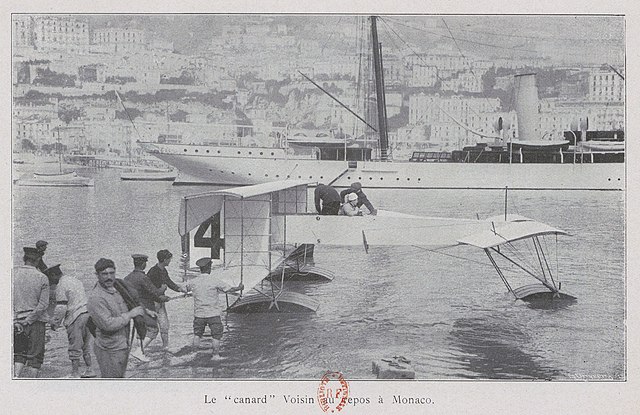
Voisin Canard, first model tested aboard Foudre, here in Monaco, 1911
In this, they defined maritime aviation, affirming the primacy of aviation over aerostation (airships) and envisioned already the construction of a ship, acting as mobile aviation base using a rail launch forward and a complete landing pad aft plus a hangar for housing aircraft. Boué de Lapeyrère was quite enthusiastic about this and added to this the construction of a coastal, naval aerodrome. Seven young naval interested officers were appointed to start lessons at the Aéro-Club de France, only authorized organization to issue certificates and licenses. This training too place from August 1910 to March 1911.

Foudre in 1914
The first trained pilot was Lieutenant Louis-Édouard Byasson. He was also, incidentally the world’s first death in naval aviation, crashing on April 14, 1911 aboard a Farman, during a test flight between Coignières and Rambouillet. By June 1911, Captain René Daveluy became commander of the first French seaplane carrier, the Cruiser Foudre, converted from an earlier unsuccessful torpedo boat mothership. On this ship, he carried out the first flight platform tests for a whelled aircraft, and was soon the organizer of maritime aeronautics in France, a full time occupation for the workaholic he was. He proposed to form an independent naval air unit to be based at Montpellier, then Fréjus in the south of France, and suggested to acquire for it three identified models, a coastal plane/seaplane (to be developed by a manufacturer), an “air cruiser”, with long range and heavy armament for antiship missions, and a Light carrier-based aircraft for the cruiser Foudre.

A Caudron floatplane is retrieved aboard.
Resigning at the end of December 1911, however, due to personal and professional reasons, Daveluy was replaced by frigate captain Louis Fatou. He pursued his efforts and created the maritime aviation service, obtaining a minuster decree on March 20, 1912. Thus enabled the creation of the first naval airbase at Fréjus-St Raphaël and complete the modification of the seaplane cruiser Foudre. He also provisioned the construction of flotilla buildings and flying equipment complete with workshops to serve the active airplanes, at that time a single land-based Maurice Farman biplane (from December 26, 1910) and a Canard Voisin seaplane from December 1911.

A view of the aft hangar
By June 1912, the latter boarded Foudre to start testings. The Voisin performed a dozen flights, piloted by Lieutenant Pierre Cayla. The cruiser at the time could only operate seaplanes, launched and recovered using cranes. Soon, a Nieuport VI monoplane was received and also tested from platforms, by the Chief of the Naval Staff Pierre Le Bris. He requested further transformations of Foudre to add larger decks for take off and landings. By November 1913 decision was taken to install a single platform forward, which took six months. Bureautratic inertia added to scepticism in the Navy’s top brass and did not favored the whole endeavour, ensuring France was relatively “late to the party” of naval aviation when WWI broke out.
Nevertheless, On May 8, 1914, René Caudron (founder and pilot of his own company) on a Type J succeeded in a first takeoff from the cruiser, landing apart, and on June 9, 1914, Lieutenant Jean de Laborde (future admiral) failed in attempt. After this test the Navy under a new minister decided to dismantled the Foudre’s platform and stopped all tests (at the same time the USN already performed landing and take-offs since 1912). By May 1914, still, Foudre shown what naval aviation can do, deploying 12 seaplanes equipped with wireless telegraphic posts for reconnaissance missions up to 200 km in the Mediterranean, either from the cruiser, or from Toulon and Bizerte in Tunisia, but further experiments of undercarriage models on the Foudre were interrupted by French Navy as war approached, giving priority to the seaplane.
22 pilots, including reserve and cadets constituted the early staff of French maritime by mid-1914, for 14 active pilots on their seaplanes. The General Staff of the Navy wanted a specialized service based in Paris, done by decree in July 10, 1914, the “maritime aeronautical service”. It included various aerostation centers across France, and a main aircraft squadron. At its head was a senior officer appointed by the Minister of the Navy, Captain Jean Noël from August 1, 1914. The war started and unfortunately, the Navy was given low priority while aircraft manufacturers in France were entirely committed to the Armée de L’air.
French Naval Aviation in WWI

Campinas

Nord (1915)
(In writing)
French Manufacturers
- Bleriot
- Caudron
- Breguet
- Dorand
- Farman
- FBA
- Hanriot
- Morane-Saulnier
- Nieuport
- Ponnier
- Salmson
- SPAD
- Voisin
- French ww1 Prototypes
- Zodiac Airships
The aviation pioneer
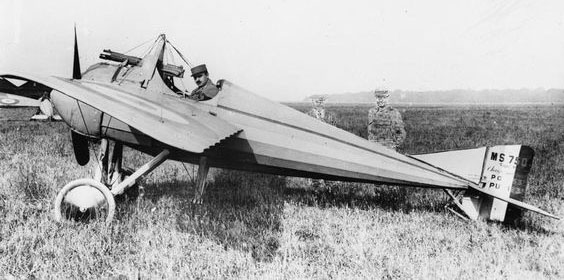 A pioneer of aviation, France was the first major nation to have operational squadrons (1912), under the command of the army. It was then reconnaissance devices short range (flight time of half an hour at most), derived from Blériot XI, the one that allowed Louis Blériot to cross the channel in 1911. French planes were then legion during the Balkan war, and bought or built under license all over the world. If Clerget was a renowned engine manufacturer, such as Le Rhône, the Gnome-Rhone rotating star engines soon became legendary and were built under license in very large quantities in the Allied camp.
A pioneer of aviation, France was the first major nation to have operational squadrons (1912), under the command of the army. It was then reconnaissance devices short range (flight time of half an hour at most), derived from Blériot XI, the one that allowed Louis Blériot to cross the channel in 1911. French planes were then legion during the Balkan war, and bought or built under license all over the world. If Clerget was a renowned engine manufacturer, such as Le Rhône, the Gnome-Rhone rotating star engines soon became legendary and were built under license in very large quantities in the Allied camp.
In 1914, France began with the largest air force of belligerents. The Nieuport 11 and Morane LA became the standard fighters in 1915, after more than a year of clashes between observation aircraft. The Nieuport 11 was even during this year 1915, the main allied fighter, operating under French colors, but also the RFC (future RAF), Italian, Russian, Belgian, Dutch… Main engine, France also ensured the biggest production aeronautics of the moment. In 1917, SPAD with its model VII allowed the Allied hunt to rebound against the excellent devices deployed by the axis. Its range was complete, including bombers (Farman, Caudron, Voisin), until Breguet 14, versatile and indestructible. It was in November 1918 with the largest air fleet in the world, as much potential for the
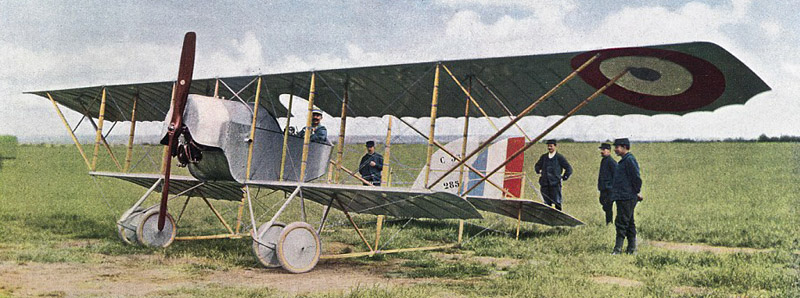
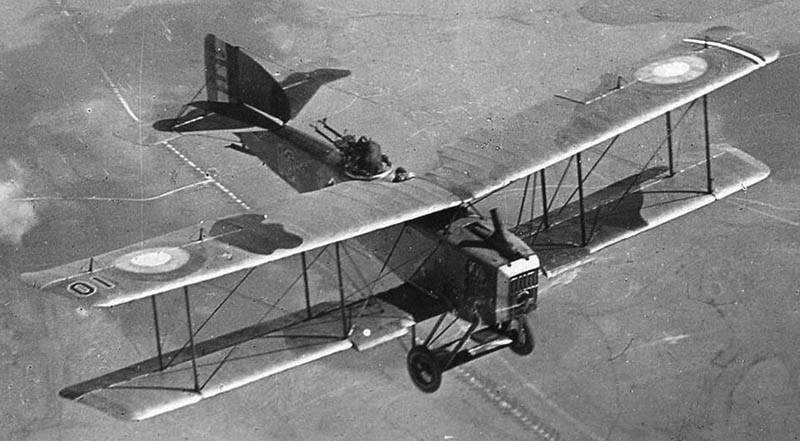
Blériot XI
Bleriot XI observation based near Ghent, Sept. 1914. Derived from the original Blériot crossing of the sleeve in 1911 and further improved, Bleriot XI Clerget engine was the main endowment of the observation units of the army. Unarmed, having a low autonomy of flight, the guidance was done by warping of the wings. Victim of the German Halberstadt monoplans, at the end of 1914, they were removed from the active units in favor of more efficient machines, and he passed to the instruction.
Dimensions: Wingspan: 10.8 m, Length 8.64 m, Height 3.3 m
Weight: empty: – Kgs. In charge: 240 Kgs.
Motorization: 1 Clerget of 50 hp
Performance: Vmax: 120 Km / h to 1000 m, ceiling 2 000 m, RA 60 Km.
Armament: none.
Breguet 14
Being one of the first aircraft of Louis Breguet, the model 14, which made its first flight in 1916, quickly made its mark thanks to its qualities the main light bomber and observation aircraft of the air force. It was produced in total at 5,000 units, and also equiped the Belgian and Italian aviation. Many were reconverted into passenger planes in 1919.
Dimensions: Wingspan: 10.8 m, Length 8.64 m, Height 3.3 m
Weight: empty: – Kgs. In load: 2896 Kgs.
Motorization: 1 BMW 560 of 860 hp
Performance: Vmax: 560 km / h to 4300 m, ceiling 11 000 m, RA 1200 Km.
Armament: 1 MG17 of 8 mm, 4 bombs 50 kgs.
Caudron G.III
Coming into service in mid-1915, the Caudron G.III became the most widespread of allied observation devices. Biputre, robust, and two-seater (but not armed), the G.III had sufficient autonomy to perform its mission properly and a low wing load due to a very large wing. Slow, he was also an easy prey for hunting and as a result was gradually withdrawn from the front line for schooling in 1916, notably replaced by his successor, G.VI.
Dimensions: Wingspan: 10.8 m, Length 8.64 m, Height 3.3 m
Weight: empty: – Kgs. In load: 2896 Kgs.
Motorization: 1 BMW 560 of 860 hp
Performance: Vmax: 560 km / h to 4300 m, ceiling 11 000 m, RA 1200 Km.
Armament: 4 bombs 10 kgs, or 8 rockets LePrieur contre-ballons.
Caudron G.VI
Replacing the G.III, the G.VI was in all points superior, with its full fuselage, its machine gun rear defense, its speed and its ability to ship some light bombs.
Dimensions: Wingspan: 10.8 m, Length 8.64 m, Height 3.3 m
Weight: empty: – Kgs. In load: 2896 Kgs.
Motorization: 1 BMW 560 of 860 hp
Performance: Vmax: 560 km / h to 4300 m, ceiling 11 000 m, RA 1200 Km.
Armament: 1 MG17 of 8 mm, 4 bombs 50 kgs.
Farman F.VII
Nicknamed “the rhino” or “Longhorn” by the English who also used it, the Farman F.VII was one of the first allied bombers, released in November 1914, it was widely produced. However, its performance and configuration allowed only high-risk missions. The gunner was not defending back then, but in the forward position, the pilot behind did not have an optimal field of vision. F.VII after a production of xxxx copies, were retired from service in 1916 for more recent versions and went to school.
Dimensions: Wingspan: 10.8 m, Length 8.64 m, Height 3.3 m
Weight: empty: – Kgs. In load: 2896 Kgs.
Motorization: 1 BMW 560 of 860 hp
Performance: Vmax: 560 km / h to 4300 m, ceiling 11 000 m, RA 1200 Km.
Armament: 1 Darne machine gun of 7.7 mm, 8 bombs 10 kgs.
Farman F.40
The newest member of the Farman Bomber family, the F.40 was faster and more maneuverable, but kept its front firing position. Its bomb load was modest, but many of these devices were used as a heavy fighter and against the German observation balloons, the “sausages”.
Dimensions: Wingspan: 10.8 m, Length 8.64 m, Height 3.3 m
Weight: empty: – Kgs. In load: 2896 Kgs.
Motorization: 1 BMW 560 of 860 hp
Performance: Vmax: 560 km / h to 4300 m, ceiling 11 000 m, RA 1200 Km.
Weaponry: 1 Darne machine gun of 7.7 mm, 10 bombs 10 kgs, or 10 rockets the Prior.
Hanriot HD1
Solid and easy to handle, the HD.1 hanriot was a new version of the Nieuport XXVIII, more stocky and light, and therefore faster. Excellent, he gave back to the Belgians and French a superiority that the rotary engines had lost against the “Hispanists” online SPAD. About 300 copies were made the day before the signing of the armistice.
 FRENCH AIRCRAFT OF THE FIRST WORLD WAR © IWM (Q 66290)
FRENCH AIRCRAFT OF THE FIRST WORLD WAR © IWM (Q 66290)
Dimensions: Wingspan: 10.8 m, Length 8.64 m, Height 3.3 m
Weight: empty: – Kgs. In charge: 396 Kgs.
Motorization: 1 Gnome-Rhône of 120 hp
Performance: Vmax: 560 km / h to 4300 m, ceiling 11 000 m, RA 1200 Km.
Armament: 1 MG17 of 8 mm, 4 bombs 50 kgs.
Morane 21
This aircraft, which made its first flight in June 1916 became one of the most prolific observation aircraft of the French army. He was the successor to Morane LA’s renowned fighter/recce aircraft. Thanks to its parasol wing, the observer had a clear field. A rear defending machine gun was fitted in 1917.
Dimensions: Wingspan: 10.8 m, Length 8.64 m, Height 3.3 m
Weight: empty: – Kgs. In load: 2896 Kgs.
Motorization: 1 BMW 560 of 860 hp
Performance: Vmax: 560 km / h to 4300 m, ceiling 11 000 m, RA 1200 Km.
Armament: 1 Lewis machine gun of 7.7 mm.
Nieuport X
This small ultra-light fighter, designed on the ground like an observation plane armed by Gustave Delage, sesquiplan (double upper plane) and V-shaped spacers, became with its rotary engine The Rhone the main allied fighter, used by the British , Belgians, Italians, Russians. Because of its tiny size, it was nicknamed by the British “Baby Nieuport”. In the absence of sufficiently reliable machine guns, a Lewis implanted on the upper wing was used, forcing the pilot to stand up (and hold the neck between the knees) to use his weapon.
Dimensions: Wingspan: 10.8 m, Length 8.64 m, Height 3.3 m
Weight: empty: – Kgs. In charge: 396 Kgs.
Motorization: 1 Gnome-Rhône of 120 hp
Performance: Vmax: 560 km / h to 4300 m, ceiling 11 000 m, RA 1200 Km.
Armament: 1 Lewis machine gun of 7.7 mm.
Nieuport XI/XII
Succeeding the tiny Nieuport “baby”, the Nieuport XI was (like the XII, its improved version) the most prolific of the French hunters during the year 1916. Very handy and provided with a very reliable engine, the Rotary Rhone XX, it was produced quickly in a large number of copies, and widely used abroad, for lack of local productions. He had some recurve spoiler faults that penalized him and the low power of his engine did not allow to take advantage of the lift of his upper plane combined with the low drag of his lower plane.
He was considered the best allied fighter this year, but soon the Germans with their Albatros D.III and Fokker D.I, D.II, LFG Roland dominated him for lack of machine guns synchonized. The colorful “circus” of Richtofen pushed Nieuport to design a more modern apparatus and the British to design the Sopwith Pup.
Dimensions: Wingspan: 10.8 m, Length 8.64 m, Height 3.3 m
Weight: empty: – Kgs. In charge: 396 Kgs.
Motorization: 1 Gnome-Rhône of 120 hp
Performance: Vmax: 560 km / h to 4300 m, ceiling 11 000 m, RA 1200 Km.
Armament: 1 Lewis machine gun of 7.7 mm.
Nieuport XVII/XXVII
Taking the succession of the small Nieuport 11, the Nieuport 17 settled the rigidity problem of the single spar of the lower wing, and inaugurated the engine Le Rhône of 113 hp, which gave him the expected performances. However, he kept his Lewis machine gun mounted on the upper wing. He helped to counter, with the Airco DH.2 of the RFC also released in May 1916, the “flail fokker”. Quickly the wing gun was doubled or replaced by a hood machine gun. The XXVII version had this “standard” configuration and most of the great allies of 1916 gained their victories on this device.
Dimensions: Wingspan: 8,20 m, Length 5,75 m, Height 2,3 m
Weight: empty: 375 Kgs. In charge: 560 Kgs.
Motorization: 1 Gnome-Rhône of 133 hp
Performances: Vmax: 172 Km / h to 2000 m, ceiling 5300 m, RA 200 Km.
Armament: 1/2 Lewis machine gun 7.7 mm.
Nieuport XXVIII
The Nieuport XXVIII was directly extrapolated from the N.XXVII, but it was a break with the previous series, with many differences, starting with the much larger (but still sesquiplan principle) lower plane and H-shaped spacers, a fuselage longer and better profiled, and a new Gnome engine of 160 hp. He finally had “serial” two hood machine guns. The French pilots who obtained it from the end of 1917 complained of the fragility of its superior interlining and its sometimes recalcitrant engines (The Rhone and Gnome Monosoupape were also tested.).
When the volunteers of the American Expeditionary Force arrived in France, they were given these devices in majority, but it was on SPAD XII that they won their victories.
Dimensions: Wingspan: 8,20 m, Length 5,75 m, Height 2,3 m
Weight: empty: 375 Kgs. In charge: 560 Kgs.
Motorization: 1 Gnome-Rhône of 133 hp
Performance: Vmax: 172 km / h to 2000 m, ceiling 5300
Spad VII
SPAD, the new name of Deperdussin, designed this fast-moving fighter in Allied aviation. The reason was the combination of the powerful water-cooled Hispano-Suiza Marc Birkgit V8, initially 150 hp and then 220 hp, which gave the aircraft’s robustness and profiling excellent performance. He made his initial flight in April 1916 and therefore gradually and rapidly ended the German supremacy on the Northern Front. A squadron among others became legendary: The Spa 3 (“the storks”) led by Alfred Heurtaux, including René Dorme, Albert deullin, and George Guynemer. 5000 copies were made until 1918.
Dimensions: Wingspan: 7,80 m, Length 6,15 m, Height 2,12 m
Weight: empty: 510 Kgs. In charge: 740 Kgs.
Motorization: 1 hispano-Suiza 8A of 150 hp
Performance: Vmax: 192 km / h at 2000 m, ceiling 5300 m, RA 220 km.
Armament: 1/2 Lewis machine gun 7.7 mm (the second on the upper wing).
Spad XIII
Designed on the basis of the S.VII, and appeared in August 1917, the S.XII retained most of it, but traded its old standard engine by the 220 hp V8 A8Ba already seen on the latest versions of the S.VII. He also had reworked wing details and a larger rear wing. Even more powerful, although criticized for his lack of visibility under the upper wing, he also had two synchronized machine guns hood. It was on this aircraft that Guynemer died in Belgium in September 1917, but also that René Fonck acquired the majority of his victories. This aircraft, in addition to equipping the 81 French squadrons active on the North Front, also had many Italian and Belgian squadrons, two squadrons of the RFC and most Aero squadrons Americans. It was on these machines that Rickenbaker and Luke gained their victories and made america aware of the importance of an air force.
Dimensions: Wingspan: 7,80 m, Length 6,15 m, Height 2,12 m
Weight: empty: 565 Kgs. In charge: 820 Kgs.
Motorization: 1 hispano-Suiza 8B of 220 hp
Performance: Vmax: 215 km / h at 2000 m, ceiling 6650 m, RA 200 km.
Armament: 2 x 7.7 mm Lewis machine gun.
Voisin V
Voisin produced most of the heavy aircraft of the French Air Force, mostly bombers, but some were used as heavy fighters, as is the case for this one, often these aviations had Le Prieur rockets. Equipped with a propulsive engine, with a front post equipped with a Lewis machine gun, it was however not maneuverable enough to accumulate victories.
Dimensions: Wingspan: 7,80 m, Length 6,15 m, Height 2,12 m
Weight: empty: 510 Kgs. In charge: 740 Kgs.
Motorization: 1 hispano-Suiza 8A of 150 hp
Performance: Vmax: 192 km / h at 2000 m, ceiling 5300 m, RA 220 km.
Armament: 1/2 Lewis machine gun 7.7 mm (the second on the upper wing).
Voisin VIII
Dimensions: Wingspan: 7,80 m, Length 6,15 m, Height 2,12 m
Weight: empty: 510 Kgs. In charge: 740 Kgs.
Motorization: 1 hispano-Suiza 8A of 150 hp
Performance: Vmax: 192 km / h at 2000 m, ceiling 5300 m, RA 220 km.
Armament: 1/2 Lewis machine gun 7.7 mm (the second on the upper wing).
 French Prototypes & small manufacturers
French Prototypes & small manufacturers
ANF Les Muraux (1918)
Although the Mureaux lineage really started in 1924 with the 1 C.1 Express-Marin naval fighter, the company was funded as Ateliers de Construction du Nord de la France et des Mureaux in 1918 and started immediately after the war to produce Vickers Vimys and Breguet 14s under licence before turning to parasol fighter designed by André Brunet.
Still to come: Borel-Odier Bo-T (1916, 92 built) https://en.wikipedia.org/wiki/Borel-Odier_Bo-T
Coutant RMC Type 17 (1917, http://francois.delboca.free.fr/port/fscoutan.html)
Antoinette (1906)
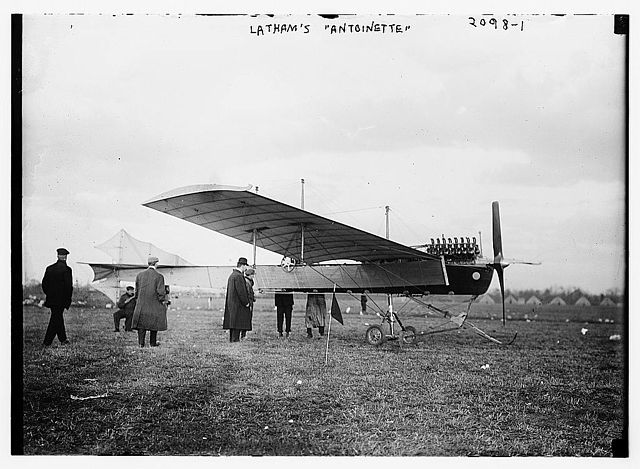
Forever associated to the names of Blériot, Latham and Levavasseur, the name Antoinette stuck with aviation early history.
Belonging to the great aviation pioneers, the company started as a private venture and idea by engineer Léon Levavasseur and Jules Gastambide, which funded it in 1902. When the company was formally created in 1906, Aviation pioneer Louis Blériot joined in as the vice-president, brining more credibility and renown to the enterprise. It started with the first Antoinette (which never flown) but received an innovative engine, based on an automobile 7.2 L (439 cu in), 32 horsepower (24 kW) V8 engine. The engine found its way later in the Santos-Dumont 14-bis of 1906. A Farman-Voisin biplane was then powered by a water-cooled Antoinette V8, rated for 50 horsepower (37 kW). It was a brillant engine, tailored to weight only 190 pounds. The Antoinette II flew in 1908 and was also known as the Gastambide-Mengin II. In addition to light materials like aluminium casting, the engine showcased a direct fuel injection and evaporative engine cooling systems. Captain Ferber purchased the first Antoinette complete plane, or Antoinette III in 1908, and the same year, the model IV went out, as a one-seat monoplane with aft-mounted aileron surfaces. The model V at the end of the year had wing warping instead of ailerons.
Antoinette military monoplane (1911), one of the first to integrate spats to reduce drag and get rid of wiring. It was totally underpowered.
By that time, Blériot had advocated the company not to turn to aicraft production but to stay in engine business. Despite of this, the team moved to French Army Camp Châlons, near Mourmelon-le-Grand, until now still a major training and testing ground of the French Army. There a flying school and a workshop were setup and the company even created perhaps the world’s first flight simulator, the “Antoinette trainer”. Hubert Latham became one of the first to be instructed there, and later took the head of the instruction team. Some of his famous pupils included Marie Marvingt (the first woman to fly combat missions as a bomber pilot and to create the flying ambulance during the war) and Infante Alfonso, Duke of Galliera, cousin of King Alfonso XIII of Spain, the first Spanish pilot. By 1909 Lathamwas convince to try the Daily Mail prize by crossing the Channel with an Antoinette, but failed, whereas Blériot won. But Latham would win the Gordon Bennett Cup and rank well in many other events. This year three new versions of the Antoinette appeared, one with true ailerons (later converted to wing warping), and two with a larger engine and wing warping. Levavasseur however left the Antoinette company but returned in 1911 and created the only Military plane the company ever did, called the Antoinette military monoplane. Also called the Antoinette Monobloc it was a private venture expected to bring orders from the French military. It featured some aerodynamic refinements like cantilever wings, no bracing wiring and spats to enclose the landing gear. Too heavy for its 37 kW (50 hp) engine the plane neever really flew, but was exhibited at the 1911 Concours Militaire at Reims.
Amiot (1916)
The name would be forever associated with the lineage of bombers manufactured prior to WW2 and which saw service in large quantities during the battle of France, like the 1931 Amiot 143 night bomber and the 1940 very modern and fast Amiot 354. But it all started with Félix Amiot’s creating his own first aircraft in a Paris garage in 1913. Only in 1916, with financial backing, he setup a company called the SECM (Société d’emboutissage et de constructions mécaniques) funded by Paul and Pierre Wertheimer associated with Félix Amiot as chief designer. But both SECM and Amiot worked as sub-contractors and assemblers for other planes, and no custom model went off this enteprise. Only in 1928 the company started to produce a proper aicraft, the Amiot 110, a parasol prototype designed by M. Detartre for the “Jockey” contest.
Astra
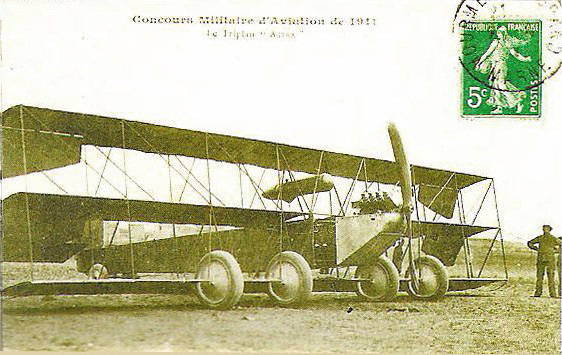
Adolphe Clément-Bayard came from the cyclecar industry, but became a manufacturer of dirigibles under the name of Clement-Bayard (1908). Five infaltable models were built, one for Russia in 1913 and the last one (Montgolfier) the same year, like all the previous ones, for private use. Astra was also the name for another linked company founded in 1908 when Henri Deutsch de la Meurthe purchased Édouard Surcouf’s workshops at Billancourt. Until 1912, the company produced Wright models under licence, then went into its own models, the Astra C, a Sports plane and observation aircraft and its military version, the Astra CM and its hydroplane version, called Astra CM Hydro-avion. Both planes did see service for military reconnaissance in 1914. The company also produced an impressive triplane bomber also in 1912 for the military aviation contest. It had a single engine and four wheels encased in the lower wings, along an integrated undecarriage. Also the company spawn a succesful wartime branch called Astra-Torres and producing non-rigid airships designed by Spanish engineer Leonardo Torres Quevedo. His dirigibles had a particular tri-lobed cross-section and were quite successful, steered by gondola fore-and-aft. The serie went through WW1 as the AT series (AT-1 to AT-19) and three were later bught by the American Experidtionary Force while three others were purchased by the Royal Navy and became the HMA No.3, HMA No.8, and HMA No.16. Japan also purchased after the war the AT-2, in service until 1924. In 1921, Astra was absorbed by Nieuport.
Triplan Astoux-Vedrines (1916)

A prototype, the Astoux-Vedrines triplane was invented by famous pilot Jules Védrines associated to the Morane-Borel monoplane. He previously worked with the Usines Gnôme, and served during the War, managing to set up the Société de Constructions aéronautiques Jules Védrines et Cie (Simplified as “Aéroplanes Védrines”) near Paris. He was involved in the prime idea of the triplane, designed by the French engineer Louis-León Astoux. They would file at least three patents related to this triplane: Improvements in or relating to Wing Systems for Aeroplanes, Improvements in or relating to the Construction of Aeroplane Fuselages and Landing wheels of aeroplanes. It was propelled by a 130 hp clerget, had a streamlined fuselage of round section, possibly made in plywood; Its main characteristic was that the incidence of the wings could be varied in flight. The triplane was flight-tested in August 1916 by Védrines himself, but later destroyed by another pilot named Simon, and never rebuilt. Source: French aircraft of ww1 de Davilla et Soltan.
The prototype Védrines-Astoux tested at least in July and September 1916 at Etampes-Villesauvage aerodrome and had references known in at least two books, Soltan-Davilla, for the story of the tests recorded and Belgian pilot pupil Carlo Verbessem photos at the Epi Mûr field. In his memoirs Belgian Top ace Willy Coppens recalled it, as Villesauvage was the training center for Belgian pilots. A probably unique photo and knowledge of documents from the SHD Air introduces a doubt in the the different photos of the plane, by Carlo Verbessem showing the Védrines-Astoux triplane before his trial by Védrines, and after his landing, on August 31, 1916 in Villesauvage. Verbessen’s fourth photo showed the plane damaged and in need of repairs, but which corroborate the later abandonment of the project. A new flight test is done on September 16th, again according to Verbessem, but the triplane crashed, killing pilot Simon (3 other photos). Apparently in early 1917 Fernand Vigouroux at the SFA also flew the plane (as shown by SHD Air archives).
Audenis C.2 (1916)
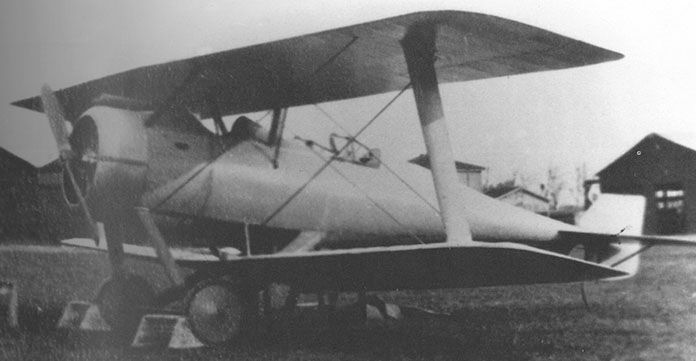
This orthodox tractor biplane, apparently of excellent qualities was designed as two-seat fighter escort, also named Audenis-Jacob fighter. This was the result of Charles Audenis (born 6 October 1889 at Lyon) breveted pilot on 9 March 1912 and soon in the Aviation Militaire. Late 1916, he left the Aviation Militaire to work on the design of a new aircraft, co-designed by Jean Jacob, possibly built at Barron-Vialle, a luxury coachmaker. Most of it came from a French magazine article from 1928. According to this, the Audenis had a 130 hp Clerget engine, giving it a speed of 180 kph. It had a front single cowl-mounted machine-gun, and a second light MG ring-mounted on the observer’s cockpit. It was tested, but not accepted by the Aviation Militaire. Audenis after this failure went back to his squadron in June 1917. The fate of the prototype is unknown.
B.A.J. IVC.2 (1918)
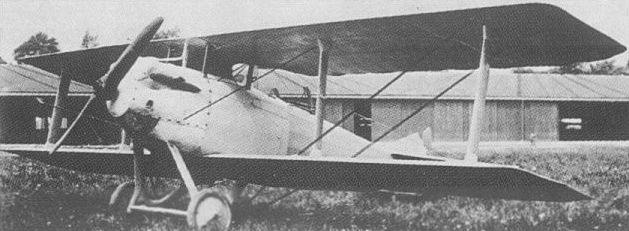
This pair of prototypes were known as the Boncourt-Audenis-Jacob Type IV. A French two-seat fighter, equal-span two-bay biplane powered by a 300 hp (224 kW) Hispano-Suiza 8Fb inline piston engine, it was designed and built by Boncourt-Audenis-Jacob at Bron. It was fitted with a synchronised forward firing Vickers machine-gun while the observer had a ring-mounted twin Lewis Gun, a powerful combination for an escort fighter. It was was ordered by the French government in May 1918, designated IVC.2. It first flew in November at Villacoublay, and the official tests went well. The prototype returned to Bron for some repairs, and was soon replaced by a second prototype, experiencing fire in late 1918 at Bron, soon abandoned.
Bernard AB 1 (1918)
From Société des Avions Bernard established in April 1917 by Adolphe Bernard first as Etablissements Adolphe Bernard, it began with SPADs under licence, to government contracts. This gave the young company some expertise to launch its first original design, a twin engine biplane bomber able to deliver 600 kg (1,323 lb) of bombs. The structure wa made in plywood, three bay without stagger, and sesquiplane (greater upper span). The lower wings carried dihedral while the outer, mid interplane struts were leaning outward, while but the inner bay was was linked by a complex of struts which supported both engines midway. These struts had a V, M and W arrangements above and below each engine. These were Hispano-Suiza V-8 piston engines (already known by the company with the SPADs), surplus after the Armistice. Both wings had ailerons externally connected, and the fuselage was flat-sided with a narrow, flat top deck. The gunner sat in the nose with a with a 7.7 mm machine gun on a TO 4 mounting. The cantilever tailplane had separate elevators on top. The fin had a horn-balanced rudder extended downwards between the elevators, under the fuselage. The main undercarriage had a wide track with wheels on short axles below each engine. The AB 1 prototype was built in 1918 and flew before the end of the year (and the war). Plans already were made for a variant with Hispano-Suiza 8Ba engines called AB 2 and civilian postwar variants AB 3 and AB 4 (The latter carried seven passengers) in 1919. The AB.1 was flown and approved by the military hierarchy for pre-production, cut short after the war ended to just ten planes, which were ready before the end of the war, but never had time to become operational. They were integrated later in the French Air Force for testings.
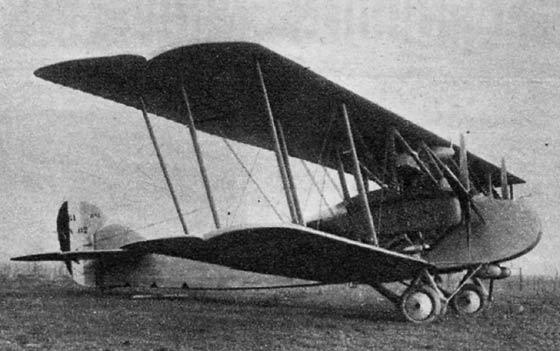
Bernard AB-1 1918. (Credits aviafrance.fr)
After the war ended, the company was became Société Industrielle des Métaux et du Bois (“SIMB”) or “Industrial Company for metal and wood” to cover wider product needs in the interwar. With proper financial backing, the company return to aircraft business by 1922, and an aircraft division was created, headed by Jean Hubert as chief designer. But Bernard models were not that successful on the commercial market and like so many others, it went bankrupt in 1927. The company resurfaced again as Société des Avions Bernard to create a few airliners for CIDNA, the Bernard 190 of which fourteen were built, the largest Bernard production so far. Indeed, despite having turned out 34 models, most had a single to three “production” rate. By 1935 the company acquired Hydravions Louis Schreck FBA before being nationalised and assimilated to other groups in 1935.
Borel
Borel hydro-Monoplane used by the Brazilian Navy (1911)
The company Etablissements Borel was funded in 1909 by Gabriel Borel to manufacture a serie of monoplanes, for sport and private owners. It was located at Mourmelon (a military camp) but was forced to close its doors when the War broke out. Most of its workers indeed conscripted into the army. By 1915 however his experience and state’s funding resurrected the company, to produced complete licenced aircrafts, from manufacturers such as Caudron, Nieuport and SPAD. Models produced by Borel before the war included the:
- Morane-Borel monoplane 1911 (c200)
- Borel hydro-monoplane 1911 (c150)
- Borel Bo.11 1911 (c50)
- Borel military monoplane 1913
- Borel Torpille 1913
- Borel-Odier Bo-T 1916 (92)
The Morane-Borel was a mid-wing tractor configuration monoplane powered by a 50 hp Gnome Omega seven-cylinder rotary engine. It was used not by France but instead exported and used by the Argentine Air Force, Brazilian Naval Aviation, Royal Romanian Air Force and Royal Naval Air Service. The derivative Borel Hydro-monoplane had two floats and were quite successful, also exported widely, used by the Italian Corpo Aeronautico Militare, Royal Naval Air Service and Royal Flying Corps, Brazilian Naval Aviationand the Military Police of Paraná State. The Borel Bo.11 was another 1911 two-seat general purpose monoplane fitted with wire-braced wings and wing warping. These were powered by a 52 kW (70 hp) Gnome rotary piston engine, and were used by the Aéronautique Militaire at military air training schools and at a civil flying school at Buc. Production records are unknown.
The so-called “Military Monoplane” was a tailored-built 1913 two-seat monoplane with an unconventional design as the pilot and observer sat side by side in an open cockpit. They sat in a pod with downwards windows for observation, carrying a single, two-bays wing mounted above, and the engine in a pusher configuration. The plane was designed to hunt balloons. It also had a cruciform empennage and the end of a triangular cross-section. It was tested, had good flying characteristics but the idea was later dropped and the plane stayed a prototype. The Borel Torpille was an advanced monoplane design with wire-braced wing attached to a monocoque fuselage, very streamlined like a torpedo, hence the name, and mated with a tractor 50 hp rotary engine. Despite its speed, it stayed as a prototype; The Borel-Odier torpedo floatplane (B.O.2) was a 1916, mass-produced model designed when the company was reactivated, by Antoine Odier for the French Navy. This biplane was powered by two 164 kW (220 hp) Hispano-Suiza 8Ba inline engines and twin floats. These were torpedo-carriers, order to 91 aircraft despite the prototype was destroyed by fire in August 1916. Deliveries start in mid-1917 and went on until the Armistice, which for some served for coastal patrols in the mediterranean.
Coandă-1910
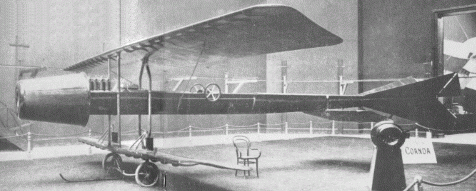
Probably the most amazing plane of this lot, which unfortunately saw no production nor service in WW1, the Coanda C.1 would have been the world’s first fighter jet…
Now made famous thanks to internet, but in the past only known by die-hard aviation fans, the plane made by Romanian engineer and designer predated no less than forty years of aviation advancement. Simply known as Coandă-1910 because it was showcased in the 1910 Paris exhibition, this was the culmination of years of theoretical researched and testings. The Coanda was indeed jet-propelled. A sesquiplane aircraft powered by a ducted fan, called the “turbo-propulseur” by Coandă, that claimed a single brief flight in 16 December 1910, but his plane crashed just after takeoff and burned completely. This fight is still debated today by historians. But the Coanda plane fell from public awareness, until resurrected by the centennial of jet aircraft, celebrated in Romania in 2010. The name and the plane made a return to the medias and triggered the construction of a flying replica to demonstrate it was indeed able to fly.
Henri Coandă was born in Romania, Bucarest and started achieving reactive propelled flight as early as 1905 with rockets, when young. He also worked in secret in Germany at Spandau, flying successfully a plane with a single tractor propeller plus two counter-rotating propellers driven by the same 50 hp Antoinette engine. Accoridng to some sources this plane was flown at Cassel, showned to Bernhard von Bülow. In December 1907 he demonstrated an early jet turbine at the Sporthalle indoor sports arena in Berlin. While resuming his studies at Liege, Belgium, he teamed with Caproni (then his roommate) to produce a box-kite, and became in 1909 technical director of the Liège-Spa Aeroclub. In 109 he move to Paris’ École supérieure d’aéronautique et de constructions mécaniques and then met Ernest Archdeacon, co-founder of L’Aero-Club de France, which network of financial supports helped him financing his own studies, like industrialist Gustav Eiffel and politician and mathematician Paul Painlevé. He made tests of air penetration on a modified locomotive and obtained his pilot licence. He also worked on a slender sesquiplane and turbine in a workshop setup in the courtyard of his house. First tests published in April 1910 edition of La Technique Aéronautique were followed by patents. His unusual plane was displayed in a separate area of the Paris Salon from 15 October to 2 November 1910, just like Fabre’s first hydroplane.
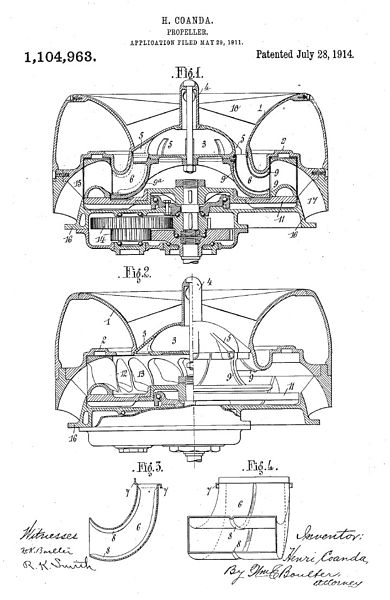 The two cantilever wings solved lateral stability control issues, and were attached to the fuselage by the way of tubular steel struts, without any bracing which was also a feat and lowered drag. The tail were controlled by two large Antoinette VII-style steering wheels mounted outside of the cockpit. They served both for pitch and lateral control, as ruddervators. The large gap between wings allowed the open-air pilot to have a good overall visibility, compounded bu the absence of propeller at the front.
The two cantilever wings solved lateral stability control issues, and were attached to the fuselage by the way of tubular steel struts, without any bracing which was also a feat and lowered drag. The tail were controlled by two large Antoinette VII-style steering wheels mounted outside of the cockpit. They served both for pitch and lateral control, as ruddervators. The large gap between wings allowed the open-air pilot to have a good overall visibility, compounded bu the absence of propeller at the front.
Because of course the major innovation of this model was its 50 hp (37 kW) inline water-cooled internal combustion engine by Clerget at Clément-Bayard workshop,tailored for Coanda and financed by L’Aero-Club de France. It was driving a rotary compressor through a 1:4 gearbox (from 1,000 rpm to 4,000 rpm), drawing air in, and compress it with added heat. The 50 cm (20 inches) compressor had a well-profiled bucket-like cowling and the while powerplant counted many cast aluminium components making a final power-to-ration of 1.8 kg per kilowatt (2.9 lb/hp) 0.59 kilowatts per kilogram (0.36 hp/lb) equivalent, unheared of at the time. His “turbo-propulseur” was claimed to generate 2.20 kilonewtons (220 kgf; 490 lbf) of thrust, and baffled specialist of aviation engines at the time, which had several terms to describe it.
Writers of the time were highly dubious this engine could produce the sufficient thrust, possibly also because of the limited size of the compressor and air intake. The plane moved after the exhibition to Clément-Bayard workshop at Issy-les-Moulineaux for further testing, and there are still mystery about these to ever took place; According to modern-day Romanian investigators led by Dan Antoniu careful examination of photographs, the photos shown a different engine, hybrid, than the one shown in the patents. Also Gérard Hartmann in his Dossiers historiques et techniques aéronautique française estimated the powerplant would have to generate at least 7000 rpm to lift the plane, well beyond the resistance of the materials used.
The French state ordered none of this projects and in 1911, Coaand then in debt, moved to the invitation of Sir George White, to take a position as chief engineer or chief designer at the British and Colonial Aeroplane Company. The man also worked on a great variety of inventions in the interwar and was invited in 1942 by Germany to develop turbo-propulseur propelled skids ambulances for winter operations on the Eastern front, knowing about his jet-propelled sledge designed for Grand Duke Cyril of Russia in 1910.
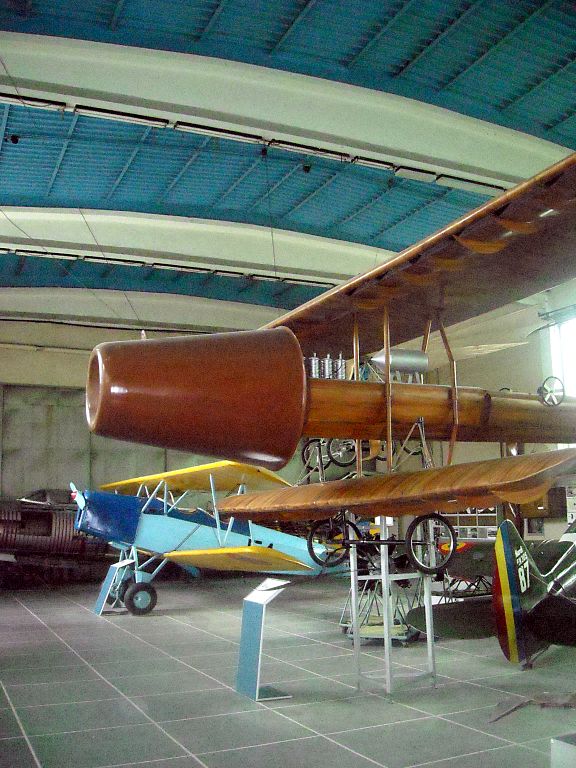
Replica of the 1910 Coanda at Bucarest.
Courtois-Suffit Lescop CSL1 (1918)

CSL 1 fitted with a 160 hp Gnome for testing in January 1918. It was the first equipped with leading edge wings flaps.
This short-lived association with builder SAIB (Societe Anonyme d’Applications Industrielles du Bois) made a fighter just before the end of the war. It was Designed by Roger Courtois-Suffit, in collaboration with Captain Lescop, an experienced pilot. This single-seat biplane of conventional design first flew in January 1918. It was one of the first aircraft featuring leading edge wing flaps, hinged, fitted to the lower planes. This fighter was designed to be fitted with a 200 hp Clerget 11E eleven-cylinder rotary engine. The backup plan included an older 160 hp Gnome Monosoupape 9Nc nine-cylinder rotary engine; But in the end for trials, CSL 1 was given a 140 hp Clerget 9Bf nine-cylinder rotary engine. The second 200 hp prototype was apparently never completed. Despite its qualities (and perhaps because of its cost), the plane was never ordered by the military.
De Bruyère C 1 (1917)
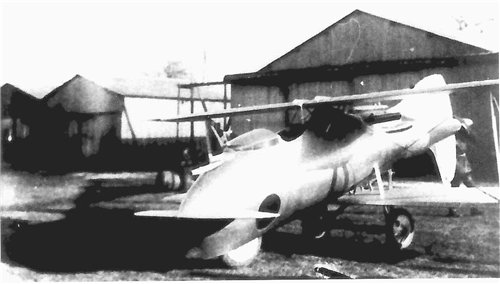
This very unusual plane was designed as a pusher with canards.
This very unorthodox plane, designed as a pusher whereas more fighters were tractors, was developed by Marcel de Bruyere. It was a single-bay biplane with staggered equal-span wings and inverted V-struts. Its most amazing feature was an all-moving canard for controlled pitch, roll control and full chord tip ailerons on the upper wing. It was propelled by a 150 hp Hispano-Suiza 8Aa water-cooled engine, mounted aft of the wings, and which drove a two-blade pusher propeller through a long shaft at the tail. There was a ventral fin with and tail skid to protect the propeller, and short vertical stabilizer over the tail, but no fixed horizontal stabilizer (canards at the nose instead). Therefore this model also used a tricycle landing gear. It was also highly aerodynamic, with a very advanced all-metal fuselage. This configuration allowed the pilot an unrestricted field of fire, helped further by two large windows downward on each side, and on top of that a single 37mm cannon for armament. Needless to say this fighter was a considerable leap forward in design, but after it made in April 1917 its flight test at Farman Aviation Works and Blériot Aéronautique in Étampes, it reached about 25 feet in the air before entering a fatal roll and crash-landed. Although the pilot survived, the very unusual configuration did not helped to restore confidence and the development was cancelled. Let’s remind that this configuration had to wait for the 1940s to have a go again and is still considered very advanced today.
Deperdussin TT (1912)
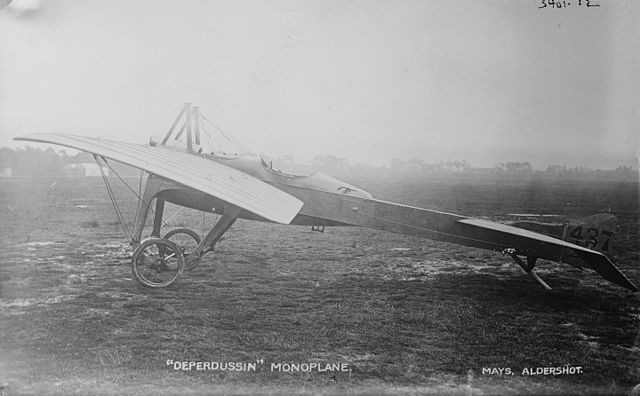
This very unusual plane was designed as a pusher with canards.
The most famous military monoplane before the war, was this model, which together with the Morane, were widely copied an largely exported round the world. Deperdussin will be transformed later into SPAD in 1913. The TT was made by Société Pour les Appareils Deperdussin, as a monoplane derived from a serie of private planes started in 1908, and was designed for the military as a trainer and reconnaissance aircraft. It had a crew of two sat in open cockpits in tandem, a length of 7.92 m (26 ft), wingspan of 10.97 m (36 ft) and height of 2.69 m (8 ft 10 in), for a gross weight of 725 kg (1664 lb). It was propelled by a Gnome Rotary, 60 kW (80 hp), enough to reach a top speed of 114 km/h (71 mph) and have and endurance of 2 hours 20 min at cruise speed (about 90 kph). Steering used wing warping.
The TT was widely used by the French Military (already making several squadrons in 1913), and other nations: The Belgian Air Force, Paraguayan, Portuguese, Russian, Serbian, Spanish, Ottoman Air Forces also used it before or during WW1 as well as United Kingdom, with the Royal Flying Corps No. 3 Squadron RFC and also the Royal Naval Air Service in 1914. Totally obsolete by mid-1914 it was gradually replaced. Another very famous model from Deperdussin was the monocoque, an early racing aircraft built in 1912 with a rigid, streamlined fuselage and won the Gordon Bennett Trophy in 1912 and 1913, raising the world speed record for aircraft to 130 mph (210 km/h). It was designed by a Swiss marine engineer and derived from 1911 Louis Béchereau’s racer. This plane was famous to feature outer surface of the structure that were load-bearing instead of the usual braced box-girder covered in fabric technic. The fuselage external shell was made of layers of tulipwood, while internal spars were made of hickory and ash, and ribs made of pine, the entire fuselage being halved and glued together; This were very advanced construction techniques but were deemed too costly for mass-production. This small model also used a cowl and nose spinner and was propelled by a Gnome Lambda Lambda air cooled 14-cylinder two-row rotary, 120 kW (160 hp), almost twice as powerful as the TT. It would have made an outsanding fighter in 1914, but the Military by then only considered the use of airplanes for reconnaissance. These skills to produce very fast planes was translated later in to the SPAD fighters DNA.
Descamps 27 (1919)
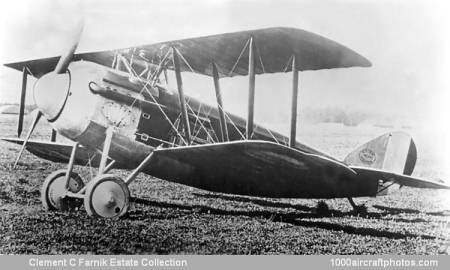
Descamps 27, Clement Farnik coll.
This biplane fighter is only cited there because work on the design started before the end of the war. It was made by enineer Descamps as a two bay biplane with same constant chord wings, same spans, balanced ailerons on the lower wing, forward stagger, and forward-leaning interplane struts. The lower wing had about 7° of forward sweep. The pilot’s cockpit under the trailing edge had a shallow cut-out in the top wing to improve upward view and It was given a pair of synchronised 7.7 mm (0.303 in) machine guns. Its tailplane was small compared with the balanced elevators as the fin compared with the rudder. The Descamps fighter was propelled by a 220 kW (300 hp) Hispano-Suiza 8Fb water-cooled V-8 engine, for 230 km/h (143 mph; 124 kn) top speed at sea level, 172 km/h (107 mph) at 7,000 m (23,000 ft). The latter was cowled in a well profiled nose and domed spinner. This plane first flew at the beginning of 1919 but failed to attact orders against the Nieuport 29.
Donnet-Denhaut Planes

Donnet-Denhaut DD.8 floatplane (1917)
Although later best known for its automobiles, the company Donnet was first funded in 1914 by Jérôme Donnet (formerly of Donnet-Lévêque) and François Denhaut at Neuilly-sur-Seine. The company designed and built a successful line of patrol flying boats for the French Navy. The Donnet-Denhaut DD series were maritime patrol and ASW aircraft produced to around 1085 planes through the DD.2, 8, 9 and 10 models. These sesquiplane pusher, two-bay unstaggered wings flying boats, were designated retrospectively to reflect design changes over the years and configurations during their service.
Their rotary engine was mounted on struts in between the wings and after being tested in 1915, The French Navy ordered 90 DD-2 planes. By 1917, theyr requested the company to redesign the model to be fitted with the more powerful and modern Hispano-Suiza 8. 365 more were therefore ordered with an increased wingspan, adding a third bay to the wing cellule. The additional lift helped to manage a seat for a second gunner. This model became later the DD-8, the most produced with 500 in all also known as the Donnet-Denhaut 300-hp. Twin machine gun were given to both gunner’s station on the the DD-9. The DD-10 inaugurated a twin engine push-pull configuration in 1918, seeing more limited production. After the war, converted Donnet HB.3 operated with a civilian airline for some time. These DD series were also used by the Portuguese Naval Aviation and US Navy.
Related to these were the Donnet-Leveque Type A, Type B and Type C, floatplanes pushers created in 1912 and improved over the years. The Type A became the FBA Type A from the Franco-British Aviation Company, mass-produced for both Navies before the war (See FBA) to around 2000 floatplanes. These models were used by many other European Navies, including the Austro-Hungarian one, which were later copied by the Italian company Macchi.
See also: Donnet-Leveque
Dufaux C.1 (1916)
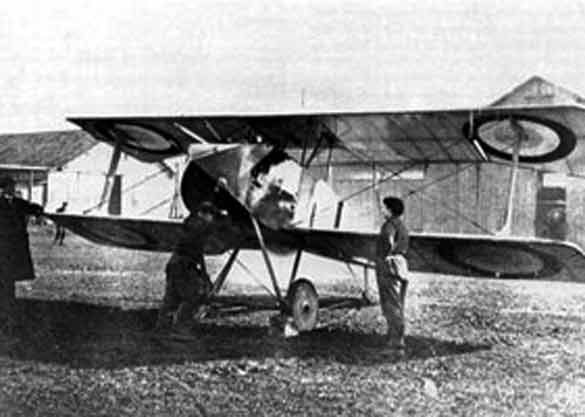
Dufaux C.1 (fandavion.free.fr)
The Swiss were neutral during the war, but they produced some amazing designs and had outstanding engineers. The Deperdussin Monocoque was a Swiss invention, and the Hispano-Suiza engine was the main inline engine used by SPADs and many other entente planes was from Mark Birgkit. Brothers Armand and Henri Dufaux of Geneva were successful pioneers of Swiss aviation and with their fighter design they had an imaginative approach to the problem of having a machine gun firing forward with a propeller in the way.
They went in 1915 with a peculiar design of a biplane with the mid-mounted propeller and front machine-gun. This fighter was propelled by a 110 hp Rhône engine mounted near the center of gravity. So basically the fuselage was cut in half, but the rear part was connected via the engine by a hollow shaft mated to two star-shaped frames at each end of the fuselage. The front and rear fuselages are indeed connected ONLY by a tubular member running through the axis of the propeller… This solution was preferred over twin-boom arrangement that caused some drag. This C.1 was sent to the N95 Squadron for operational tests from April 5, 1916, with the N95 squadron at Châteaufort. But the C.1 did not impressed the military and had problems of engine cooling and structural rigidity so much so no orders followed.
Ferber Planes
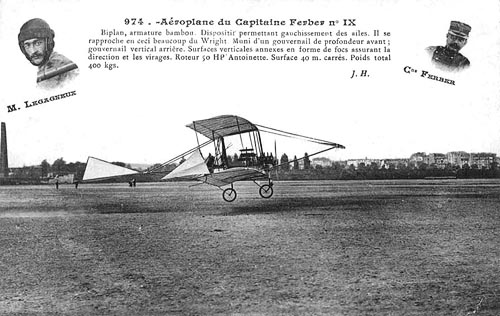
Ferber IX
French Captain Ferdinand Ferber will stay in the annals of French aviation as an influencer, helping the creation of a modern military arm as we know it today. He partnered with many early pioneers, was the first pilot to obtain a licence, and thanks to its links in many circles, publicized the work of the Wright Brothers, which proved a major influence on the development of aviation in Europe. He created nine models, but died in 1909 at a flying meeting in Boulogne on a modified Voisin.
The Ferber IV (1901) was a Monoplane hang-glider modelled on Otto Lilienthal’s designs, the Ferber V (1902) was a Two-bay biplane glider with forward elevator, and later modified with triangular rudders on the outer interplane struts. It was finally rebuilt with a 6hp Buchet engine (V-bis). The Ferber VI (1904) was a two bay biplane glider with an elongated rear-mounted horizontal stabiliser plus its forward elevator. The last Ferber IX was manufactured by Antoinette. It was in fact an Antoinette III, with a length of 9.5 m and Wingspan of 10.5 m, which Between July and September 1908, made a series of longerer flights up to 9.65 km (6.00 mi) in 9 minutes. It was fitted with a V-8 engine driving a tractor propeller.
Galvin HC (1918)
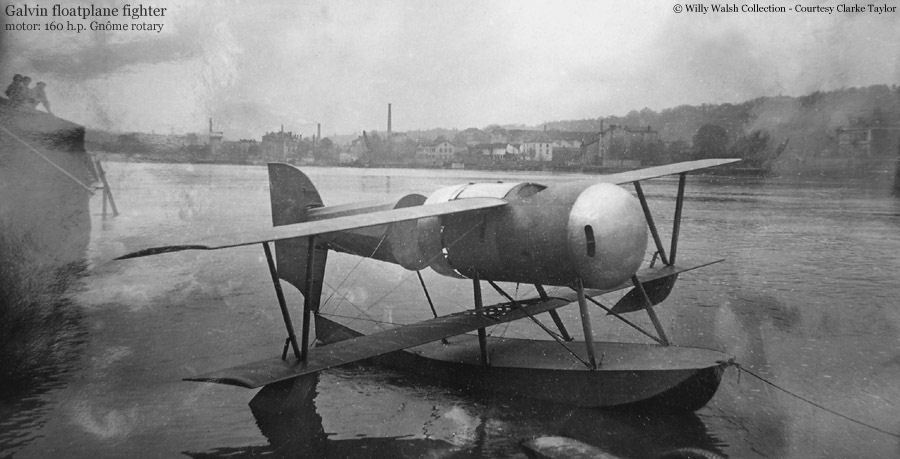
Galvin HC (Willy Walsh coll.)
This unusual floatplane fighter used about the same receipe than the Dufaux, with a mid-mounted engine and propeller halving the fuselage. In that case, the rear fuselage section was connected to the front one by the use of a single float (with two additional underwing-mounted stabilising floats). This Galvin Hydravion de Chasse underwent flight on the river Rhone in the summer of 1919 but its was first drafted in 1918. It was made entirely of wood with fabric skin. The engine cowling was well profiles, helped by a light alloy nose cone.
It was an equal-span biplane, staggered single-bay. The fuselage gap hosted a propeller driven by a 160 hp Gnome nine-cylinder rotary engine and the broad central float was connected to the fuselage by paired N-struts and wire bracing, and I-struts fore and aft plus a large rudder. The Galvin HC was estimated to reach 124 mph (200 km/h) at sea level, despite the considerable drag of the ventral float, and had a 2.0 hrs flight endurance. It was to weight about 1,700+ lb (800 kg) at takeoff, fully loaded and battle ready. Apparently the blueprints intentions were to mount three machine guns that were never mounted according to the photos. Test trials results are unknown, but because of the end of the war, it is no surprise it went nowhere with the French Military.
Georges Levy G.L.40 (1917)
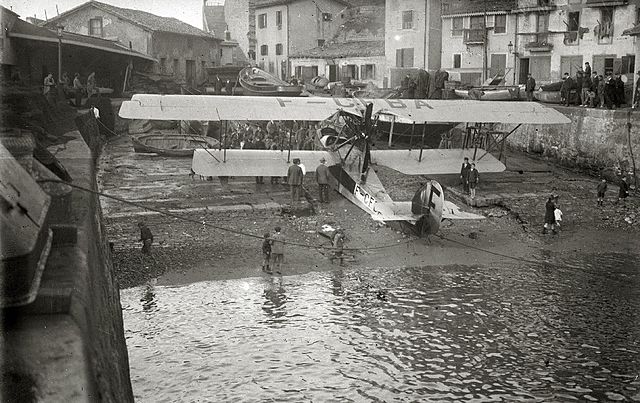
G. Levy GL.40 in civilian use in San Sebastian in 1920. 207 were made of this patrol seaplane until Nov. 1918.
This seaplane was designed by Blanchard and Le Pen and also known as Levy-Le Pen GL.40. Maurice Jules-Marie Le Pen was an engineer from Morbihan (Britanny, born 1889), killed in a car crash in 1919, while Georges Levy was a designer by passion and former banker born in 1891; He created a workshop in Argenteuil Georges Levellois in 1911. In July 1913 he was granted a patent for seaplanes made by François Denhaut, via Henry Lévêque. Georges Lévy founded the Georges Lévy hydroplanes company with Maurice Blanchard and engineer Maurice Jules-Marie Le Pen from Gnome. The team devoted to seaplanes based on the Donnet-Denhaut design for the French Navy. From 1914 the company acquired Ateliers de Bezons (Henri Lévêque workshops) specialized in hydroplanes.
Production went on, until the team worked in 1917 on a proper design, with Marcel Besson. This was a two-seater triplane propelled by 200 hp engine. It was tested, and ordered by the Navy, 207 being delivered, including about 100 by Farman. The company was backrupt in 1937. The previous model was characterized by a low production rate, but high quality and conventional design. However, the Finnish acquired twelve HB2 but were not pleased with it, in addition to many accidents to the point it was nicknamed “the flying coffin” by some pilots in the 1920s. The Belgians after the war also flew converted civilian planes to Congo (Ligne Aérienne du Roi Albert or LARA) flying six Levy-Lepen floaplanes on 1725 km in 1921-23. The GL.40 was also used by Peru, Portugal, and the USA (12 after the war).
Gourdou-Leseurre (1918)
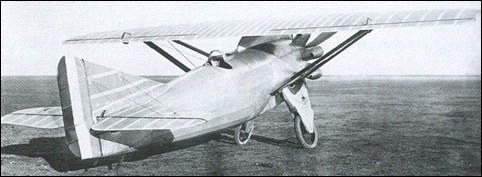
Gourdou-Leseurre Type A 1918
The Gourdou-Leseurre Type A named later the GL.1, was the prototype of a 1918 fighter. Conventional parasol monoplane with fixed tailskid undercarriage, the fuselage mixed fabric, wood and steel. The GL.1 first flew
March 1918 showing performance superior to contemporary fighters, prompting an order for 100 planes by the Army. But another test campaign drove to the conclusion its structure was way too heavy but also that the wings needed tiffening. Therefore with this report alone, the order was cancelled.
The end of the war would have cancelled any production anyway. This design led to the successful Gourdou-Leseurre Type B (GL.2) after the war, an excellent French frontline fighter of the twenties. About 20 were built, followed by GL.21-24 series, totalling more than 100 aircrafts. The prototype first flew in mid-1918 and the first twenty were delivered by November 1918 (but never reached frontline service in time). The GL.2 led to a considerable lineage culminating with the mass-produced GL.30 series, also exported, some still flew during WW2. The company went on to produce dozens of models during the interwar, sometimes associated with Loire (LGL), but eventually ended broken up following strong disagreements between the founders in 1934.
Nieuport-Madon (1918)
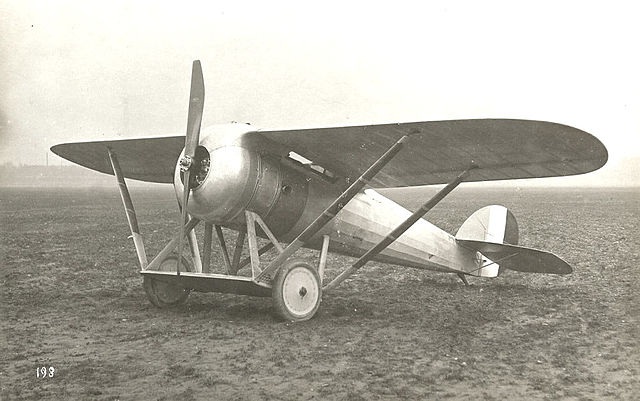
The rare Nieuport-Madon fighter announced the postwar series of parasols that were very much in favor in several aviations
This fighter which development started in October 1917 was the result of the association of famous manufacturer Nieuport, and French engineer and designer Madon. This was a parasol monoplane fighter, which an upper wing directly mounted on the upper fuselage, allowing the pilot which was seated behind to see above it. This was a shoulder-mounted wing, with a cutaway in a section of wing root, and supported by lift struts attached to the landing gear. The latter shown a large additional lifting area, which made this monoplane a quasi-sesquiplane. Both fuselage and wing were made of wooden section, metal tubes, fabric covered. Two synchronized 7.7 mm (0.303 in) Vickers machine guns were located on the engine cowl. First flight was performed in January 1918 with a 110 kW (150 hp) Gnome Monosoupape 9N rotary engine (as the Nieuport 28). A second one flew later this month, with the more powerful 130 kW (180 hp) Le Rhône 9R. It had a revised wing with cut away inboard trailing edges and elongated fin. There was another campaign of official tests in May, but eventually the Nieuport Madon was not accepted but led to the Nieuport 31, or Nieuport-Delage Sesquiplan, later refined ino the more famous Nieuport-Delage NiD 62 frontline fighter in the 1920s and 1930s and still in service in some reserve units as late as 1940…
The Nieuport-Madon was 6.4 m (21 ft) in length, with a 9.4 m (30 ft 10 in) wingspan and 2.4 m (7 ft 10 in) in height, weighted 433 kg/703 kg (1,550 lb) fully loaded and was propelled by a Gnome Monosoupape 9N 9-cylinder air-cooled rotary piston engine, 110 kW (150 hp) allowing a 220 km/h (137 mph) top speed, with a 2 hours endurance and it was able to climb to 4,000 m (13,000 ft) in 13 min.
Paul Schmitt
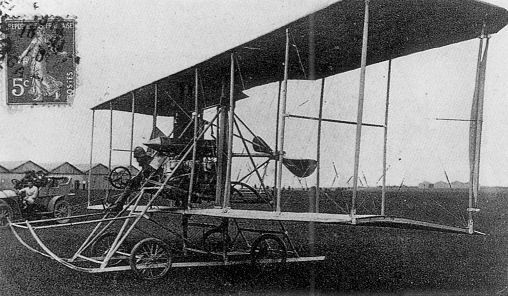
The 1910 biplane of Paul Schmitt
This little-known French company produced planes from 1910. Paul Schmitt was a French designer and started working in aeronautics as early as 1904, making kites, and from 1910 Schmitt created his first aircraft, called the P.S.1. It was a tailless biplane, and the next P.S.2 a two seat trainer. His P.S.3 was its first mature product, a two seat bomber and trainer. The P.S.4 (or “SBR”) Aerobus was a one-off record breaker biplane. When the war broke in August 1914, he volunteered as a gunner aboard one of his own aircraft, but authorities soon considered him too valuable to the war effort, and he was sent back to designing and building aircraft.
Paul Schmitt bombers were remarkable as to be the first built with Variable Incidence system, a mechanical process consisting in tilting upwards or downwards the wings relative to the fuselage and alter its flight characteristics. One of its earliest proponents of this system was French aviation pioneer and aircraft designer Paul Schmitt, fascinated weight lifting potential using variable incidence. In 1913 in particular, he devised the Aerobus which set numerous height, speed, lifting, and endurance records in early 1914, all thanks to his variable angle of incidence of the wings.
Based on this promising model, the French Military hoped more models were to come. The P.S.3 bomber was such of these descendants, entering service in 1915 as a trainer. The next P.S.4 (“SBR” or Schmitt Bomber Renault) was an interim bomber, small production, like the P.S.6. The P.S.7 was his outright success, but variable incidence was considered too complex for production needs and deleted. The Paul Schmitt P.S.7 was nevertheless an outstanding aircraft for its time. It had the wing cell able to pivot or alter the angle of incidence to 12 degrees in order to increase lift and speed.
The P.S.5 was a two seat trainer biplane of 1913, a biplane powered by one 260 hp Salmson engine. While the P.S.6 a short production two seat bomber, the P.S.7 a variant armed with a 37mm gun (called “Gunbus”). The P.S.8 was a variant of the P.S.3., a two seat bomber never completed. The P.S.9 was a two seat bomber with floats, powered by a 160 hp Canton Unne engine. The P.S.10 was a development of the Type 7 with a powerful 300 hp inline Renault V12 engine. The C2 was a two seat biplane fighter which first flew in 1918, powered by a 400 hp Lorraine engine. Apparently it was never adopted because the war ended.
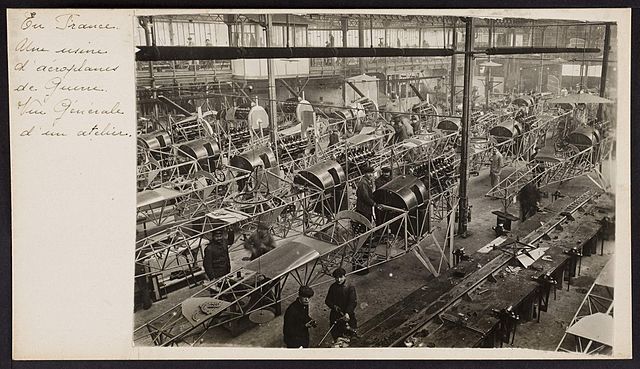
A P.S.7 bomber in production in Ateliers de Constructions Mécaniques et Aéronautiques Paul Schmitt
Paul Schmitt Type 7 (P.S.7)
The large-sized biplane of all-wooden construction covered with linen fabric was developed from solutions pioneered by the award-winning prewar “Aerobus” (Aerobus) which carried nine passengers on board. The design was started in November 1915, in connection to the Directorate of Aeronautics contest, asking for a powerful bomber. However, for both industrial and private reasons the development of the project and construction of the prototype dragged on. Only in February 1917 the first prototype took off but test results were disappointing.
The plane was clearly over-weight and its 200-horsepower engine was not enough. A complete redesign followed suits, but the Army pressed on for production, and a small serie was built, entering service by April-May 1916 with four French squadrons on the western front. Some were given two additional anti-skid wheels in addition to the main undercarriage, a modification called “Schmitt 7/4”. But still, the P.S.7 was limited in operations: To provide acceptable flight, the bomb load was limited to 200 pounds (90 kg). This model was also sluggish and not very agile, making it a convenient target for AAA and fighter alike. As a result by June 1917, the Schmitt plant stopped production and in January 1918 the Schmitt 7B was cancelled. One was tested in the summer of 1917 in Russia, but not adopted. Another also attracted attention of the British air force as N°67 was tested by 56 Sqn of the RFC.
Schmitt went back to the seaplane solution after the war for the P.S.11, armored and propelled by a 250 hp rotative Clerget, with an all-steel fuselage. But both this model and the even more ambitious P.S.12. stayed as projects. The P.S.13 was a two seat bomber design, powered by two 260 hp Fiat A12 engines and the equally ambitious P.S.14 was a two seat heavy night bomber ans also designated BN.2 and powered by four Hispano-Suiza 8Be engines.
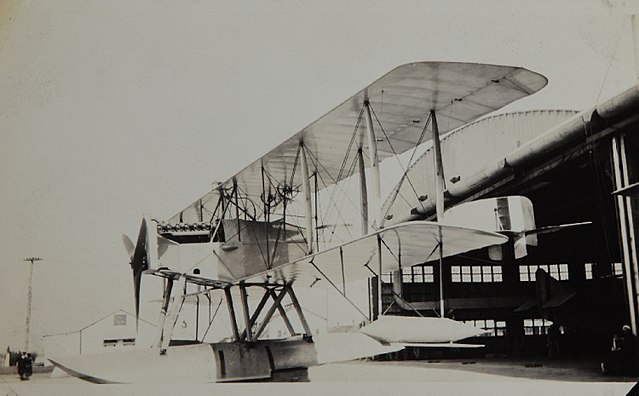
The Paul Schmitt PS7 seaplane bomber
Here is below the list of known models. Most never saw a significant production.
- Schmitt P.S.1 1910 (1)
- Schmitt P.S.2 1911 biplane (1)
- Schmitt Aerobus 1913 (1)
- Schmitt P.S.3 PSR 1914 (5?)
- Schmitt P.S.4 SBR 1914 (5?)
- Schmitt P.S.5 1915 (10?)
- Schmitt P.S.6 1915 (10?)
- Schmitt P.S.7 1915 (c200)
- Schmitt P.S.7/4 1916 (c50)
- Schmitt P.S.8 1918
- Schmitt P.S.9 1918
- Schmitt Sch-10 1918
REP planes
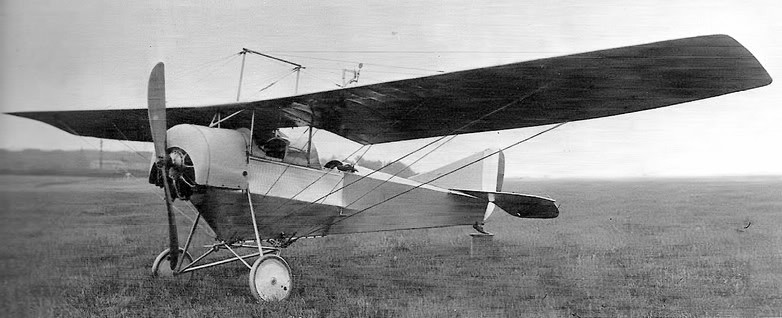
REP Parasol of the RNAS, perhaps one of the best reconnaissance aircrafts of 1914.
The company was created by Robert Esnault-Pelterie, a pioneering French aircraft designer and spaceflight theorist. He was one of the founders of modern rocketry and astronautics, in the same league as Tsiolkovsky, Oberth andRobert H. Goddard. He started experimenting with a Wright-style 1902 glider tested on a beach near Calais, that he flew himself. But this was a deception, and it was abandoned as too dangerous. He developed the concept of the aileron to get rid of wing warping in 1905, with front wings control surfaces.
The next year he made a towed flight. In September he made a 500 m (1,600 ft) leap and first powered flight in October 1907, flying 100 m (330 ft) with his REP 1 driven by a seven-cylinder, 30 hp air-cooled engine. Better still, this engine was designed by himself. Trials of the next plane, the monoplane REP 2 took plane in June 1908. The REP 2 made headlines by flying 1,200 m (3,900 ft) at 30 m (98 ft) in altitude. It was modified to fly in 1909 at Rheims, and was remarked, but Pelterie was then convinced it was a dangerous sportsman game and focused on the development and manufacture of new planes, giving the task to try them to test pilots.
He also produced interesting aero engines sold under the name R.E.P. and using multiple-banked fan or half-radial type. His first seven cylinders double-bank (4+3) was rated at 30 hp (22 kW) and the next 60 hp was a 14 cylinder quadruple-banked engine. His family however invested heavily in his endeavors and was left financially ruined, despite Robert Esnault-Pelterie was the inventor of the “joystick” flight control (patented) which led to patent disputes after the war as many aircraft companies owed him royalties, but he won eventually and get wealthy, also repaying his father’s debts (which was a wealthy Parisian textile industrialist.).
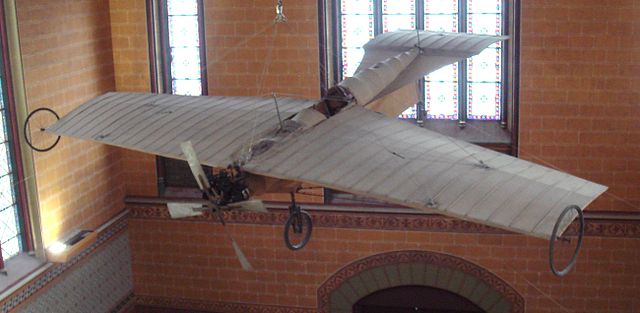
REP N°1 1906, notice the four-bladed aluminium propeller mated on his own 30 hp engine. This was also the world’s first plane to use a joystick.
Robert Esnault-Pelterie also published his first astronautic works in 1913, presenting a rocket equation with the levels of energies required to reach the Moon and other planets. He also proposed the use of atomic energy, using 400 kg of radium. He would eventualy made lectures and conferences after the war and dedicated entirely to his final book called L’Astronautique, where hs summed up his grandiose interplanetary exploration plans, now aware of Tsiolkovsky’s earlier works. From 1930 he would also convince the French war department that he could create ballistic missile for military bombardment, but his attempts with an ambitious tetra-nitromethane rocket failed as the rocket blew up and almost killed him, ending this development in France (This will be relaunched after the war).
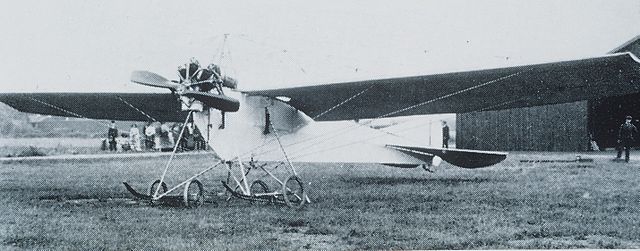
Vickers REP monoplane 1911, used as a trainer by the Vickers Flying School. This was also the first plane to land on Antarctica (1911 Douglas Mawson’ Australasian Antarctic Expedition)
Prior to the war, Robert Esnault-Pelterie created the Vickers R.E.P. Monoplane, his own first production design for Vickers Limited. In 1912 also her created the REP Type N. In 1914 targeting the army, he created a successful REP Parasol monoplane. The Type N was a production reconnaissance airplane with a wire-braced, mid-wing monoplane, fixed, tailskid undercarriage and triangular-section fuselage with a ventral apex, pilot and observer seated in tandem. The Type N equipped two squadrons from the start of the war, Fifth Army’ REP 15 and Tenth Army’ REP 27. Their role was quite important in the Battle of Charleroi in August 1914 and more still, First Battle of the Marne in September while their role was recognized overall in the Allied victory at the Marne. They were gradually retired from March 1915. In 1912, these planes made aso the bulk of the Ottoman Aviation, participating in the Balkan wars. Two were also seized and flew by the Serbians.
The REP Parasol was his last model. Indeed, the French Army never ordered it, perhaps they found it too unusual, preferring the Morane L, and he found instead the RNAS as his only customer. The “R.E.P. Vision Totale” (R.E.P. Total Vision) looked very modern in 1914, almost like ww2 liaison & reconnaissance models. The fuselage was constructed of steel tube and was of triangular cross-section and it used a joystick and wing warping. A single-seater was first made with a 45-kW (60-hp) le Rhône engine, and later a two-seater with a 60-kW (80-hp) Gnome armed with one machine-gun. In addition to reconnaissance these planes can perform strafing missions with six 65 lb bombs under the wings, and twelve 5-6 lb hand bombs.
It was 125 km/h (78 mph) and compared well to the Morane-Saulnier Type L.
But this model was apparently Esnault-Pelterie’s last production one. He devised a fighter in 1916-17, the REP C.1, which was tested in 1918 but never became operational. It was a biplane, with the same metallic tubular structure in a V-section, mounted high up, with an important ventral recess, and half-as-wide lower wing but equal wingspan, small tail fin. It was fast, but visibility was relatively poor.
Esnault-Pelterie concentrated on rocket science afterwards.
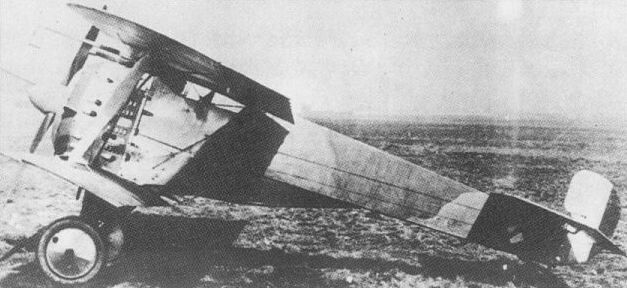
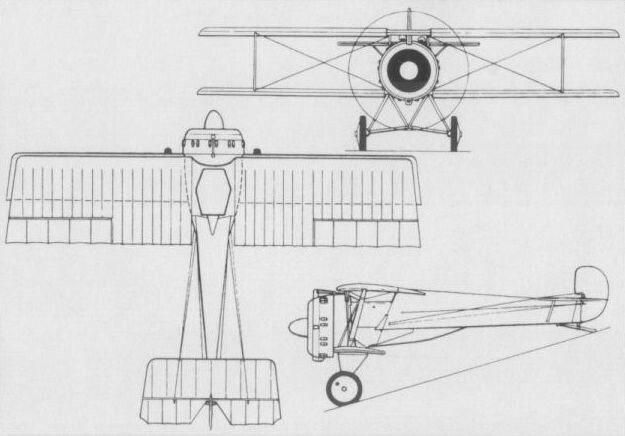
REP C.1 biplane fighter
- REP 1 monoplane 1906 (1)
- REP 2 monoplane 1908 (1)
- Vickers R.E.P. Type trainer Monoplane 1911 (8)
- REP Type N 1912 (c50)
- REP Parasol Recce monoplane 1914 (12)
- REP C1 biplane fighter 1918 (1)
Lebaudy Frères (1908)
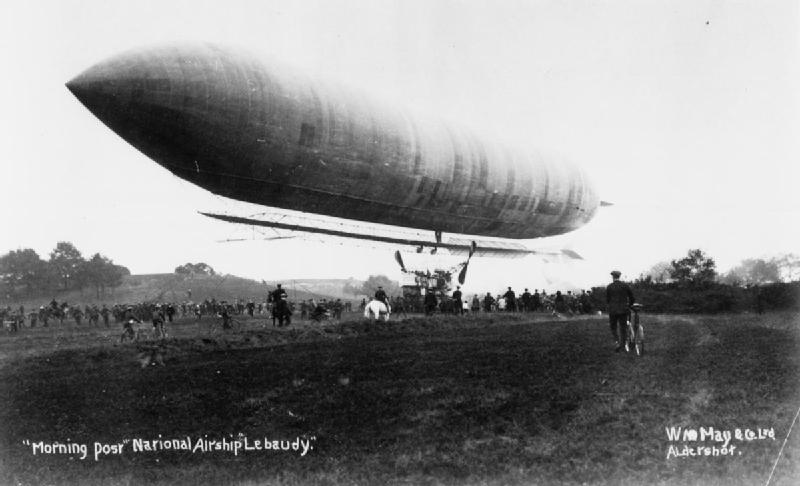
British Lebaudy-made “Morning Post” dirigible at Adlershot, 1910.
The company produced 12 semi-rigid “dirigibles” or airships. The company was a French sugar producer based in Moisson, France. The business started by private interest, with potential customers. Paul and Pierre Lebaudy were the owners of this sugar refinery, associated with engineer Henri Julliot, the main designer for these semi-rigid airships. Production reached 12 airships, starting in 1908, some of which entered service with the French, Russian army and Austrian armies (prior to the war). An airship hangar was built at Moisson, near the River Seine, instrumental in the development of airships in these years. The very last one, in service by 1914 was called Lebaudy Tissandier, 140m long by 15.5m in diameter, 28,000m3 in volume, 1,350 hp in combined power for 80 kph. Activities stopped during the war.
Lioré et Olivier (1912)
This company, famous in the interwar for its heavy bombers and airliners built thousands, spread throughout dozens of models. The Société de Constructions Aéronautiques d’hydravions Lioré-et-Olivier was funded in 1912 by Fernand Lioré & Henri Olivier. Before that, in January 1906 near Champerret, Fernand Lioré installed a new mechanical workshop.In 1908 he started building a first plane, in association with designers Witzig and Dutilleul, the the WLD.1. In 1910, Lioré met engineer Henri Olivier, then a student pilot at the Hanriot school in Betheny.
The success of this first model traduced into a new company in March 1912. Lioré and Olivier Aviation Workshops adopted, after a suggestion by Fernand Lioré, the monogram LeO, derived from the Latin form of “Lion”, which also became the company symbol (a Lions’s head). After the war the company had three factories, located in Argenteuil, Clichy, Hauts-de-Seine and Rochefort, Charente-Maritime. Paul Asantcheff was the head of Argenteuil and Marcel Riffard’s studies department with Edmond Benoit was located at Clichy, all in the vicinity of Paris.
LeO ceased operations when the company was nationalized in 1936, merged with Chantiers aéronavals Étienne Romano, Potez, CAMS and SPCA. This group became Société nationale des constructions aéronautiques du Sud-Est (SNCASE) in February 1937, relocated at Rochefort. It became SNCASO after the war.
The Company produced a licence-built Sopwith Strutter 1.1/2 for the Army during the war. It had some minor alteration and was called Lioré & Olivier LeO-1 in service. There is little informations about the following LeO 3 to 6, bomber prototypes. The LeO 5 was apparently a navy heavy fighter biplane tested in 1919, in service by 1920. The LeO 7 Bomber escort biplane derived from the LeO 5 saw a small production in 1922.
Savary Planes (1908-1913)
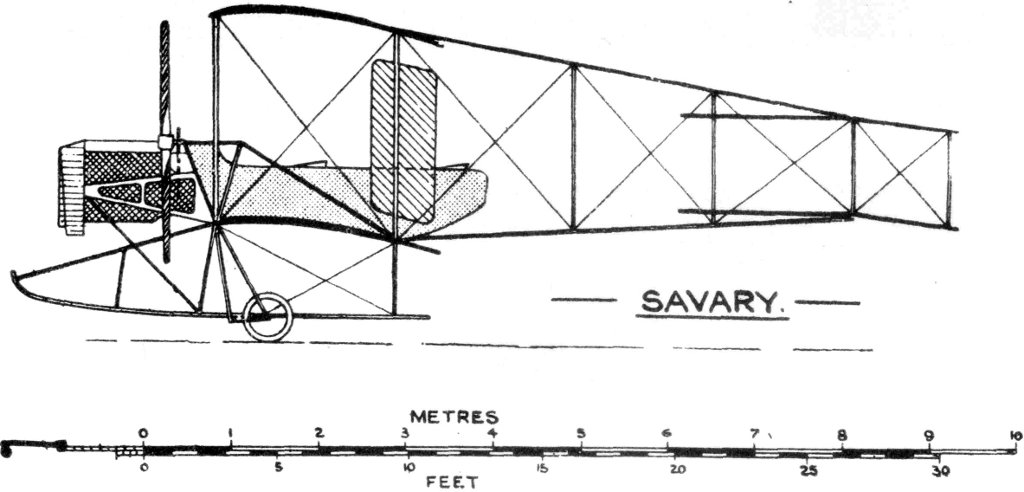
Savary Military Biplane 1913, total production in 1912-1913 combined approached 100 aircrafts, used for observation and as trainers in 1914.
This was perhaps one of the best known pioneers of the Chartres airfield (which saw som many French pioneers making flights, from Rollan-Garros to Blériot, Latham, Shmitt, and many others, were records were broken. It was almost a “brotherhood of flight” were new ideas were tested and companies started. He created a flying school in Chartres that soon became famous. In 1911, he started his own business called Société anonyme des aeroplanes Robert Savary which offices were located at 31 rue Dunois, Paris and at the Chartres school, which had workshops with a an output capacity of about 100 to 150 planes a year. The goal was to provide pilots their brevet and own planes, a solution also seen by other schools funders.
According to Jane’s aircraft 1913, Savary produced planes in 1912 and 1913, at first copies of Wright planes, then devised their own test three-seat observation plane for the military in 1913. This model made tests of wireless telegraphy , and carried a machine-gun. These Savary Military Biplanes were recorded ranging in lenght to 36 (11), 33 (10.15) or 38 feets (11.70m), 46 (14), 49 (14.90) or 50 feets (15m) top wingspan and 33 (10) 37 (11.20) 33 (10m) lower wingspan, with a sq. feet area of 510 (48) 533 (50) 550 (52)m2, and 1132 (600) or 1132 Ibs (600 kgs) in weight. They were propelled by 75 hp Renault, Gnome or Labor engines, giving them a 56 mph (90 kph) to 59 mph (96 kph) or 50 mph (80 mph) top speed and a production record of 47 planes in 1912 alone.
It was of wood and steel tubes construction, controlled by ailerons and a rear elevator, fitted with a skids-type landing gear and featuring four rudders in the gap plus 2 chain driven tractors engines. However the Army used these by default of better airplanes, as their forward vision was cluttered. This was not a problem for the observer, only for the pilot, that had to land and was seated behind the observer, in the tail of the nacelle containing the engine.
Pdf about Savary planes at Chartres airfield and flying school
More about Savary planes on flyingmachines.ru
Société d’Aviation Letord
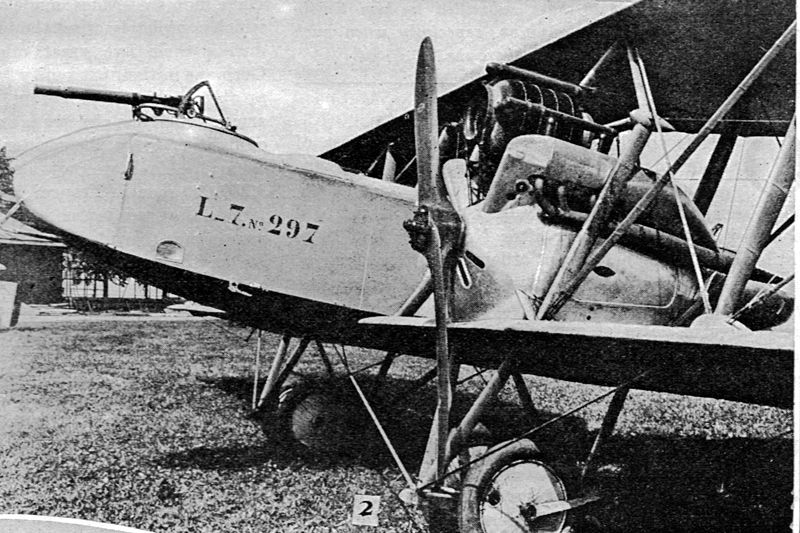
Letord Let-7 twin-engined bomber biplane 1917. The Letord (or Letort) Let.7 was a long-range reconnaissance biplanes, which also served as bomber and bomber escort. They were sesquiplanes characteristic negative stagger and were powered by two engines mounted on short struts on the lower wing. They also had a fixed tailskid undercarriage and many of were also equipped with a nosewheel to prevent landing accidents. The pilot sat in an open cockpit and the tail gunner was in a rear open position amidships.
There was a third one in the nose which also played the role of observer and bomb-aimer. Bzfore the Let.7 there were many other models, the Let.1 reconnaissance version with Hispano-Suiza 8A engines, the Let.2 with Hispano-Suiza 8Ba engines, the Let.3 bomber with the same engines, the Let.4 reconnaissance version with Lorraine-Dietrich 8A engines, the Let.5 bomber with the same engines but 8B, and the Let.6 escort fighter with a 37 mm cannon and Hispano-Suiza 8Be engines. It was apparently the first production variant, with an army designation CA.3. The Let.7 bomber also had Lorraine-Dietrich 8B engines.
The next Letord Let.9 was a large night bomber biplane of conventional design, with unstaggered wings of equal span. A single, triangular and large fin and biplane horizontal stabilisers composed the empennage. It was a twin engine bomber, both being mounted on interstruts the interplane. The undercarriage comprised dual wheels and there was a tail skid. The plane was tested officially and given the designation BN.2 (“Bombardement de Nuit” or Night Bomber, 2 seats), but production never had the time to start at the end of the war, the whole program was cancelled.
Société d’Études Aéronautiques (1916)
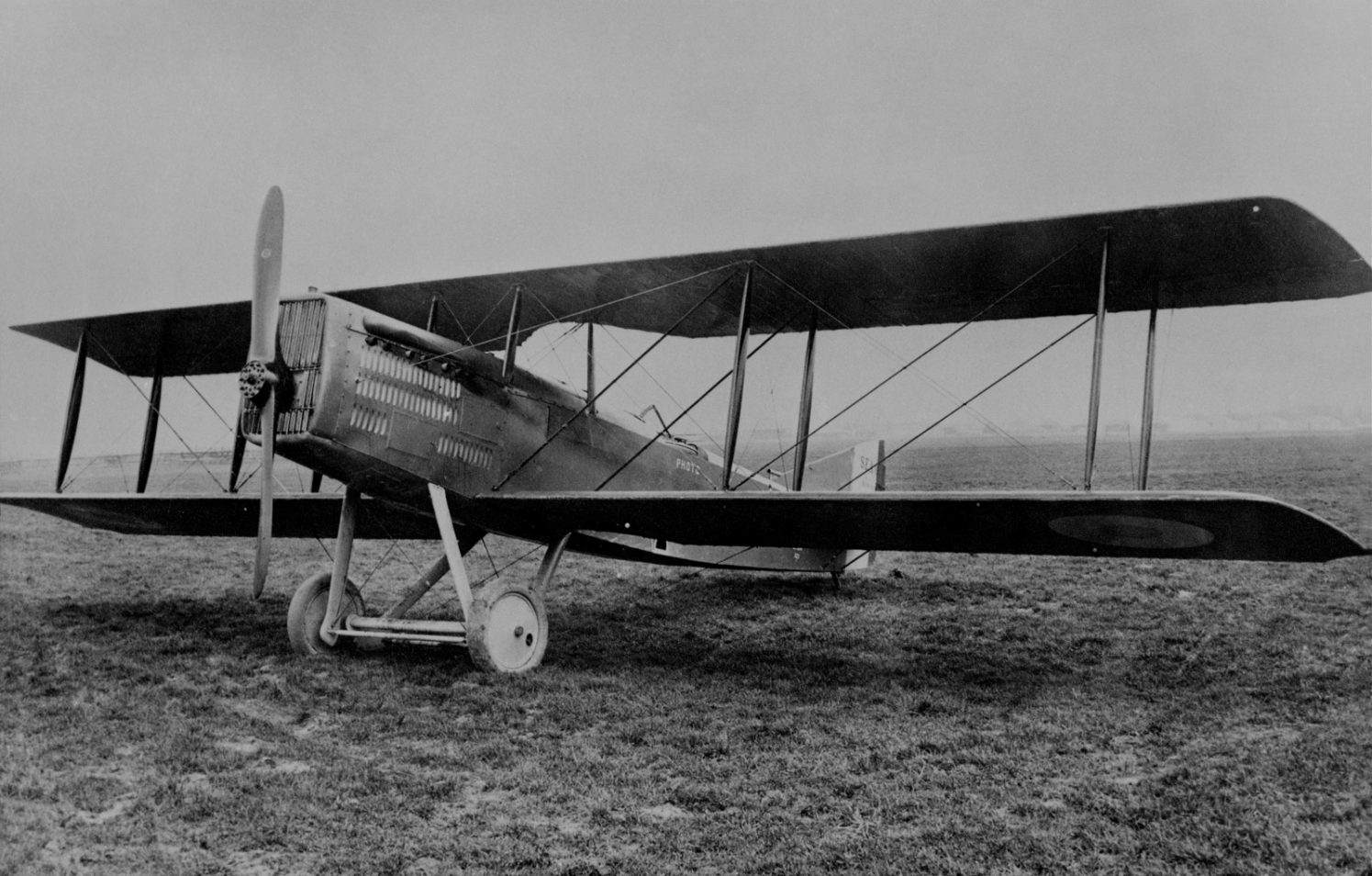
SEA IV two-seat multipurpose military aircraft 1918. 1000 were ordered, but non were delivered because of the armistice.
This French aircraft manufacturer was founded in 1916 by Henry Potez, Marcel Bloch, and Louis Coroller at Suresnes. Both Potze and Bloch will became prominent names in French Aviation. Marcel Bloch was renamed Marcel Dassault after WW2, starting the most successful French aircraft business ever. The Société d’Etudes Aéronautiques (SEA) was a joint venture between Henry Potez, Louis Coroller, and Marcel Bloch which started ab aircraft production and design in 1915. To the prototype SEA.I succeeded the SEA.II in 1917, which production records -if any- are unknown. Although not ordered, this model draw some attention from the Military.
The company started to produce SPAD VII fighters under licence to gain skills, but its own design bureau soon designed a few models. The fourth, called SEA IV was flown, tested, and selected by the military for production, but orders for 1,000 aircraft culd not be met right away, so Potez and Bloch each founded their own separate plant, and own companies to undertake it. Anjou Aéronautique was established at Angers with Julien Bessonneau to take on mass production, but the war ended before the factory was completed, causing the cancellation of the order. Therefore both Anjou Aero and SEA were stopped and partly dismantled. Potez and Bloch went their own way afterwards securing many more orders for the French Air Force.
The team designed the SEA.III (which stayed on paper) and leaped directly towards a derivative of the SEA II model, but propelled by a more powerful Lorraine engine of 261 kW (350 hp). The SEA IV prototype made its first flight in early 1918 near Plessis-Belleville and was tested by French ace (9 victories) Gustave Douchy, and passed onto Villacoublay’s Centre d’essais en Vol test pilots. The Armement ministry soon placed an order for 1,000 SEA.IV. Since Marcel Bloch was one of itskey designers, its often referred nowadays as the “earliest Dassault”. The Army was interested into this promising model and soon in August 1918, General Duval (commander in the General Headquarters) established the need for two variants planned for 1919, the observation SEA IV A2 C2 for heavy fighter escort. In October 1918 the order planned the delivery of 200 planes per month for the first quarter of 1919, and 400 by April, but of course, the Armistice caused cancellation at which point the factory had only delivered 115 planes, but the C2 built served for years in several escadrilles at Le Bourget. A further 25 were built by Henry Potez (Potez VII) after the war, converted for the civilian market as luxury touring aircraft while another was converted as a racing aircraft.
Specs SEA IV:
The SEA IV was 8.50 m (27 ft 11 in) long by 12.00 m (39 ft 4 in) in wingspan, 3.10 m (10 ft 2 in) high, and weighted between 1,015 kg (2,233 lb) and 1,620 kg (3,564 lb) at takeoff, propelled by a Lorraine-Dietrich 12Da 10, 261 kW (350 hp) to 218 km/h (118 knots, 136 mph) and it had a 700 km (378 nm, 437 miles) range and 7,400 m (24,272 ft) service ceiling.
Tellier (1917)

A Tellier T.3 during the Russian civil war (wingspalette.ru)
Not well-known but by aviation specialists, Tellier was during the war an seaplane specialist, mass-producing patrol seaplanes for the Navy. They had been born from Société Alphonse Tellier et Cie at Neuilly (Paris) , associated with Nieuport. After two prototypes of floatplanes never ordered by the Navy, the company proposed the Tellier T.3 in 1917. It was based on the T.2 prototype (which first flew in June 1916) as a two-bay, unequal-span biplane flying boat. It was fitted with a 200 hp (149 kW) Hispano-Suiza 8Ac inline engine in pusher configuration.
The pilot sat ahead (and below) the engine and the gunner/observer was further forward, in the nose with a scarf-mounted Vickers machine gun. Tests flights were performed by the Aviation Militaire and Aéronavale (fleet air arm), the latter ordering ten, while the RNAS ordered two for gun and camouflage trials at the Isle of Grain. In the end, 100 Tellier T.1s were built, production being also taken by Nieuport (47), which also in the end took over Tellier assets. The cannon-armed Tellier T.c.6. was largely ordered but only 55 were delivered when the Armistice came out. The T.1 was 11.8 m (38 ft 9 in) in length, with a wingspan of 15.6 m (51 ft 2 in), and height of 3.6 m (11 ft 10 in). It was weighting, empty, 1,150 kg (2,535 lb) and loaded at take-off some 1,796 kg (3,960 lb). The 150 kW (200 hp) HS engine propelled it at 135 km/h (84 mph; 73 kn).
Next the Tellier T.4 was produced to around 35 planes, also made by Tellier and Nieuport, apparently lighter than the previous one, and propelled bu a Sunbeam Maori engine that developed 350 hp. It could reach 150 kph, with a 3500m service ceiling and 700 km range. It could also carry four 70 kg bombs (154 Ib). Informations about the T.5 are sketchy at best, but production probably never happened due to the end of the war. The T.6 is apparently assimilated to the T.c.6 (55 made, see above). Read More: https://en.valka.cz/topic/view/18355/Tellier-T-4
Vendôme (1914)
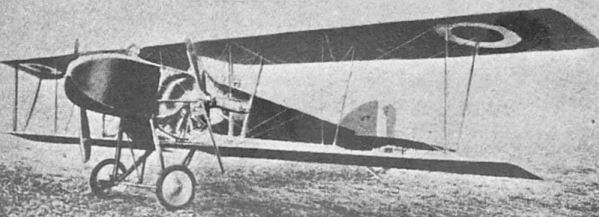
Vendôme A3 1916 twin-engine biplane (http://flyingmachines.ru)
Vendôme (still a prestigious place in Paris) was a short-lived company funded by aviation pioneer Gibert, which already tried various gliders. He began producing Blériot XII-type monoplanes in small quantities in a worskhop inclusing for the military in 1912. But he also worked on a design of its own, later called the Type 1914. He was injured in an early flight attempt, but after some rest her went up at Issy on this new Vendôme monoplane, dropped from 500 metres, flying around the Eiffel Tower. However during the flight he seemingly miscalculated the rate of descent, and switched on the engine too late, at about 30 m, which failed to start. He therefore crashed on a the tile roof but both the roof and pilot miraculously emerged unhurt from this. This was in Flight, January 17, 1914, and Gibert already created a “type militaire” hoping to attract orders (which never came) in 1913. The Vendôme 1914 monoplane had wing cut-outs and according to Janes 1919, at least one was used for the Spanish Army flying school. The 1912 Vendôme resembled closely to the contemporary Blériot XIII.
In 1916 he reappeared with a biplane, called the Vendôme A3. This was a completely new plane, in the style of the Moineau. The fuselage’s side shown Monosoupape Gnome engines turned externally, driving a shaft each, connected to a bevel gear, driving a tractor airscrew. Both rotary engines turned in opposite directions giving lateral stiffness dur to their contra-rotative gyroscopic action. The pilot was located in front of the engines, with the gunner seating in front of him in a nacelle, potentially armed with a light scarff-mounted MG in the nose. A second MG was located behind the pilot. Just like the Moineau this unusual configurations did not inspired much the Army that declined any production. There is little information about the A1 and A3 models.
Wibault 1 (1918)
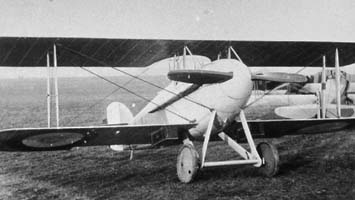
Wibault 1 1918 – src: www.airwar.ru
The Société des Avions Michel Wibault was a French aircraft manufacturing company established in 1919, after the war, but its workshops located in Billancourt, in the Paris area had been created to produce a fighter for the French Army in November 1918. The Wibault or Wib 1, later Wib 1 C1 was a single seat, single engine prototype flown near the end of the war and shown to the purchased commission but not selected for production. Michel Wibault would have however a brillant interwar career, producting about fifty plane models, generally all-metal fighters. The most succesful one was the Wibault 74 and some passenger planes but ceased activity in 1935. Wibault alos worked with Nieuport-Delage and Breguet. Some of these went in action in WW2.
The Wibault 1 was powered by a 220 hp (164 kW) Hispano-Suiza 8B engine. This was a water-cooled upright V8 engine, housed under a smooth curved cowling. This work was commpleted by a large domed spinner. It was armed by two synchronised 7.7 mm (0.303 in) Vickers machine guns. The fixed undercarriage had its mainwheels mated to a rigid axle attached by a pair of faired V-struts. It was a single bay biplane with slightly unswept wings of short span, and broad chord ailerons on the lower wings. It was officially tried on 12 February 1919 but despite its excellent performances failed to the Nieuport 29 propelled by a 300 hp (224 kW) Hispano-Suiza 8F engine.
Weymann W-1 (1915)
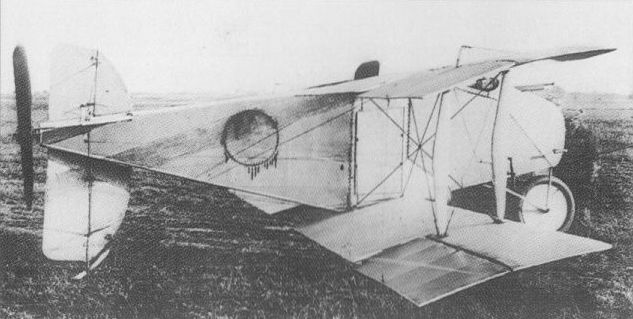
The Weymann W-1 was an unconventional solution for the absence of machine-gun synchronization. The programme was close in December 1915 as the centrally-mounted engine was massively overheating.
Charles Terres Weymann was French-American pioneer aviator, coachbuilder, auto race driver. He designed a plane during WW1 in order to resolve the problem of front machine-guns and propeller.
This unusual one-off prototype was a single seat biplane fighter with a most unusual layout: The engine buried in the fuselage, driving a pusher propeller behind a cruciform tail. It was built at Société de St Chamond, Villacoublay
by Designer Charles Terrès-Weymann, hence the name. This was one of the attempts to devise a way to place a machine-gun at the front of the airplane, before a practical synchronization mechanism could be used. The most obvious one was to fit a light machine-gun over the top plane, above the propeller radius, but the pilot had to stand to fire, joystick held between his legs, which was not practical. Nacelle planes with twin engines or pushers were also common, but the French had a flair for unconventional designs, and several manufacturers made planes with centrally-mounted engines, and sometime central propellers as well, including SPADs. The Weymann was another attempt at this, with a shaft driven from a centrally mounted engine.
So it was a pusher, with the engine in the center of gravity. It was also was unusual as being all-metal, single bay with constant chord and equal span, unswept and unstaggered wings and ailerons on both planes. The flat, deep fuselage filled the interwing space. The pilot therefor could see above the upper wing leading edge and had at its disposal two machine guns installed aft of the front nose cowling. Since the nose was well-faired and fine, it gave an unobstructed view.
For the engine was buried, and intake was placed into the underside of the fuselage, below the cockpit. The engine was a rotary 80 hp (60 kW) Clerget 7Z, which exhaust ran on the upper fuselage. The upper fin and rudder were short but extended below the fuselage and the tail surfaces had curved leading edges. The Weymann W-1 undercarriage had a nosewheel of the same diamater as the two main wheels of the undercarriage, not like standard tricycle. On the ground this plane however rested level on its mainwheels and tailskid. The W-1 made two short test flights, in the autumn of 1915. They served to show the woefully inadequate cooling of the buried engine, which overheated to the point of igniting the entire fuselage, and were revealed insurmountable even after modifications. The project was abandoned in December 1915.
Read More:
Defunct aircraft manufacturers of France
Entente aircrafts
About variable incidence in 1913
PS Sch10 on wikipedia
PS7 on wikipedia
Aviafrance PS7
Flyingmachines.ru
On aviafrance.com
On dieselpunks
Pdf about Schmitt and his test pilot Romain Garaix
Also: Dr. James J. Davilla and Arthur M. Soltan ww1 planes encyclopedia, pages 451 to 458.
 Blériot
Blériot
Louis Blériot, the man who conquered the channel
This engineer and great aviation pioneer developed previously the first practical headlamp for cars which became a successful business. In 1901 he studied a small unmanned ornithopter, but really started with aeroplanes from April 1905. Seeing Gabriel Voisin’s experiments with a floatplane glider partnered with him, until the failure of the Blériot III/IV. At that time Blériot departed and created his own his own company named “Recherches Aéronautique Louis Blériot” a privately funded research establishment with engineers and designers. Blériot’s involvement therefore in various designs is more difficult to point out. The Bleriot serie grow more successful each year, culminating with the famous Type XI, the first to fly across the English Channel (1909).
Blériot’s media success
If he needed a world’s media coup to boost his company, Blériot bet his chances on the type XI and crossed the Channel based on the new 1,000 pounds Daily Mail prize as none tried to fly over it in 1908. But he was not alone in this endeavour, Hubert Latham, Charles de Lambert and Arthur Seymour also attempted it. The event already attracted crowds, about 10,000 each side of the Channel at Calais and Dover while the event was to be broad-casted through Marconi’s radio. He took off at 4:41 AM (sunrise) and flew at 45 mph (72 km/h) and an altitude of about 250 ft (76 m), guided by nearby destroyer Escopette, fault of a compass. He flew however a large part without any visbility until spotting grey line of the English coast, revealed on his left; He veered course and ultimately spotted a flag waver, Charles Fontaine correspondant from newspaper Le Matin which previously had selected a sloping land called Northfall Meadow near Dover castle. Blériot gained instant celibrity, and attracted much publicity for his company, followed by, understandably more and more orders. Having previously being indebted, Blériot sold dozens copies of the Type XI by the end of the year securing orders from 100 aircraft at around 10,000 francs apiece.
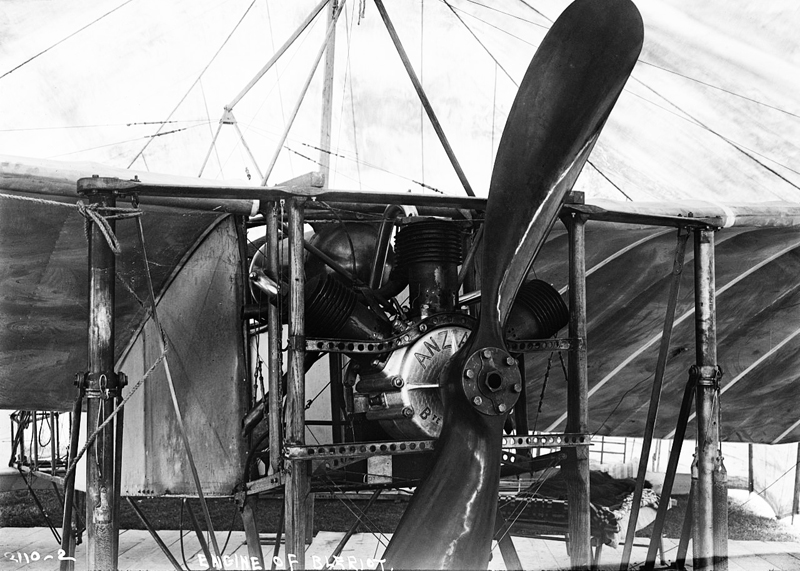
Prior to 1914
Blériot would later narrowly misses the first Gordon Bennett Trophy, but participated at meetings in reims and later Budapest, Brescia and Bucarest, making the first appearance of any aircraft there. His chance turned at the 1910 aviation meeting in Istanbul where he crashed and was hospitalized for weeks. He attempted, due to his fame in UK, to create British flying schools at Brooklands, in Surrey and at Hendon Aerodrome, while creating the Blériot Manufacturing Aircraft Company Ltd but secured few orders as his model was seen as largely outdated. In France he also established a school at Etampes near Rouen, and another at Pau (southern France). By 1914 his company has turned about 900 aircraft, variations of the Type XI. His competitors were Voisin and Farman. However despite a heterogeneous collection of aircraft were produced, none came close to the Type XI. The army was soon interested and he designed the Blériot XXXVI by 1912, a two-seat military monoplane. During the war he also developed three prototypes of the Blériot 67, 73 and 74 Four-engined bomber.

However his Blériot XIs entered military service in Italy and France in 1910, the latter flew these in North Africa in 1911 and in Mexico. The British Royal Flying Corps received some in 1912. And in 1914, eight French, six British and six Italian squadrons operated Blériots for observation and training. When used as light bombers they could carry up to 25 kg bomb loads. In 1913 however on the industry side, he made a very important move by acquiring the the assets of the Déperdussin company. The company boss has been indeed arrested on fraud charges. The new company backed by Blériot would became the staple of French wartime fighter production, as SPAD. The company Blériot-SPAD would produced after the war and until his death in 1936 a wide array of fighters and other aircrafts both for the military and civilian markets. Still an engineer at heart and fascinated by speed, Blériot would also participate in the design of cyclecars and sidecars.
Types
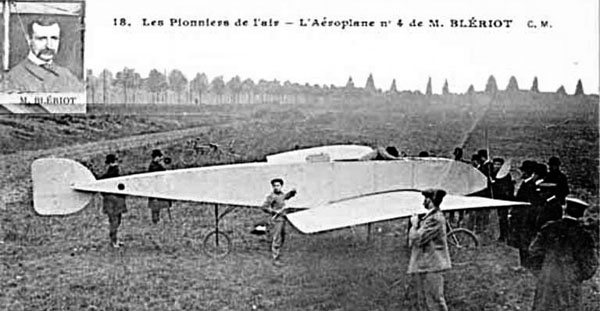
Blériot VII
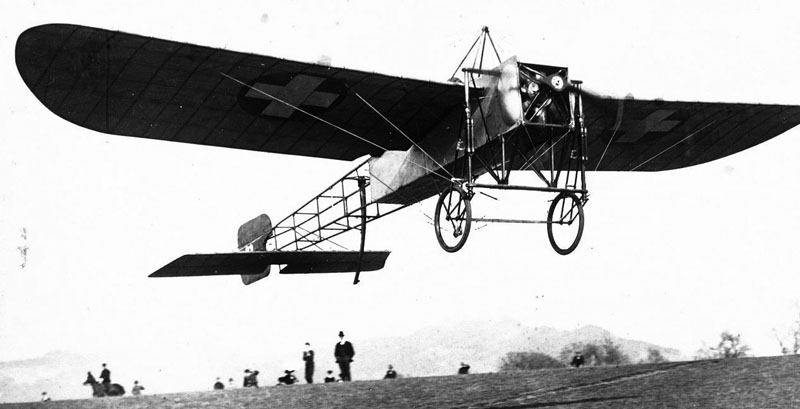
The famous Blériot XII, flew by a Swiss pilot, Oskar Bider, at Bern in 1913
The Blériot series
This list only comprises military planes. It should be noted that the whole Blériot serie started in 1901 with an unmanned ornithopter powered by a carbonic acid engine. Until the emblematic Bleriot model XI, prototypes testing various airframes configurations were tested, some existed only on paper. Of the Blériot XII only apparently three were made, the following XIII was a single five-seat pusher configuration biplane, and the Bleriot XIV a two-seat monoplane. No production record for these. One of their follow-up was the Blériot XXIV Limousine, first dedicated transport passenger plane, with an enclosed cabin. The Blériot XXIII of 1911 was a Racing monoplane.
The model Bleriot XXI participated in the 1912 British Military Aeroplane Competition. Other models in 1912 and 1913 followed, the last being the Blériot XXXVII (1913), a derivative of the Blériot XXXVI Bis observation plane flew by Jules Védrines. There was no war production to speak of, only paper projects. Manpower and machines went on producing SPADs instead. See the SPAD section.
 Breguet
Breguet
Before Watches there were planes
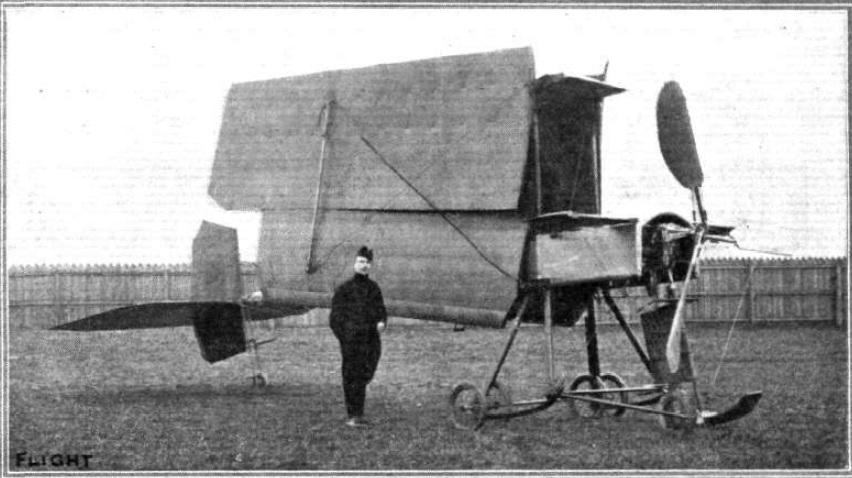
The Breguet Type III was the first Breguet test French Air Force model, it gained fame in August 1910 by being the first aircraft to lift six people.
Breguet Aviation was one of the great pioneers of aviation history. The brothers practically invented the first helicopter, working with Professor Charles Richet, called “Gyroplane” in 1907-1908. These were ingenious contraptions with rotors which had a little bit of twisting to regain steering. The second one had a better 41 kW (55 hp) Renault engine and flew several times, but control was nearly impossible. The type 1 and following crafts were biplanes of pusher configuration related to the Wright model, which met various success. But the company is best rembered for the Type IV, later declined in production as the R.U1, which really help funding the company, with dozens of deliveries to sportsmen and amateurs and fourteen variants depending on the engine. This first production model was also used by the French Army and the R.F.C. These were light one-seaters, with a new undercarriage and able to carry a passenger. But Breguet is best remembered for its classic pushers in the Voisin configuration like the Breguet Bre.4, 6 and 12 in relative small numbers.
However the model that changed everything was the Br.14. It was for two years, until the end of the war, one of the most prolific allied plane of the war, with 8,000 built in all, many outside Breguet plant. This reliable single-engine, two-seat biplane bomber was produced also well after the endonf the war, used by the Aéronautique Militaire, US Army Air Service, Polish Air Force and the Royal Thai Air Force and many more, about thirteen countries used it proficiently until the late 1920s. It was of strong construction, and can take quite a lot of punishment, was easy to fly, stable,and had good performance. It was arguably one of the best aircraft of the war. The Company was never really able to repeat this success, but produced nevertheless two derivatives, namely the Br.16 and 17, larger bomber or shorter heavy fighter in smaller quantities.
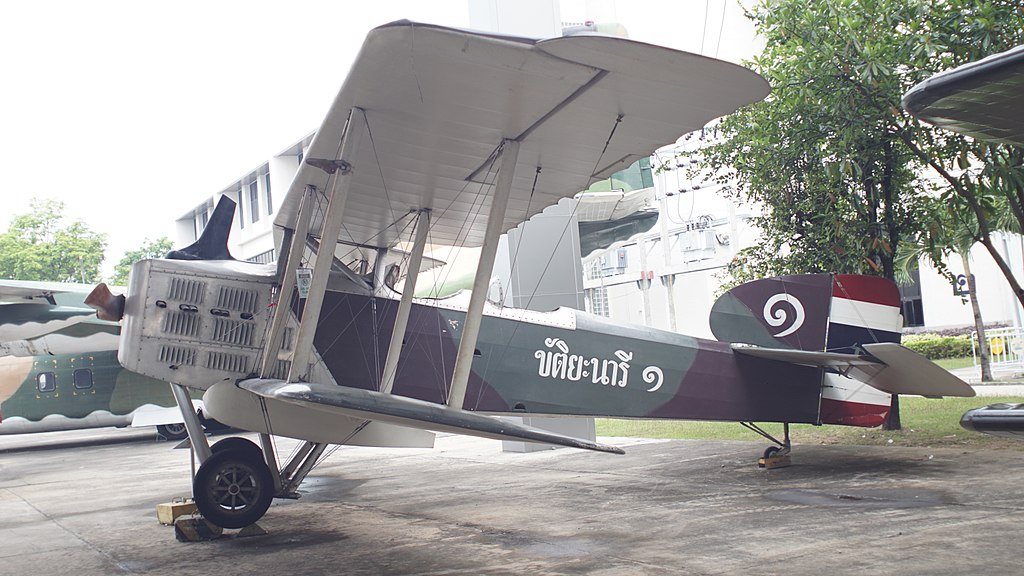
A Thai Air Force museum replica of Breguet Br.14, one of the best light bomber of the war.
Model Detail
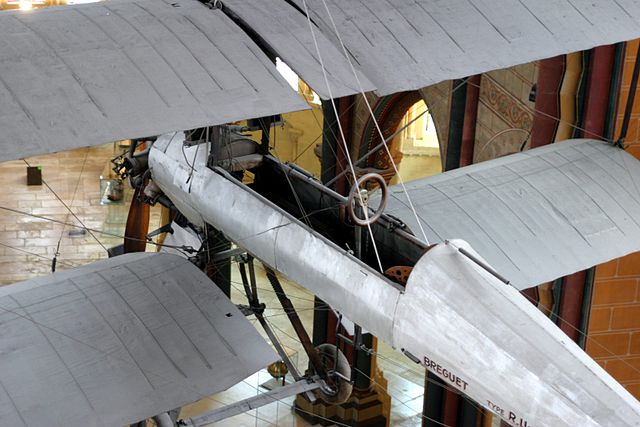
R.U.1 at the Musée des Arts et Métiers (1911). A very successful civilian biplane declined into a very large number of engine-based versions
The 1907 Breguet-Richet Gyroplane was an experimental single-seat helicopter-like craft with four rotors, the next year Gyroplane No.2 was a tandem biplane with a pair of large inclined propellers providing both thrust and lift. The Type I (1909) Single-seat tractor biplane had boxkite-like tail on booms. The next Type II of 1910 was a new version with a with a tricycle undercarriage and the tail carried at the end of a fuselage-like structure and a pair of booms. The same year, the Type III was up, as a three-seater with a rotary engine. The Type IV stayed experimental, the Type R.U1 was a single seat biplane derived into many variants in a proprietary basis, offered with many motorizations. It was a 1911 civilian model. The Breguet Aerhydroplane of 1913 was a paper-project of a Single-engine one-seat seaplane. The first production military model was the Breguet Bre.4 of 1914, Single-engine two-seat biplane bomber with a Pusher configuration. The next Bre.5 of 1915 was a development of the first, Single-engine two-seat biplane escort fighter. it was derived into the model 6, with different engine, and the Br.12 was a version of the Breguet 5 with 37mm cannon and searchlight as a night fighter in 1918. The large production Br.14 of 1916 became the staple of French biplane bomber aircrafts from 1916, a dependable single-engine two-seater model. The Br.16 of 1918 was a lengthened version and the Br.17 a shorter one, used as a fighter in 1918.
Production Models
- Breguet Bre.4 (1914) (c50)
- Breguet Bre.5 (1915) (c100)
- Breguet 6 (1915) (c50)
- Breguet 12 (1918) (?)
- Breguet 14 (1916) (8000)
- Breguet 16 (1918) (200)
- Breguet 17 (1918) (100)
 Avions Caudron
Avions Caudron
The Caudron brothers’s long-enduring legacy
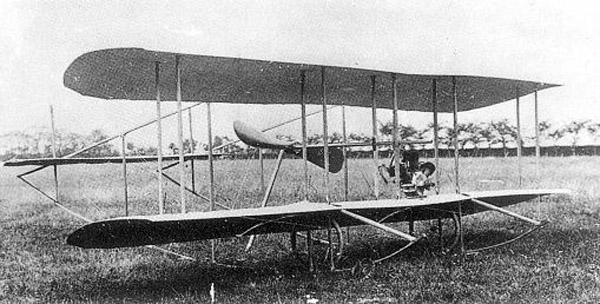 Many brothers apparently left their mark to the Aviation history board, the most famous ones being the Wrights. Long before them in the late 1700s in France, the Montgolfier already left this earth on a paper balloon, the first human flight in record ever. The Caudron brothers (perhaps something to do with the art of cauldron making in medieval times) Gaston and René founded their company in 1909, and produced some 4,000 aircrafts during ww1 and some more in the interwar, before being bought by Renault in 1933, which left in the wake of their marriage a lineage of impressive race monoplanes, but that’s another story. Caudron during the Great war procured France and other belligerents in the entente famous and reliable single and twin-engine nacelle aircrafts, used for observation, bombing and training. Some of these definitely stand out like the Caudron G.III, first French mass-produced observation plane, or the modern G.VI, long range twin-engine for observation and bombing, the types R bomber series, and many prototypes, including one fighter.
Many brothers apparently left their mark to the Aviation history board, the most famous ones being the Wrights. Long before them in the late 1700s in France, the Montgolfier already left this earth on a paper balloon, the first human flight in record ever. The Caudron brothers (perhaps something to do with the art of cauldron making in medieval times) Gaston and René founded their company in 1909, and produced some 4,000 aircrafts during ww1 and some more in the interwar, before being bought by Renault in 1933, which left in the wake of their marriage a lineage of impressive race monoplanes, but that’s another story. Caudron during the Great war procured France and other belligerents in the entente famous and reliable single and twin-engine nacelle aircrafts, used for observation, bombing and training. Some of these definitely stand out like the Caudron G.III, first French mass-produced observation plane, or the modern G.VI, long range twin-engine for observation and bombing, the types R bomber series, and many prototypes, including one fighter.
After the war, Caudron became a pillar of French aircraft production, turning hundreds of utility planes like the Luciole, Phalene, super-Phalene, the transports Goeland and Simoun, or the famous blue Coupe Deutsch de la Meurthe racers that dominated the competition in the 1930s, Rafale (first of the name) which became afterwards popular sport/touring aircraft called Aiglon before being converted in emergency as fighters called Cyclone before 1939.
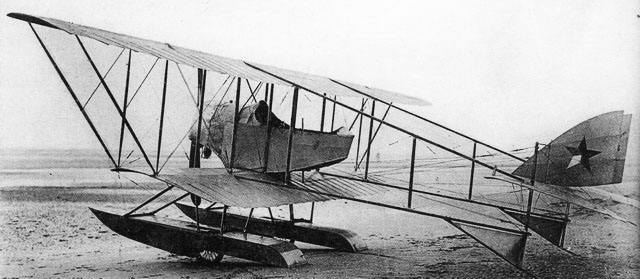
The G series success story
If Caudron was to be remembered by a single plane, at least for WW1, that should be the G.III. Its production, for France alone, reached 2500 before the twin-engine G.IV appeared, but never equalled it. Robust and reliable, stable and simple to fly, it was fit for observation and training and became de facto the main trainer of many new-born aviations around the world. 233 were also built in England and 166 built in Italy along with several other countries and Caudron released its blueprints and patents for free as a patriotic gesture. It was also capable to reach a good altitude as shown by Adrienne Bolland crossing of the Andes in 1921, and as a testimony for its durability, the Chinese nationalists still flew it in Mukden by 1931… More on the dedicated part below.

The G.III was the first mass-produced French plane of the war, 2500 and many more being cranked out and used by 27 countries, sometimes well after the war.
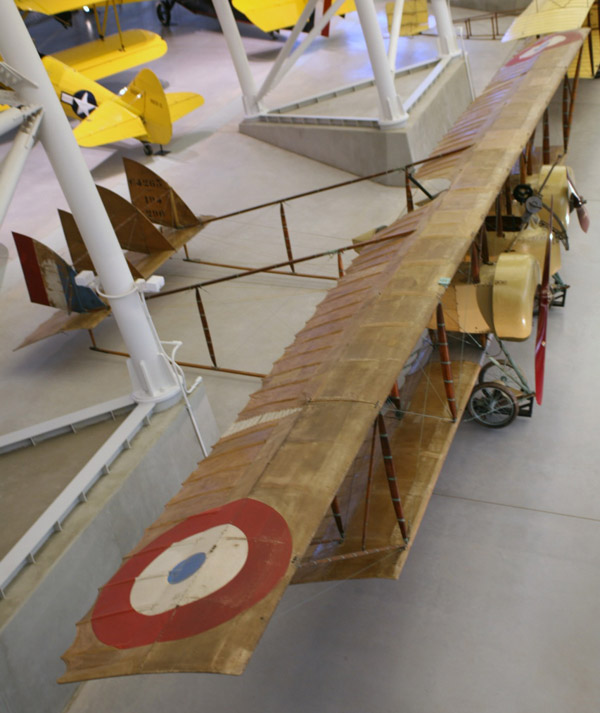
The twin-engine G4 had a much better range, speed, climb rate and ceiling and served until 1917.
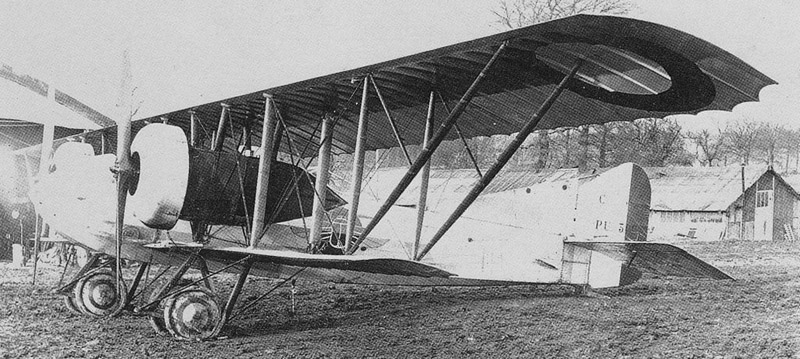
The twin-engine G6 was the first with a straight fuselage. It was produced in 1917-18 as a bomber/observation plane
Types
The list is rather impressive, so for clarity it has been decided to separate the prototypes and production planes (more than 5).
Production planes:
- Caudron Type A (1910) 7 trainers
- Caudron Type D (1911) 13 trainers
- Caudron Type F (1913) 15 trainers (China)
- Caudron Type G3 (1914) 2700+
- Caudron Type G4 (1915) 1240
- Caudron R.4 (1915) 249
- Caudron R.6 (1916) 750
- Caudron R.11 (1917) 370
- Caudron C.23 (1918) 54
Prototypes:
- Hydroaéroplane Caudron-Fabre floatplane 1911 1
- Caudron Type B 1911 nacelle type trainer 1
- Caudron Types M and N 1911, monoplan racers, at least 4
- Caudron Type C (1911) nacelle type trainer 2
- Caudron Type E (1911) nacelle trainer 4
- Caudron Type G (1913) G1, preseries nacelle type observation bipanes 2
- Caudron type H (1913) amphibious plane 2
- Caudron type J (1914) amphibious plane 3
- Caudron Type K (1913) floatplane 1
- Caudron Type L (1913) Floatplane 4
- Caudron Type P (1914) Prototype bomber
- Caudron R/R.3 (1915) Prototype bomber
- Caudron R.5 (1915) Prototype bomber
- Caudron R.7 (1915) Prototype bomber
- Caudron R.8 (1916) Prototype bomber
- Caudron R.9 (1916) Prototype bomber
- Caudron R.10 (1917) Prototype bomber
- Caudron R.12 (1917) Prototype bomber
- Caudron C. 02 fighter 1917
- Caudron R.13 (1918) Prototype bomber
- Caudron R.14 (1918) Prototype bomber
- Caudron C.22 (1917) prototype night bomber
Caudron A (1910)
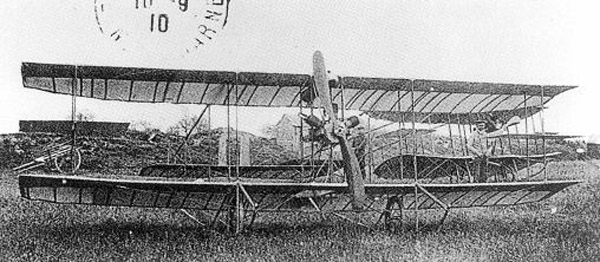
The Caudron A N°2 in 1911, modified with with direct drive tractor prop and interplane ailerons
The Caudron A was the first “production” model by the Caudron brothers, previously briefly associated woth the Société Anonyme Français d’Avaiation (S.A.F.A.), therefore the very first prototype was showcased in the Paris Aero Salon as the S.A.F.A. Biplane. The previous prototype was flown as a glider, towed by a galloping horse, whereas it was designed in 1908 to be tracted by a pair of 30 hp (22 kW) Farcot engines. This early model was followed by the proper Type A No.1, a two-bay, equal span pusher biplane, smaller and lighter than the glider. It was was fitted with a 25 hp (19 kW) three-cylinder Anzani engine placed left to the pilots with a two bladed propeller and transmission by chain and driveshaft. There was a fixed rectangular horizontal surface with four booms which helped lateral control as well as elevation. Small rectangular rudders above the tailplane helped elevation in any case. The lower pair was particular as to be connected to the lower wing by struts, curved upwards to form undercarriage skids, doubled with road-wheels, soon a Caudron trademark feature. It flew several times wit success but crashed the 9th time and when refitted, the engine was modified to drive the propeller by shaft, directly instead of with chain. The Caudron Type A No.2 had the engine mounted in a mid-gap position, at the front. The interplane ailerons had been relocated between the upper and lower wings for improved lateral control. The derived type A bis had a 5-cylinder Anzani rated for 45 hp (34 kW), as a larger two-seaters. In all seven planes were built, used for training, but in a casuel manner, not in a regulr unit. They were 8 m (26 ft 3 in) long, 8 m (26 ft 3 in) large (wingspan), weighted 270 kg (595 lb)and caâble to reach 85 km/h (53 mph; 46 kn) thanks to their Anzani 5-cylinder air cooled semi-radial engine rated at 34 kW (45 hp).
Caudron D (1911)
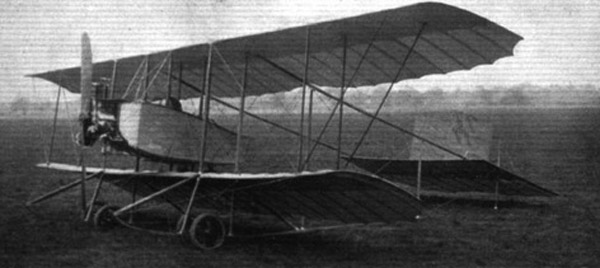
A Caudron D showing the suspended nacelle and typical Caudron twin-boom, it first flew in December 1911
The Caudron D succeeded to the prototype Caudron C, and even mistaken for it in the UK, as shown in 1911 W.H. Ewen catalogue; Only about 13 planes were built, and it first flew in December 1911. In fact just one was sold to the UK, other went into China (three), and they tried various engines. They could be considered as drafts for the next Type F, the true forerunner of the famous Type G. The Chinese variant were propelled by the 34 kW (45 hp) 6-cylinder Anzani radial engine, uncowled. The type unique A bis had a 37 kW (50 hp) Gnome Omega 7-cylinder rotary engine mounted with an oil-deflecting cowling over the upper half. One called Caudron D-2 was tested as a two-seater with a 45 kW (60 hp) 6-cylinder Anzani, raised decking ahead of the cockpit and modified struts suspension flew in June 1912 to London. They had a 125 l (27 imp gal; 33 US gal) tank giving a 3 hours endurance. Phillipe Marty flew with a second D-2. Ewen’s flying school licenced-produced or boufht at least one. The rest (sesquiplane and equal plane versions) were used by the French Air Force for beginners training, and likely retired in 1914.
Design
The late 1911 Type D was a single-seater, twin boom, two bay tractor biplane with equal spans, later redesigned as a sesquiplane. It had an interwing nacelle and was smaller than the Type C, powered by the small 26 kW (35 hp) 3-cylinder Anzani radial engine. As a sesquiplane, the span ratio was even further reduced. The wings were fabric covered wings with plans apart and angled tips, no stagger, and vertical, parallel interplane struts and conventional wire bracing. Wing warping for roll control was allowed thanks to the rear part of the wing being flexible. The simple flat sided nacelle was short and placed mid-wing by using two more pairs of interplane struts while the Anzani engine was uncowled at the front. The empennage was attached on upper and lower girders and strengthened with two diagonal struts either side. The lower members ended underbelly as skids mated with twin, rubber sprung landing wheels.
Specifications
Dimensions: 6.7 x 9.7 m (22 ft x 31 ft 10 in -upper plane), Wing area: 24 m2 (260 sq ft)
Weight: 220 kg (485 lb) empty, 350 kg (772 lb) loaded.
Engine: 3-cylinder radial, 26 kW (35 hp) or 30/34 kW (40/45 hp) Anzani/ 37 kW (50 hp) Gnome rotary
Performances: Top speed 90 km/h (56 mph; 49 kn) 10 min to reach 500 m (1,600 ft).
Caudron F (1913)
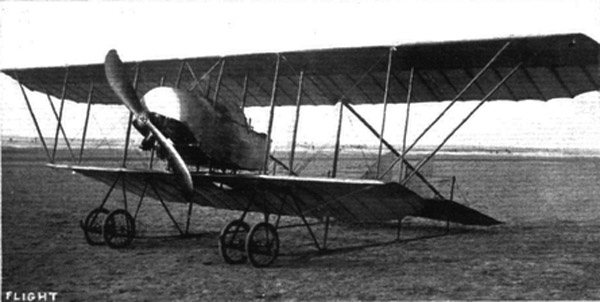
A Caudron F in 1913. This was the blueprint for famous the Type G
This single seat sesquiplane looks like the wartime Type G that followed and is almost a pre-serie, with a dozen purchased by China and two other had civilian use, trying different engines. These won in 1913 the first two places in the cross-country race at Reims, Pierre Canteloup doing the first loop-the-loop biplane.
The Type had the same layout as previous Caudron biplanes, a twin boom tractor with a short central nacelle and twin fins. Unlike the B and E, the Type F had a redesigned nacelle and vertical tail shape. By 1913, the Type F was a sesquiplane, like the Type E, from the start. It had a wire braced two bay biplane, rectangular plan and angled tips. The sesquiplan ratio was 1.8 without stagger, parallel vertical interplane struts. The nacelle had its sides curving upwards in profile to the engine. The upper edges were straight with a curved decking running forward rounding into the engine cowling. In front was located the 37 kW (50 hp) Gnome Omega seven cylinder radial engine. The cowling varied in time, and the gap at the bottom allowed lost oil to escape.
One was shot with an uncowled Anzani 10-cylinder radial engine. The forward cockpit’s rim was raised up, better enclosed and the nacelle was supported above the lower wing on two pairs of enclosed interplane struts. Its empennage was supported on a pair of parallel girders, the upper ones being attached to the upper wing spars while the lower ones ran under the lower wing supported by inverted W-struts. The aircraft could land on skids carrying two rubber sprung landing wheels.
In 1913 two of the Type D had been sold to China and the company obtained an order for twelve of the single seat variant Type F, which were operated under Emile Obre and Bon at Beijing. They also organised an aviation centre. Two Type Fswere showcased at Reims in September 1913 and René Caudron won first prize in the biplane category at 94 km/h (58 mph) and fastest lap time. In November, Pierre Chanteloup flew the Gnome powered version making the first biplane loops and other aerobatic manoeuvres at Issy-les-Moulineaux. The Type F was followed by the Type G-1, which was a preserie with a new nacelle for observation ad two were built and evaluated by the Army.
Specifications
The Type F was a monoplane, 6.40 m (21 ft 0 in) long, 10.10 m (33 ft 2 in) in wingspan, 2.60 m (8 ft 6 in) high, 280 kg (617 lb) heavy, and propelled by a Gnome Omega 7-cylinder rotary, 37 kW (50 hp) (2-bladed prep.), and it was capable of 100 km/h (62 mph; 54 kn) flying at least for 4.5 hr. It was able to reach 5 min to 500 m (1,600 ft) and landed at 40 km/h (25 mph).
Caudron G.3 (1914)
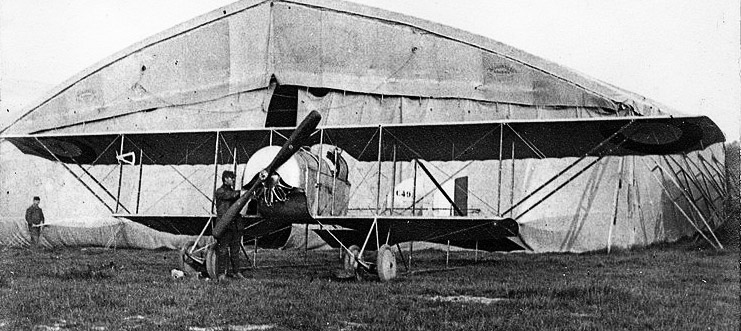
An early Caudron G3 in 1913.
The Caudron G.3 designed by René and Gaston Caudron was a development of the G.2, extensively military tested. The final model first flew in May 1914 at Le Crotoy aerodrome. The G.3 short crew nacelle had the same nose tractor rotary engine, and open tailboom truss. A sesquiplane biplane steered by using wing warping and soon conventional ailerons for production aircraft. The G.3 was not armed but later a light machine guns and small bombs were carried. The G3 was ordered in gargantuan quantities when the War broke out. The Caudron factories themselves delivered 1423 out of the 2450 built in France alone. 233 were also built in UK, 166 in Italy and more in other countries, as 27 countries used it, either during or after the war. The Caudron brothers did not even charge a licensing fee for the design, calling this patriotism.
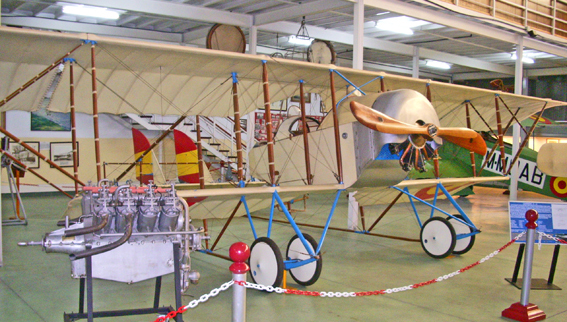
A Caudron G3 in Spain.
The G.3 first was assigned to Escadrille C.11 at the outbreak of war, performing reconnaissance missions that were crucial, all in good visibility. With time they joined more units. However low performance and no armament made it too a sitting duck and by mid-1916, the G.3 was retired and replaced by the G.4. The Italians used it extensively until 1917, and the British RFC still flew it by October 1917, for strafing attacks, while the Australian Flying Corps used the G.3 in the Mesopotamian campaign of 1915–16.
The G.3 own qualities were appreciated to such a degree, its career went on as a trainer until well after the end of the war. The Chinese Fengtian clique G.3s remained in service until 1931, some were even captured by the Japanese. After the war, one of these G.3 was flown by Adrienne Bolland in 1921, making the first crossing of the Andes by a woman. The G.3 was followed in production by the G.4, a twin-engined development. Many have been preserved to this day, including some in flying conditions, like at La Ferté Alais historic meeting near Paris. The G.3 main type was the A.2 used for artillery spotting as far as Russia and the Middle East. The D.2 was a two-seat trainer with dual controls. The E.2 was a more basic trainer. The R.1 was a United States Air Service taxi trainer with no wings. The L2 had a 100 hp Anzani 10 radial engine. Gotha actually copied the G.3 (LD.3/LD.4 for “Land Doppeldecker”).
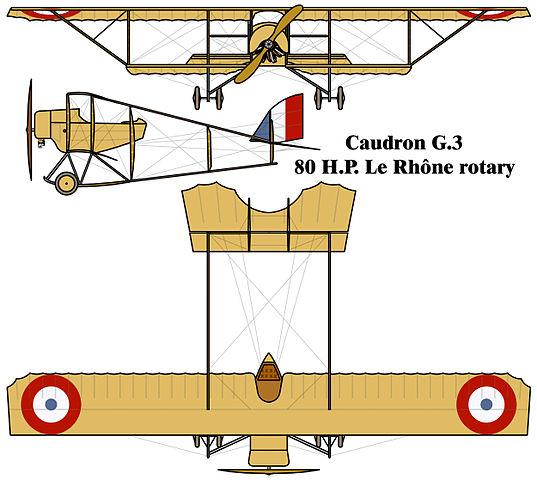
Caudron G3 drawing.
Specifications
Dimensions: Length 6.40 x 13.40 x 2.50 m (21 x 44 x 8 ft 3 in)
Weight: 420 kg (933 lb)/710 kg (1,577 lb) max takeoff
Le Rhône 9C rotary, 60 kW (80 hp), top speed 106 km/h (57 kn, 68 mph) 4,300 m [2] (14,110 ft)
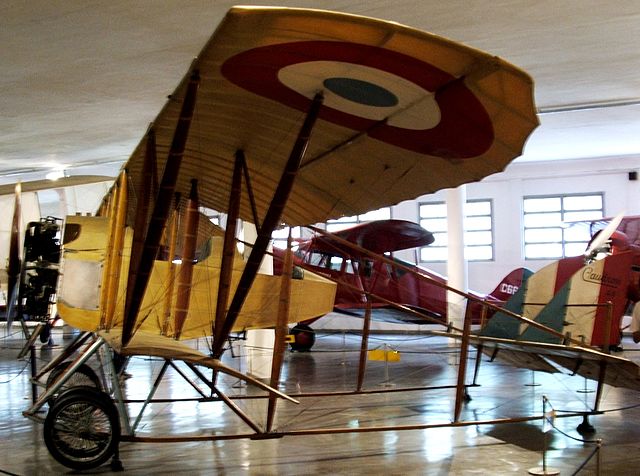
Caudron G3 in Brazil.
 Dorand
Dorand
Dorand Planes
About Dorand’s STAé
Pretty much all is known about the best known model of Dorand Aviation was related to the AR model designed by Georges Le Père. Dorand Aviation only served the official “Section Technique de l’Aéronautique (STAé) de Chalais-Meudon” headed by Colonel Dorand from 1916, of the Army reconnaissance branch. Initially, the first aeronautical laboratory in the world was l’Établissement central de l’aérostation militaire de Chalais-Meudon in 1877, specialized in observation balloons. It was tasked of producing, provide training, define the use and tactics of balloons. From 1909, aircrafts manufacturers multiplied in France, and in early 1916 it was observed a lack of technical coordination between the command and capabilities of manufacturers, with development delays and technological dead ends. To remedy this situation, Deputy Secretary of State for Aeronautics René Besnard and Minister of War General Gallieni created the Section technique de l’aéronautique, headed by the Colonel Emile Dorand that previously was in charge of the Chalais-Meudon establishement. Abbréviated STAé, it moved to Issy-les-Moulineaux, as “Établissement d’expériences techniques d’Issy-les-Moulineaux”, and comprised workshops, laboratories and wind tunnels, ground testing facilities, all under supervision of the war ministry. Dorand acted as the well-needed interface between the Command and manufacturers, testing engines and plane, writing sub-specifications and reports, tasking various manufacturers in certain areas, creating connection between them.
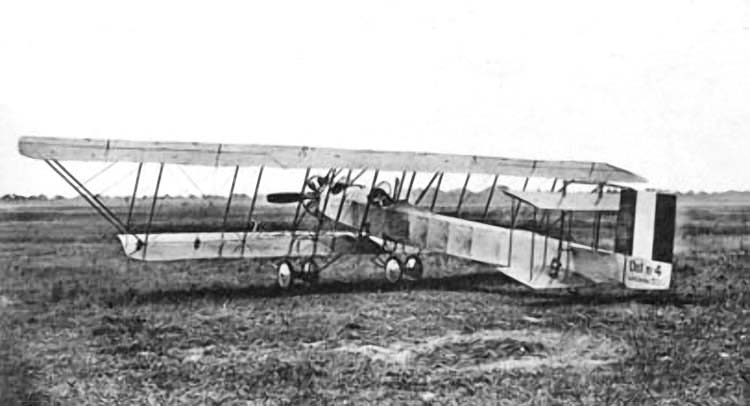
(unknown date – airwar.ru)
The first task of the organism was to create a tractor propeller observation aircraft armed to withstand back attacks from the Fokker E.III. Later finding a solution to fire through the propeller disk, and a three-seater, twin engine observation model, later to define new aircraft engines specifications and eventually in 1918 the STAé was responsible for aircraft, engines, armament, flight test and research. In January 11, 1918, Dorand left and was replaced by Albert Caquot.
Military engineer and officer Jean-Baptiste Émile Dorand started working on planes going back to 1908 and his biplane. He also created for the army a reconnaissance plane with some armour in 1913. More importantly he designed in 1914 at the Meudon facility, the first production model, named DO.1. Only 12 were built from August 1914, but it was found mediocre and soon replaced by the Farman MF-11 Pusher. Later in 1916 he will design his first success, the AR.1, mass-produced for many air forces and used well after the war around the world. He went on as an engineer for various projects and his son René made his name famous again with a very innovative model in 1938 through the Syndicat d\’Etudes de Gyroplane, creating the forward-thinking Dorand G.II or G.20, using a counter-rotative system and V-tail to get rid of the stabilizing propeller. This was pretty much the ancestor of counter-rotative helicopters postwar, 20 years in advance of any other models.
Dorand Models
Dorand biplane 1908
In 1908, the French military ministry seconded Captain Max Dorand (Max Dorand) with a special task: to wipe his nose with a civilian who could not build a suitable military aircraft. The captain approached the matter strictly scientific and began with the construction of a scale model of the chosen aerodynamic scheme. He got a normal kite with weight balancing and four (originally) rows of wings. Four rows of engine wings in 34 hp. He did not pull, and the number of wings was reduced first to three, and then to two. With two, they say, even managed to fly a little, and this was the first specially military aircraft. It was emphasized that its special arrangement provides an ideal view for reconnaissance, since the wings are all higher than the pilot’s potholder and did not prevent him from observing the earth. Unfortunately – and maybe, and fortunately – normally this structure did not fly. But the captain (by that time already a major) was carried away – and in the world war France entered a sufficiently sane company Dorand, which built quite a lot of aircraft of an entirely classical scheme. Apparently, its founder knew how to learn from his mistakes.
Dorand 1913
The first plane was designed in 1913, simply named “Dorand 1913”. http://airwar.ru/enc/fww1/dorandai.html
In 1913, General Bernard proposed the classification of armored aircraft, where the first class – single scouts of short-range, the second – double long-range, the third – double fighter-scouts and the fourth – heavy multi-seat for special missions. In the same year, under the leadership of Emil Dorand (Jean-Baptiste Émile Dorand), the aircraft was designed and built to meet the requirements of the third and fourth grade. This machine received an unofficial designation “Armored fighter” was a triple three-stand biplane equipped with two Le Rhone engines with 80 hp. The aircraft’s armament consisted of two 8-mm Hotchkiss machine guns installed in the front and rear cabins (the pilot was in the middle). In the future it was planned to replace the machine guns with the 37 mm Hotchkiss gun. The protective reservation was made in the form of steel plates 3 mm thick installed on the sides and in the floor of the cabins. From the first flights it became clear that the car was heavily weighted and clumsy. Finish it did not, did not even get an official designation. The only copy was handed over to the CRP (Camp Retranche Paris).
Dorand DO.1 (1914)
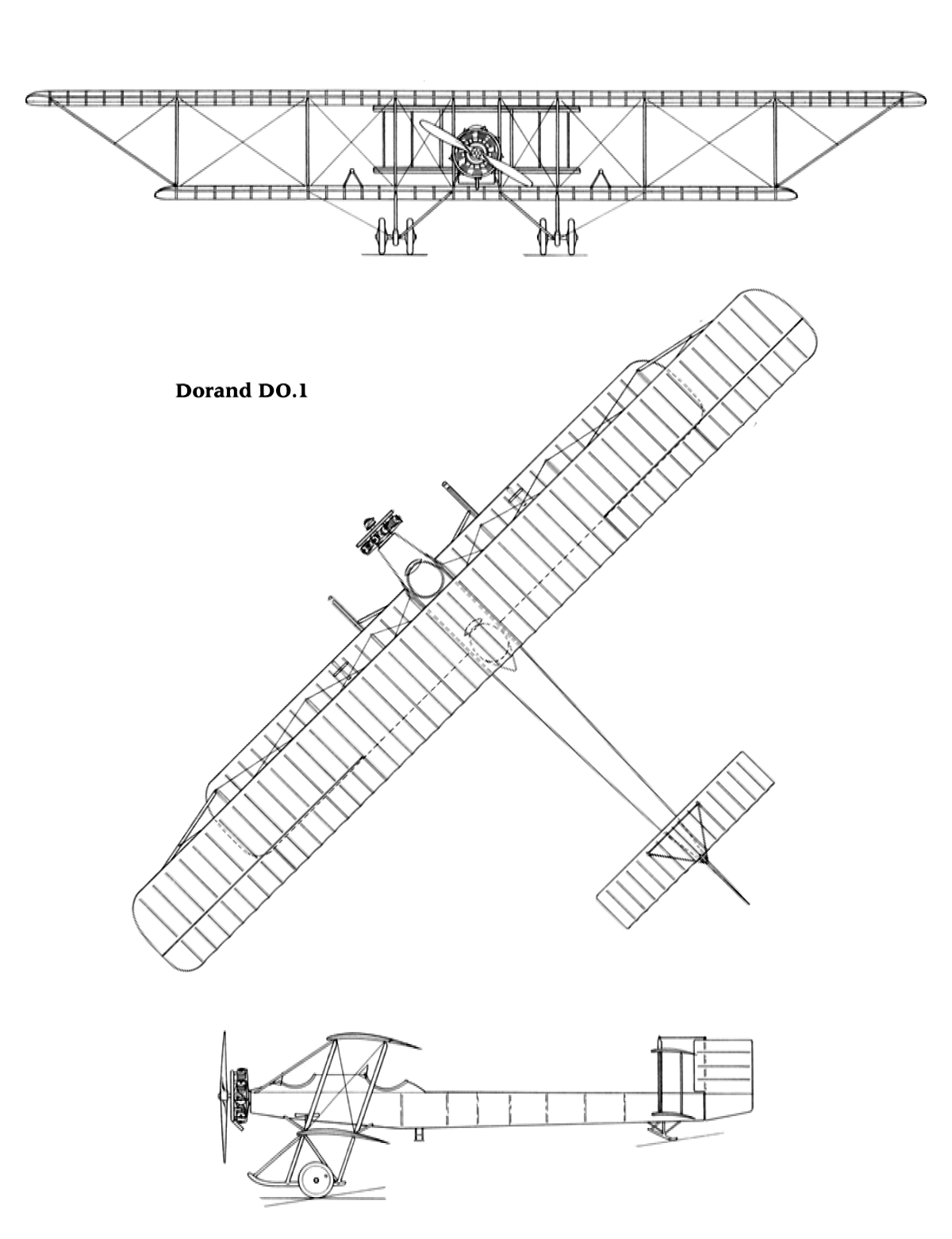
Blueprint – 3 views (unknown author – airwar.ru)
In 1914, General Bernard published requirements for an armored aircraft for long and short reconnaissance. Several companies like Bleriot, Breguet, Clement-Bayard, Deperdussin, Ponnier, Voisin and Dorand started work and designed prototypes for these requirements. The one designed by Jean-Baptiste Émile Dorand received the designation DO.1. It was a biplane with a single fuselage in framed canvas and double tailplane, equipped with a single Anzani rotative engine rated for 85 hp. The aircraft’s armament consisted of one 7.7-mm Lewis machine gun mounted in the front cockpit of an observer on a mobile turret. Steel plates protected the crew at a total weight of 90 kg. This two-seater had a wingspan of 15.00 m, length of 10.07 m, with a load-bearing area of 50.00 m², motorized by an Anzani engine developing 85 hp, for a top speed of 108 kph and a 2800m ceiling. Despite the fact that the flight characteristics of the DO.1 were judged all mediocre by the the authorities, about a dozen DO.1 were ordered. The six first DO.1s equipped in August 1914 the squadron DO22, formed for the occasion. The others entered the DO14 squadron in December 1914. But in early 1915 already, they were all replaced by the better Farman MF.11.
Specifications
Dimensions: Wingspan, 15m, Length 10.07m, Height ?, Wing area 50.00m2
Weight, 1510 kgs empty, maximum take-off 2000 kgs
Engine: Type 1 PD Anzani, 85 hp
Maximum speed 108 kph, 96 kph cruise speed, autonomy 4h, ceiling 2800m
Crew: 2, pilot and observer
Armament: one 7.7-mm Lewis machine gun on the turret
Dorand AR.1 (1917)
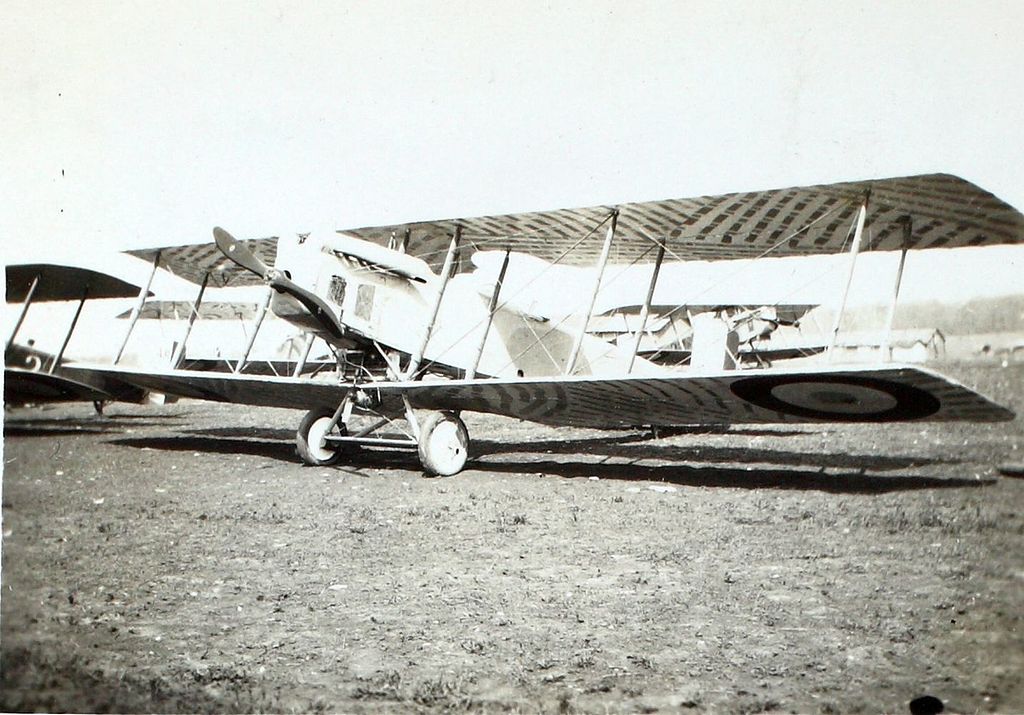
Dorand AR.1 – San Diego Air and Space Museum archives
 Farman
Farman
Farman Aviation Works
Avions Farman was a French aircraft manufacturer founded by the brothers Richard, Henri, and Maurice Farman. This was not an oddity as many early aircraft manufacturers were brother’s enterprises. Like so many follows-up of the Wright’s first flight and Blériot exploits, they started their business in 1908, and the company went on designing 200 models and engines until 1936 (even cars until 1931) especially large aircrafts, bombers and passenger planes. The French nationalization of the time made the company assimilated in the larger group called the Société Nationale de Constructions Aéronautiques du Centre or SNCAC, and postwar it was liquidated in 1949, its assets distributed between SNCAN, SNCASO, and SNECMA. In 1941 however the brothers briefly resurrected the firm as the “Société Anonyme des Usines Farman” until it was absorved by Sud-Ouest in 1945. Marcel Farman re-funded the company again in 1952 under the same name, but it failed to secure orders and was dissolved for good 1956.
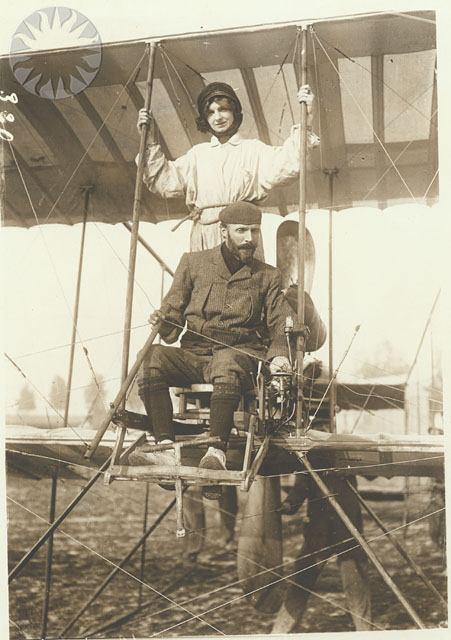 Farman was one of the most prominent manufacturers worldwide when the war broke out in 1914. They exported a large part of their production of traditional, reliable pushers. In 1907, Henry Farman started work at Châteaufort, Yvelines, on a Voisin and started to improve the design later derived as the Farman I/Voisin-Farman I. In 1908 the model was modified again, covered with ‘Continental’ rubberized fabric, was fitted with side-curtains and re-designated Farman I-bis. Ailerons were added right after the Wright’s brothers Le Mans flight in August 1908, and the next Farman II was built by the Voisin brothers with refinements specification, which later went to J.T.C. Moore-Brabazon in England, renamed the “Bird of Passage”. This third-party technology transfer shocked and angered Farman, which cut all relationships with Voisin in 1909 and from then on concentrated on his own design. From then on, two brothers designed planes, Henry Farman planes being called with a HF prefix, and those of Maurice, MF. Some were collaborative works and prefixed “F”. It should be noted that the Farmans were born from British Parents living in France and were fluent in English, helping them piercing in the UK which, the RFC being their main export destination during WW1. As an Anglo-French aeronautical engineer, Richard Farman quickly was called “Dick” Farman and frequently crossed the channel, or the Atlantic to help their business grow.
Farman was one of the most prominent manufacturers worldwide when the war broke out in 1914. They exported a large part of their production of traditional, reliable pushers. In 1907, Henry Farman started work at Châteaufort, Yvelines, on a Voisin and started to improve the design later derived as the Farman I/Voisin-Farman I. In 1908 the model was modified again, covered with ‘Continental’ rubberized fabric, was fitted with side-curtains and re-designated Farman I-bis. Ailerons were added right after the Wright’s brothers Le Mans flight in August 1908, and the next Farman II was built by the Voisin brothers with refinements specification, which later went to J.T.C. Moore-Brabazon in England, renamed the “Bird of Passage”. This third-party technology transfer shocked and angered Farman, which cut all relationships with Voisin in 1909 and from then on concentrated on his own design. From then on, two brothers designed planes, Henry Farman planes being called with a HF prefix, and those of Maurice, MF. Some were collaborative works and prefixed “F”. It should be noted that the Farmans were born from British Parents living in France and were fluent in English, helping them piercing in the UK which, the RFC being their main export destination during WW1. As an Anglo-French aeronautical engineer, Richard Farman quickly was called “Dick” Farman and frequently crossed the channel, or the Atlantic to help their business grow.
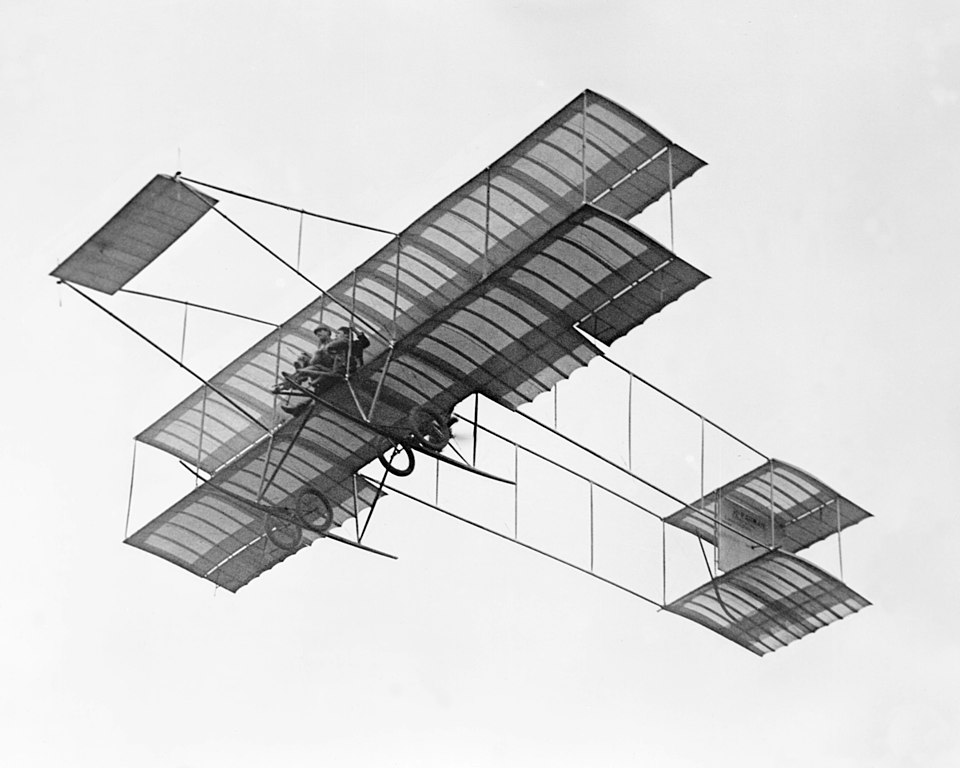
Farman III biplane flown by Louis Paulhan at Dominguez air field near Los Angeles, January 1910
Farman Models in detail
The first model in 1909 properly from Farman, was the Farman III, a “cabane” type pusher propelled by a 4-cylinder inline water-cooled Vivinus and later a more capable 50 hp (37 kW) Gnome Omega rotary engine which had quite a success on the civilian market and was frequently showcased at reims and elsewhere. It became a hit in UK after Drawings and details of the aircraft were published by Flight, being known as the influential “Farman Type”, spawning a lot of imitations including Bristol Boxkite, the Short S.27 and the Howard Wright 1910 Biplane, the first bordering plagiarization. it had quite some commercial success, and was also licenced to Albatros Flugzeugwerke, known as the Albatros F-2. Two sub-types were known, the Type de Course 1910, lighter and with a shorter wingspan, and the Michelin Cup biplane the same year with at the contrary had a longer wingspan, 2.5 m (8 ft 2 in) extensions on the upper wing and longer nacelle for longer flights for a 12h endurance. The type became also the most prominent training type in France, and it was used by the Greek military during the Balkan Wars for reconnaissance. Henri and Maurice models differed in some details, but both Brothers decided to collaborate from 1912 onwards.
The Farman MF.7 Longhorn was the first military model after a long period dedicated to civilian models of the Farman III type. It should be noted that it was preceded by the HF.14 floatplane. Designed by Henri, from July 1912, and developed from the Farman HF.6, this was a two seat reconnaissance biplane pusher built at Boulogne-Billancourt north of Paris before the war in relatively small quantities. It had a fuselage of wood and steel construction, with ailerons installed only on the upper wing and interconnected. The plane was convertible to wheeled version and had two main floats and a 7-cylinder 80 hp air-cooled Gnome Lambda rotary engine. It was mainly used as a racing plane and from 1913 by the military as a trainer. One was the first biplane to make a loop. The MF.7 was the first mass-produced military model. But it was preceded by a line of civilian models used for training and private owners, at the Maurice Farman’s flying school at Buc. In October 28, 1910 one won the Coupe Michelin prize, another in March 1911 won another Michelin Prize for passenger-carrying over 600 km. Géo Fourny also won an endurance record, 720 km or 450 mi in 11 hr 29 min 11 s in September 1911. This palmares gave confidence to Maurice Farman to compete for the competition held in November 1911. The model was widely used until 1915, then reclassed as a second-line trainer, by several air forces including 13 squadrons of the RFC. Some still flew in 1922.
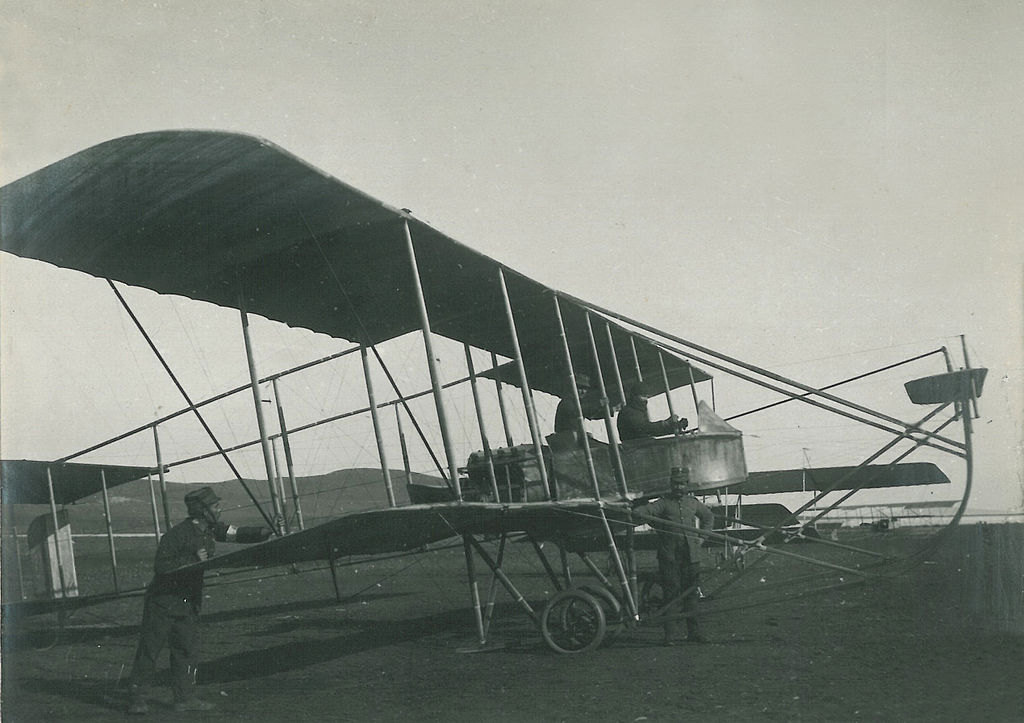
Farman MF.7, the famous “Longhorn” due to the forward skid arrangement
Types
As usual, production models are in bold, with production figures and dates
- Farman III (?)(1909)
- Farman MF.7 Longhorn (?500)(1913)
- Farman MF.11 Shorthorn (?)(1913)
- Farman HF.14 – two-seat floatplane (?)(1912)
- Farman HF.20 – reconnaissance biplane (?)(1913)
- Farman F.30 – two-seat military biplane (400)(1915)
- Farman F.40 – single-engined reconnaissance aircraft (?)(1915)
- Farman HF.30 – fighter biplane (1916)
- Farman F.31 – fighter prototype (1918)
- Farman F.50 – biplane bomber (100)(1918)
 FBA
FBA
Franco-British Aviation, the seaplane specialist
_Type_C_drawing.jpg)
The Franco-British Aviation Company or “FBA” was a French-British seaplane manufacturer funded en 1913 in London. This entry should be in in the British section, but activities were quickly relocated to France, as the main designer, Louis Schreck, was French. He was technical director of the French subsidiary located in Argenteuil but took over global operations. The first task of the company was to develop a seaplane hull, derived from the Donnet-Lévêque Type A. This was a single-engine biplane, with a pusher engine mounted on struts mid-wings. Called FBA- Leveque at the beginning it was later renamed FBA Type A and entered production for the French Navy. This was a success, and it was soon widely exported among the entente nations: France, United Kingdom and the Russian Empire.
Production went on with the Type A in 1914 propelled by a 100 hp Gnome Omega and also used by Austria-Hungary (before the war), Brazil, Denmark, Italy, and Portugal. Productions figures are unknown but the Type A was followed by the near-identical Type B (Gnome 9B) in 1915 (150 built) and Type C (Gnome 9c, 130 hp) in 1916 (300) built, whereas since 1916 a revised version Type H also flew, the most largely built of all, with 1400 machines. The Type H proceeded from an admiralty request that wanted 1500 seaplanes to track U-boats over the Atlantic. The program was defined by Admiral Lacaze to arm naval air bases, which ordered 500 Donnet-Denhaut 150 hp seaplanes, Lévy-Le Pen models and and 500 FBA type H. Of these, 400 FBA were built in Argenteuil (Val-d’Oise) and the remainder 100 in Paris in Pierre Levasseur factories (which would be a main contractor for the French naval air arm in the interwar, in particular for the aircraft carrier Bearn). Italy ordered 900 type H at the end of 1916, which could not be met by the parent company. A new assembly plant was setup in Nice and a construction license was granted to Savoïa, cranking up 892 type H under license with Hispano-Suiza engines under licence by Isotta Fraschini. The US Naval Air arm also received 11 Type H for testings.

FBA Type H in Belgium
The Ultimate evolution of the FBA Type A, the Type S of 1917 was a model with equal wings without stagger, pilot and observer sharing the same cockpit. The FBA Type S was powered by a 280 hp Lorraine or Hispano-Suiza engine, the hull hydrodynamic properties were refined and the tail section was reworked. 250 were ordered, and received by the French Navy at the end of 1917 but only about 180 units were in actual service before the Armistice. The type was still used in 1923. The Type H was arguably the most successful model of the lineage, capable of patrolling four hours at 140 kph long distance from the coast. They all had machine guns for strafing attacks, ASW grenades and even sometimes light 37mm guns.
After the war in 1922, Emile Paumier became technical director and later developed the FBA Type 10 to 13, all prototypes never accepted for service. The Type 14 was a training model based on the Type H (20), the Type 16 was another prototype that prefigurated the successful Type 17, of which 348 were built, also used by the US Navy, Brazil and Poland from 1923. From the Type 19 (1924, 9 built), the company abandoned the standard pusher configuration for a tractor engine. From there, however production was small, single models for the civilan markets. The lack of orders precipitated the end of the company in 1931. In 1934, FBA was acquired the Bernard which in turn went bankrupt in July 1935.
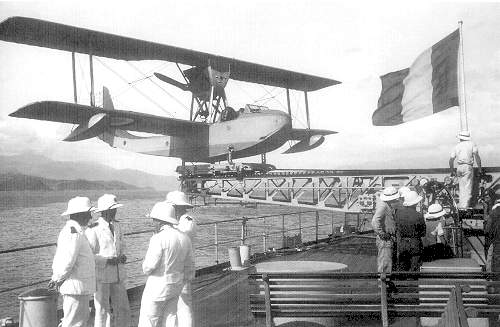
FBA Type S onboard a French Cruiser in the early 1920s
Types
As usual, production models are in bold, with production figures and date.
- FBA Type A 1914 (?500)
- FBA Type B 1915 (150)
- FBA Type C 1916 (300/c78?)
- FBA Type H 1916 (1400?)
- FBA Type S 1917 (500)

FBA Type B of the RNAS, close view of the cockpit
 Hanriot
Hanriot
Aéroplanes Hanriot et Cie.
Aéroplanes Hanriot et Cie. called simply “Hanriot” was a French aircraft manufacturer started pioneer of aviation. René Hanriot in 1910 transformed is own private workshop into the Monoplans Hanriot Company Ltd. until 1916 and then became Hanriot-Dupont, which produced fighters and reconnaissance planes. The main manufacturing plant was at Bétheny (a suburb of Reims), Boulogne-Billancourt and later Carrières-sur-Seine and Bourges. The company changed hands and passed through structural changes until 1936. By then the company merged with Farman and was known “Société Nationale de Constructions Aéronautiques du Centre” or SNCAC, merged into yet another public consortium after the second world war. His early monoplanes had popular boat-like fuselages which made the pride and joy of many gentlemen sportmen, and then during the war produced the awesome HD.1 and 2 fighters.
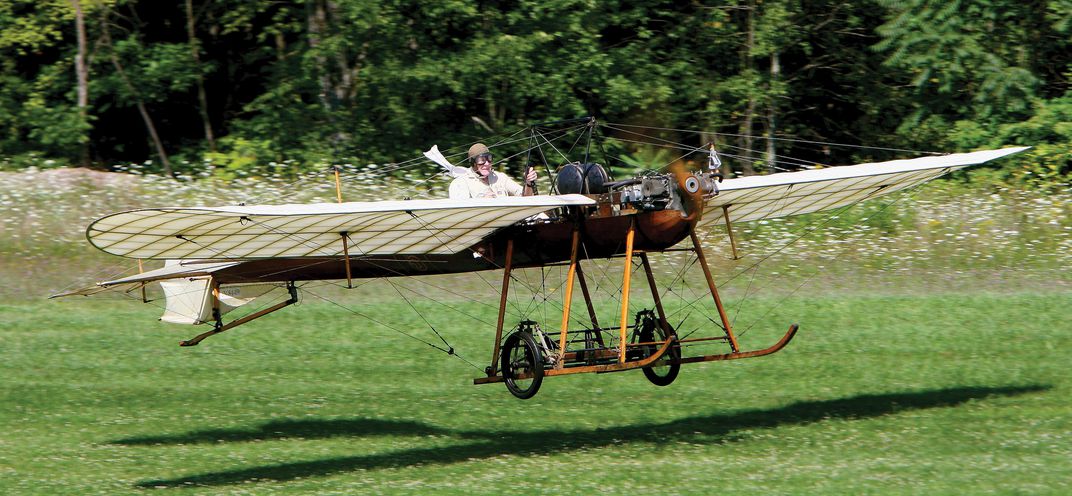
Hanriot Type V monoplane 1910
René Hanriot himself was a racer, driving motor boats and Darracq sportcars. Perhaps bored and thrilled by the “brand new thing” that was aviation, and had its first aircraft built in 1907, but was not able to take off and toyed with it until late 1909. This monoplane had a wire-braced wooden fuselage reminiscent of the Blériot XI, superseded similar monoplanes soon exhibited at the Brussels Exhibit in January 1910. These were slender wooden monocoque, boat-like fuselages powered by a 20 hp Darracq. With Louis Wagner, another Darracq pilot, he created a flying school at Bétheny (Reims). He used to test his ideas with models propelled by a tiny 2 kW (3 hp) Duthiel-Chalmers engine.
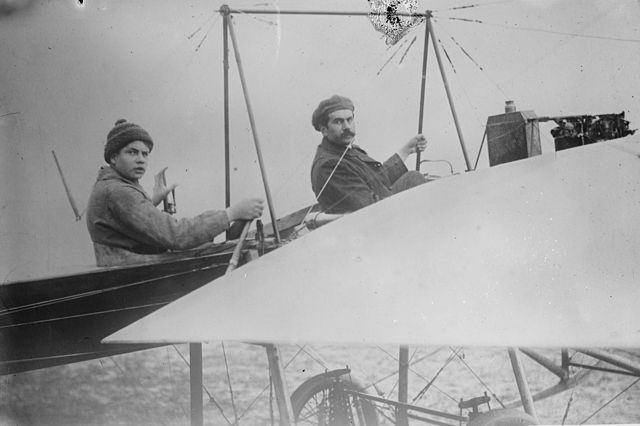
Early French aviator René Hanriot and his son Marcel in a Hanriot two-seater military monoplane 1911.
1910 as a great year of Hanriot that multiplied types and air shows in France and UK. His own 15-year-old became the youngest certified pilot, soon a proficient and daring competition flyer. René retired himself from competition to focus on design and attempted reach the military with his 1911 military two-seater. The model undertook French military trials, but failed because its fuselage was too slender, leaving the crew unprotected. It was too frail and underpowered for service in 1913 especially when pitted against Nieuport, Morane-Saulnier and Deperdussin monoplanes. However things changed when the company was able to attract Alfred Pagny, former Nieuport’s chief designer. His 1912 model had clear Nieuport influence, but this model failed to attract orders at the 1912 competition. René Hanriot was soon brankrupt, and had to sold his assets to Louis Alfred Ponnier. From then on the company was reorganized as the Société de Construction de Machines pour la Navigation Aérienne or CMNA. Marcel Hanriot was called up for military service, at 18 and Pagny replaced his father at the head of the company. Marcel Hanriot flew as pilot in 1914 air force bombers.
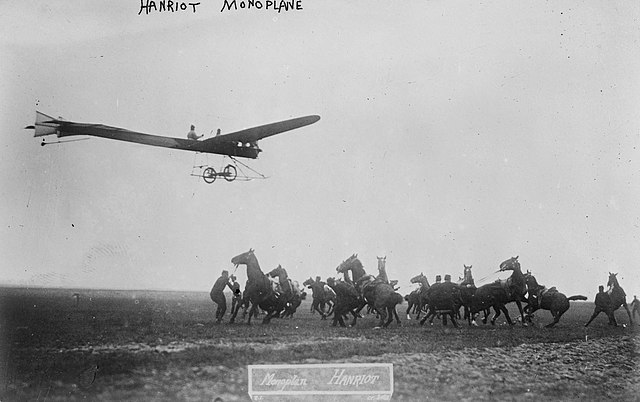
Hanriot 2 seaters
The German advance in 1914 threatened the CMNA-Ponnier factories in Rheims, which soon was found trapped behind German lines. René Hanriot therefore founded Aéroplanes Hanriot et Cie in Levallois. Having to start from scratch, the company started as a subcontractor, manufacturing components, later licenced aircraft like the Sopwith 1 A.2 and Salmson 2 A.2. By 1915 Marcel Hanriot was badly wounded in a raid and was released from military service, back to his father’s factory. Young engineer Emile Dupont joined in 1916. The first new model was the fighter HD.1 (For Hanriot-Dupont). The French air force rejected it for the more powerful SPAD VII. However the HD.1 gained orders by the Belgian and Italian air force, and soon became their favourite model. In fact success was such mith lore and more on orders than a brand new factory was setup in Boulogne-Billancourt. The HD.1 was also license-built by Macchi in Italy. By 1918, Hanriot had manufactured 5000 aircraft and 2000 worked in the Boulogne-Billancourt plant alone.
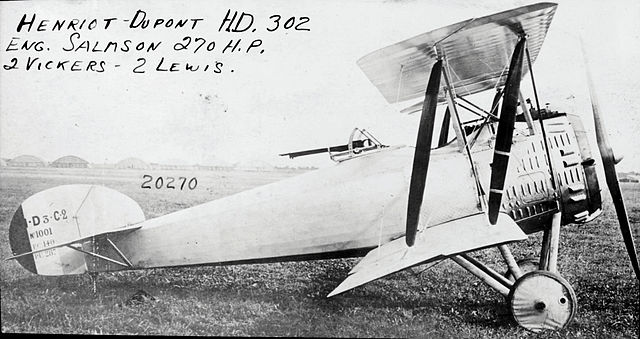
Hanriot HD.3
Compared to the HD.1, the following model were either small series or prototypes, until the end of the war. The HD.2 was only adopted by the US Military as a floatplane fighter, and the HD.3 was a two-seater with an observer/machine-gunner at the rear designed by Emile Dupont, proposed to the French Air Force, with 300 on order in 1918, only a third being delivered, in four versions. These models served with the Air Force and the Navy, but also with the Italian Aeronautica Militare.
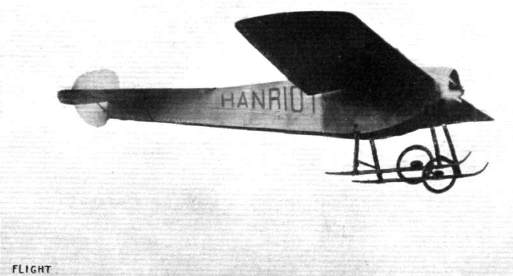
The 1912 Hanriot D.1 designed by Pagny (Nieuport) was later declined into the Ponnier D.III
All Hanriot model prior and during ww2 Models
Production models are in bold, numbers in brackets
- Hanriot 1909 monoplane (2)
- Hanriot I
- Hanriot Type II
- Hanriot III
- Hanriot IV Hanriot 1911 military two-seater (Type IV)
- Hanriot V Hanriot 1910 monoplane (Type V)
- Hanriot VI Hanriot 1910 monoplane (Type VI)
- Hanriot VII
- Hanriot VIII Hanriot 100 ch monoplane (Type VII)
- Hanriot IX
- Hanriot-Pagny 1912 monoplane
- Hanriot HD.1 1916 (1200)
- Hanriot HD.2 1917 (16)
- Hanriot HD.3/4 1917 (90)
- Hanriot HD.5 1918 prototype
- Hanriot HD.6 1918 prototype
- Hanriot HD.7 1918 prototype
- Hanriot HD.8 1918 prototype
- Hanriot HD.9 1918 prototype
- Hanriot HD.12 1918 prototype
 Morane Saulnier
Morane Saulnier
Another brothers history
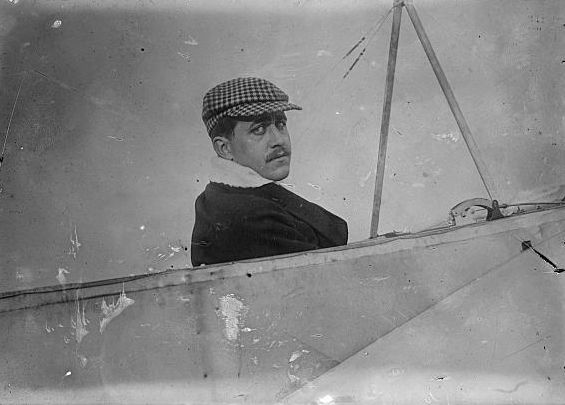
The company was born from the association of Raymond Saulnier and the Morane brothers, Léon and Robert.
Just before that it became with the Morane company, also called Morane-Borel because the brother’s partnership with Gabriel Borel. They used a wing-warping mechanism for control. Sportsman Jules Védrines (‘the fastest man on earth’) purchased it and won the Paris-Madrid race on May 26, 1911. This success triggered the brothers to start their own company. And later on, they met Raymond Saulnier, a gifted French aeronautical engineer which gained fame and recognition by its collaborated with Louis Blériot on his historic channel crossing. He will design most of the Morane-Saulnier models. He started operations with the Model A, a development of the Morane Brothers Védrine model. Many other models would follow until 1918.
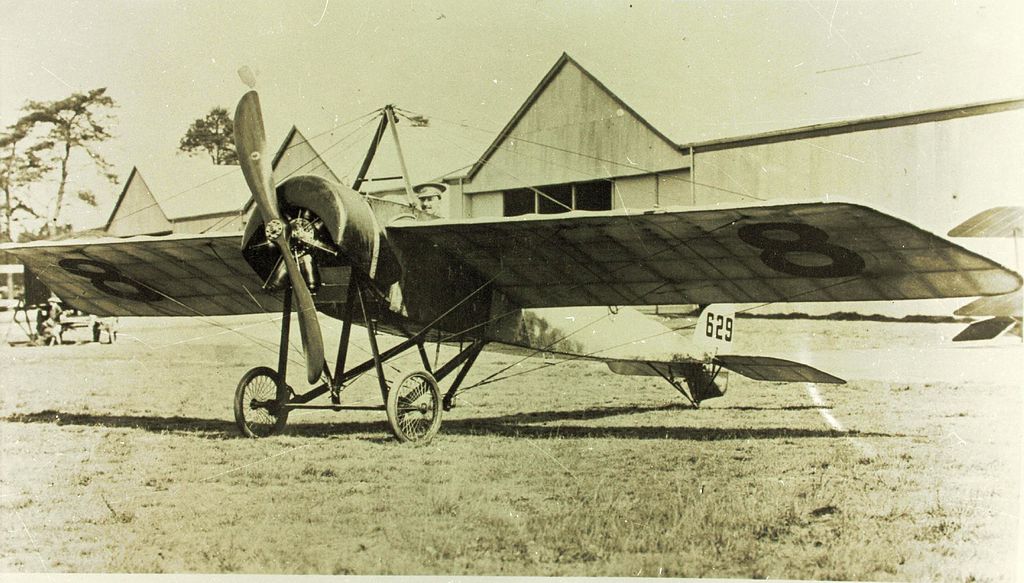
Morane Saulnier H used by the RFC
After the war, Morane-Saulnier specialized in parasol fighters, with famous models like the M.S.230 and M.S.315 and eventually the M.S.406, the mainstay of the French Air Force’s in 1939. Operated under German control during WW2, the company built the Fieseler Storch (after the war produced as the the MS.500 Criquet) and parts for other planes. Trainer and civilian aircraft models followed, semi-aerobatic tourers, but the company was bought and merged with Potez in 1962 (SEEMS) and in 1966 the civilian branch became SOCATA (which produced dozens of successful light planes), later purchased by Aérospatiale.
A detailed history of Morane Saulnier models
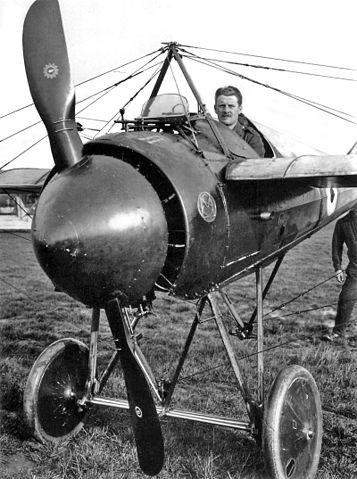 Other followed, until the most famous Morane-Saulnier G, a wire-braced shoulder-wing monoplane with wing warping. This led to the development of a high-performance serie in racing and records setting as well as a commercial success story. A 2-seater, the Type G and was reduced to produce the Type H, a single-seater with a faired fuselage. The next (natural) evolution was the Morane-Saulnier N single-seat fighter, declined later in the model L, with parasol wings above the fuselage. This allowed the observer a better view. Fitted with a N Type faired fuselage and new ailerons this gave the Morane-Saulnier LA. After a new complete redesign it evolved into the Morane-Saulnier further developed into a whole family of aircraft in the roaring twenties.
Other followed, until the most famous Morane-Saulnier G, a wire-braced shoulder-wing monoplane with wing warping. This led to the development of a high-performance serie in racing and records setting as well as a commercial success story. A 2-seater, the Type G and was reduced to produce the Type H, a single-seater with a faired fuselage. The next (natural) evolution was the Morane-Saulnier N single-seat fighter, declined later in the model L, with parasol wings above the fuselage. This allowed the observer a better view. Fitted with a N Type faired fuselage and new ailerons this gave the Morane-Saulnier LA. After a new complete redesign it evolved into the Morane-Saulnier further developed into a whole family of aircraft in the roaring twenties.
The Type N have the larger and faster Morane-Saulnier Type I and quasi-identical Type V. Both models were not that successful, their controls not able to dominate their power. The Type V was redesigned to generate the Morane-Saulnier AC model, which went back to wing warping, added to a strut-braced wing. Its field of view was limited. So a derivative with a shoulder-mounted wing gave the next iteration, the Morane-Saulnier AI. This model had its wing raised above the fuselage but its lost the competition to the SPAD XIII and only saw limited service numbers as a backup fighter if the SPAD failed, but this model was grounded fast, suffering structural problems. Meanwhile, the Type L was also declined into the the model BB developed for the Royal Flying Corps.
Basically the BB was a Type P converted as a biplane and in English it was quickly nicknamed the “baby”. Having neither a fixed fin, or an horizontal stabilizer they had very sensitive controls,to the point of being fundamentally, naturally unstable. Rookie pilots veering left and leaving the aircraft flying itself would end upside down in the opposite direction. They were used as trainers eventually with their wings stripped, and were famously known as the “Penguin”.
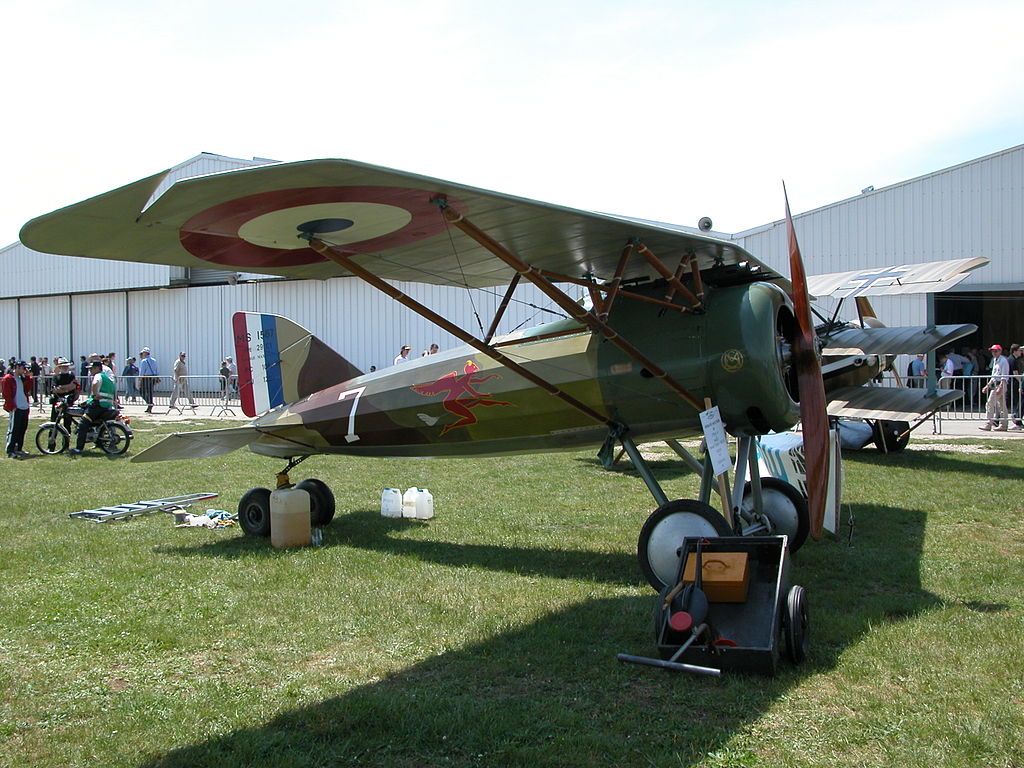
Morane AI MoS 27/29/30/30 bis Ferte-Alais Air show 2004
The Type L were the first true fighters of World War I, once fitted with a machine gun firing through the propeller, then reinforced by metal plates to deflect the bullets, a system invented by Roland Garros, one of the first French Aces. A Type N was also modified with the same system, waiting for a synchronization system. Garros Type L however crashed behind German lines and was examined by Fokker, which would produce later the famous Eindecker.
Models
As usual, production models are in bold letters, with production figures in brackets.
- Morane-Saulnier A 1911 sport planes series (20?)
- Morane-Saulnier B 1912 sport plane
- Morane-Saulnier G 1912 sports planes (30?)
- Morane-Saulnier H 1913 sport/scout (100?)
- Morane-Saulnier L/LA 1914 scout (600)
- Morane-Saulnier P 1914 fighter (595)
- Morane-Saulnier S/T 1914 (60) bomber
- Morane-Saulnier N 1915 fighter (49)
- Morane-Saulnier AR 1915 (400) trainer
- Morane-Saulnier BB 1915 (107) trainer
- Morane-Saulnier I 1916 fighter (4)
- Morane-Saulnier AC 1916 (32) fighter
- Morane-Saulnier V 1916/17 fighter (30)
- Morane-Saulnier AF 1917 fighter prototype
- Morane-Saulnier AI 1917 (1210) fighter
- Morane-Saulnier AN 1918 heavy fighter prototype
 Nieuport
Nieuport
France’s main fighter maker
Nieuport, from Edouard Nieuport(1875–1911) was arguably, before the arrival of the SPADs and UK’s major models from Sopwith and RAF, the main entente fighter. Propelled by rotating Gnome engines, these sesquiplan were built by the thousands, were flawn by all aviations, and spawn the first aces. It all started from a engine part manufacturer, Nieuport-Duplex in 1902. Reformed in 1909, it became the Société Générale d’Aéro-locomotion, and started to produce aviation engine parts like ignition systems, and soon started to work on a first fully-fledged aircraft, a small single-seat monoplane destroyed after a first flight. The second plane flown at the end of 1909 and was more advanced with its enclosed fuselage and horizontal tail balancing the weight of the engine ahead of the center of gravity, an original solution contrary to the Blériot XI.
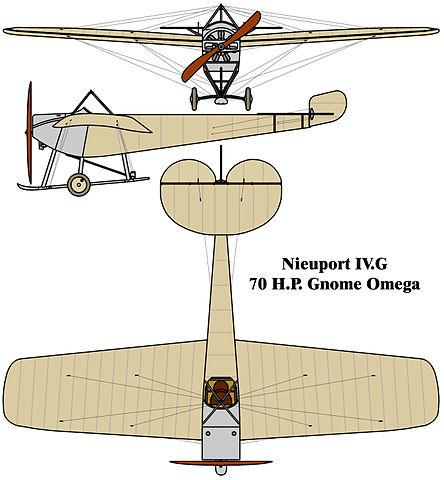 Nieuport did not had the engines it wanted and eventually started their own engine line in 1910 with a twin-cylinder horizontally-opposed engine which produced 28 hp (21 kW) the Nieuport II used. The next year in 1911, the company started to build complete aircrafts aside its components production and propellers (Deplante) and the next year as Edouard Nieuport died in flight, the company was managed by Henri Deutsch de la Meurthe, a rich and famous supporter of early aviation and racing. The company became the Société Anonyme des Établissements Nieuport and the second of the brothers, Charles Nieuport, died in another accident in 1912, the chief designer became the Swiss Franz Schneider which would join later in 1913 German L.V.G. and work with Anthony Fokker, creating the famous synchronizer that changed aerial combat.
Nieuport did not had the engines it wanted and eventually started their own engine line in 1910 with a twin-cylinder horizontally-opposed engine which produced 28 hp (21 kW) the Nieuport II used. The next year in 1911, the company started to build complete aircrafts aside its components production and propellers (Deplante) and the next year as Edouard Nieuport died in flight, the company was managed by Henri Deutsch de la Meurthe, a rich and famous supporter of early aviation and racing. The company became the Société Anonyme des Établissements Nieuport and the second of the brothers, Charles Nieuport, died in another accident in 1912, the chief designer became the Swiss Franz Schneider which would join later in 1913 German L.V.G. and work with Anthony Fokker, creating the famous synchronizer that changed aerial combat.
Nieuport 11 baby displayed at the Musée de l’Air in France
Gustave Delage in turn became Nieuport’s new chief designer in January 1914, working on a sesquiplane racer biplane with a specific top wing. Not really fit for production when WW1 broke out, the model was refined into the Nieuport 10 which saw extensive service with the French, Russian aviations and the Royal Naval Air Service (R.N.A.S.). The Nieuport 10 was quickly replaced by the more powerful Nieuport 12, which served with the Royal Flying Corps (R.F.C.) as fighters. The Nieuport 11 “baby” was based on the Nieuport 10 and was both smaller and more agile. The next models would evolve in gradual improvements culminating with the Nieuport 27. “V-strut” sesquiplane wing shape required careful handling with a power that almost doubled over time, and there was the risk of structural failures. In April 1917 the last Nieuport was found already outclassed by the Albatros D.III and delays meant Nieuport 27s were only available in the spring of 1918. Many of these in French and American service were found reclassed as advanced trainers in flying schools until the end of the war. Pilots like Albert Ball and Charles Nungesser adored the Nieuport for its agility and very sensitive controls. Eddie Rickenbacker and Billy Bishop also used the Nieuport in their early career.
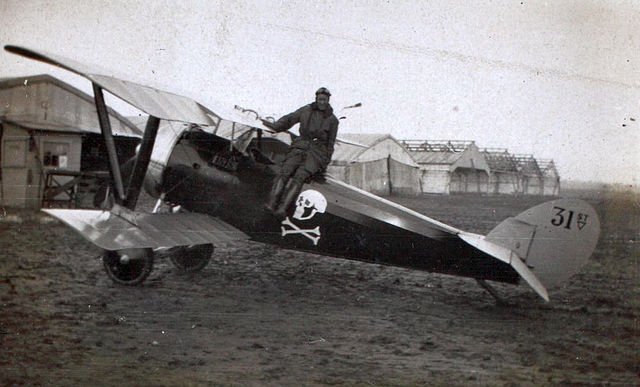
Nieuport 27 trainer of the 31st Aero squadron.
The Nieuport 28 was a completely new design with two spars on the upper and lower wings and was at last sturdy enough for its engines. Unfortunately it arrived when the French had already made their mind and chosed the SPAD S.XIII. Only shortage of the SPAD drove fighter squadrons of the United States Army Air Service (USAAS) to operate the Nieuport 28 instead, first fighter to be used on operations by an American squadron. Nieuports were also built under licence in Italy, Russia and the UK (William Beardmore of Scotland).
Models
As usual, production models are in bold letters (military only), with production figures in brackets.
- Nieuport I 1910 pod and boom tractor monoplane
- Nieuport II 1910 sport/racing monoplane
- Nieuport III 1911 sport/racing monoplane
- Nieuport IV 1911 two-seat sport/racing monoplane.
- Nieuport VI 1912 three-seat sport monoplane (French Navy, RNAS)
- Nieuport VIII 1913 two-seat sport monoplane
- Nieuport X 1913 three-seat monoplane (French Navy)
- Nieuport XI prototype single-seat sport monoplane
- Nieuport XIII prototype armoured monoplane
- Nieuport-Dunne tailless biplane prototype 1913
- Nieuport-Astra Carton-Pate military twin-boom floatplane 1915
- Nieuport 9 (Russian Nieuport 10)
- Nieuport 10 sesquiplane 1915 (2000?)
- Nieuport 83 trainer version (Nieuport 10) 1915 (?)
- Nieuport 11 sesquiplane fighter 1916 (7200)
- Nieuport 12 two-seat artillery spotting sesquiplane 1915 (300)
- Nieuport 80/81 trainer Nieuport 12 1915 (?)
- Nieuport 12bis two-seat artillery-spotting sesquiplane 1915 (?)
- Nieuport 13 Modified Nieuport 12 1915 (2)
- Nieuport 14 two-seat reconnaissance sesquiplane 1915 (100)
- Nieuport 82: Nieuport 14 trainer 1915 (?)
- Nieuport 15 sesquiplane bomber 1916 (4)
- Nieuport 16 fighter (mod. Nieuport 11) 1916 (3000?)
- Nieuport 17/17 bis fighter 1916 (3600)
- Nieuport 18 twin-engine sesquiplane bomber 1916 (?)
- Nieuport 19 twin-engine sesquiplane bomber prototype
- Nieuport 20: Nieuport 12 development 1916 (21)
- Nieuport 21: Light weight fighter mod. Nieuport 17 1916 (300+)
- Nieuport 23 Mod. Nieuport 17 with Vickers MG (?)
- Nieuport 24 Mod. Nieuport 17 with new fuselage and empennage. (?)
- Nieuport 24bis same retrofitted with Nieuport 17 rudder and tail (?)
- Nieuport 25 with larger Clerget engine 1917 (small prod.)
- Nieuport 26 prototype (Hispano-Suiza 8A engine).
- Nieuport 27 1917 mod. Nieuport 24 fighter (1000)
- Nieuport 28 biplane fighter US Expeditionary Forces Air Service (300)
 Ponnier
Ponnier
Ponnier, From the race to the air force
The Ponnier company raised from the needs to win a prestigious race, the Gordon Bennett Trophy in 1913. Gordon Bennett was the American owner and publisher of the New York Herald. This airplane racing even was launched for the first time in 1909 and quickly establish as the #1 aircraft race, before the start of the arguably equally successful Schneider trophy, which awarded floatplanes. This race awarded the fastest time over a measured distance (time trial). In 1911 René Hanriot recruited Alfred Pagny, formerly a designer at Nieuport, to present a winner at the Concours Militaire, but failed. Hanriot soon turned to another business but sold the blueprints to a designer of his team, Louis Alfred Ponnier, which created his own workshop. The latter soon presented a plane to compete in the Race, after two other monoplanes, with boat-like shell fuselages, flat sided, deep chested and all designed by Pagny.
Ponnier D.III (1913)
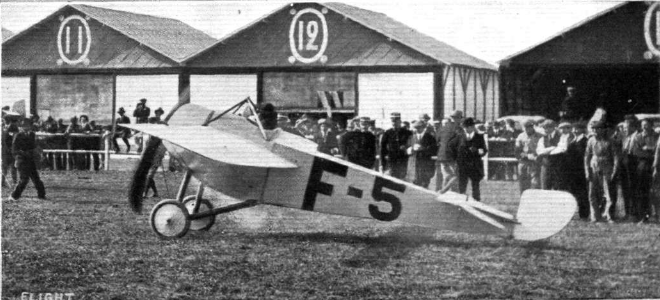 The Ponnier D.III was a single seat, mid wing monoplane, with landing wires both sides attached over the fuselage (pyramidal pylon). Other flying wires went to the lower fuselage. There was also an oil deflecting cowling ejecting downwards, and the plane was propelled by the powerful double row, fourteen cylinder Gnome Lambda-Lambda rotary engine. It was capable of 160 hp (119 kW), connected to a 2 m diameter propeller. There was an open cockpit, mid-wing aft of the pylon centre, a finless rudder and a straight edged tailplane ahead (upper fuselage). The elevators were interconnected and controlled by central wires. The undercarriage was standard with cross-braced V-struts and a simple elliptical leaf spring tailskid.However Jane’s 2013 edition made a mention about an Hanriot D.III fitted with a 100 hp rotary Gnome, which was about 6.65 m (21 ft 10 in). The Ponnier D.III was 5.41 m (17 ft 9 in) by 7.16 m (23 ft 6 in) in wingspan with a 8.7 m2 (94 sq ft) area, and gross weight: 500 kg (1,102 lb). It was capable of 200 km/h (124 mph; 108 kn), competed in the 1913 edition, but ended second, piloted by Emile Védrines, at 60 min 51.4 s flight time for 198 km/h (123 mph) top speed again three Deperdussin monocoque. Despite the obvious advantages of the design for military purposes, the D.III only served as a basis for future designs.
The Ponnier D.III was a single seat, mid wing monoplane, with landing wires both sides attached over the fuselage (pyramidal pylon). Other flying wires went to the lower fuselage. There was also an oil deflecting cowling ejecting downwards, and the plane was propelled by the powerful double row, fourteen cylinder Gnome Lambda-Lambda rotary engine. It was capable of 160 hp (119 kW), connected to a 2 m diameter propeller. There was an open cockpit, mid-wing aft of the pylon centre, a finless rudder and a straight edged tailplane ahead (upper fuselage). The elevators were interconnected and controlled by central wires. The undercarriage was standard with cross-braced V-struts and a simple elliptical leaf spring tailskid.However Jane’s 2013 edition made a mention about an Hanriot D.III fitted with a 100 hp rotary Gnome, which was about 6.65 m (21 ft 10 in). The Ponnier D.III was 5.41 m (17 ft 9 in) by 7.16 m (23 ft 6 in) in wingspan with a 8.7 m2 (94 sq ft) area, and gross weight: 500 kg (1,102 lb). It was capable of 200 km/h (124 mph; 108 kn), competed in the 1913 edition, but ended second, piloted by Emile Védrines, at 60 min 51.4 s flight time for 198 km/h (123 mph) top speed again three Deperdussin monocoque. Despite the obvious advantages of the design for military purposes, the D.III only served as a basis for future designs.
Ponnier L.1 (1913)
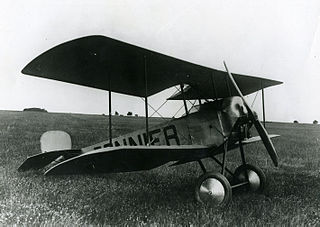 The success of the Sopwith Tabloid, a biplane, at the Schneider Trophy this year led the Army to ask for biplanes only for its own requirements competition. This conducted Alfred Ponnier to devise a specific model to won the “Cavalrie” types competition, the L.1. This was basically a fast conversion of the Ponnier D.III into a biplane, later followed by the M.1. The Ponnier L.1 had a less poerful but more economical and reliable 50 hp (37 kW) Gnome rotary engine, still mounted on tubular steel extensions of the main wooden fuselage. The latter had a rectangular cross section, with four ash longerons interconnected by spruce struts. The forward upper part was covered by aluminium covered ahead of the cockpit. There was also the same oil deflecting cowling mounted on the upper half of the rotary engine. There was no fixed fin but a flat topped rudder and a tailplane mounted on top of the fuselage with separate elevators. The tail surfaces were steel tube structures. As a single bay biplane it was was mild stagger and dihedral, with an airframe using a thick airfoil, straight edged, slightly tapered and square tipped. The top and bottom spans were asymetric. There was also a fixed, conventional undercarriage and a long tailskid, mounted well forward. Despite its merits and a first successful flight circa July 1914, the L.1 was not chosen by the Army.
The success of the Sopwith Tabloid, a biplane, at the Schneider Trophy this year led the Army to ask for biplanes only for its own requirements competition. This conducted Alfred Ponnier to devise a specific model to won the “Cavalrie” types competition, the L.1. This was basically a fast conversion of the Ponnier D.III into a biplane, later followed by the M.1. The Ponnier L.1 had a less poerful but more economical and reliable 50 hp (37 kW) Gnome rotary engine, still mounted on tubular steel extensions of the main wooden fuselage. The latter had a rectangular cross section, with four ash longerons interconnected by spruce struts. The forward upper part was covered by aluminium covered ahead of the cockpit. There was also the same oil deflecting cowling mounted on the upper half of the rotary engine. There was no fixed fin but a flat topped rudder and a tailplane mounted on top of the fuselage with separate elevators. The tail surfaces were steel tube structures. As a single bay biplane it was was mild stagger and dihedral, with an airframe using a thick airfoil, straight edged, slightly tapered and square tipped. The top and bottom spans were asymetric. There was also a fixed, conventional undercarriage and a long tailskid, mounted well forward. Despite its merits and a first successful flight circa July 1914, the L.1 was not chosen by the Army. 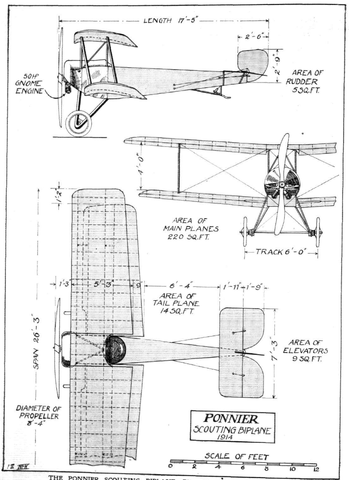
Ponnier M.1 (1914) the production fighter
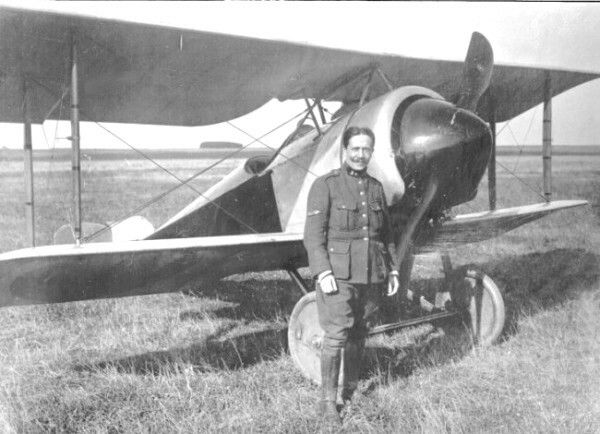
The M.1, was apparently designed not by Pagny but Emile Dupont. The latter would later design the 1916 Hanriot HD.1 fighter. Both planes therefore shared the fact to have been produced and used by the Aéronautique militaire belge (Belgian Air Force), and some design features. This 1915 design was single bay, with a pair of parallel interplane struts braced with flying and landing wires. The wings were almost rectangular, with a small the lower plane and the ailerons were mounted on the upper planes only. This plane was powered by a 80 hp (60 kW) le Rhône 9C nine cylinder rotary engine, fitted with a two blade propeller. It was usually capped by a specific large domed spinner leaving a small gap for cooling. The engine enclosure was cylindrical, and therefore was found aerodynamically sound, but the spinner was later removed. The fuselage was flat sided but with a curved upper decking, tapered aft where the horizontal tail was mounted on top of the fuselage. The rear straight edged tailplane was later scale-up. There were also angle tipped elevators with a wide chord fin and a fixed conventional undercarriage, but no tailskid. The armament consisted in a single Lewis gun mounted above the upper wing surface, out of the propeller’s radius.
After a sucessful first flight in 1915, and despite the loss of a production plane in January 1916, twenty M.1s were produced by the S.A. Française de Constructions Aéronautiques, the company that replaced Avions Ponnier and about 18 or more, were bought by the Aviation Militaire Belge. Famous ace Willy Coppens (which flew the Hanriot) found them ineffective despite later modifications like the larger empennage. The spinner was also removed. They only flew missions until 1917, and were replaced. Apparently the M.2 was designed as a derivative, a slightly larger two-seat version offered to the RFC, never built.
Specifications:
Dimensions: 5.75 m (18 ft 10 in) x 6.18 m (20 ft 3 in)x 2.30 m (7 ft 7 in)
Weight: 304 kg (670 lb), up to 464 kg (1,023 lb)
Engine: Le Rhône 9C 9-cylinder rotary, 60 kW (80 hp), top speed: 167 km/h (104 mph; 90 kn) climb 4.67 min to 1,000 m (3,280 ft)
Armament: 1× 7.7 mm (0.303 in) Lewis machine gun (upper wing)
 Salmson
Salmson
Cars, Engines and Aircraft
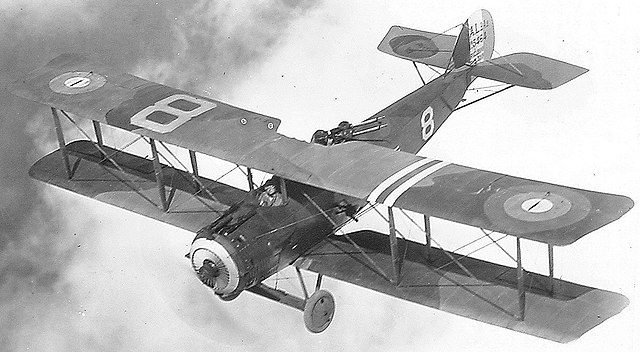
The company was funded by Émile Salmson (born 1858) as Salmson, Ing. workshop in Paris in 1890 creating steam-powered compressors and centrifugal pumps destined for the railway industry before turning to the military. Engineers George Canton and George Unné joined in for engines, and from 1896, the company became Emile Salmson & Cie, creating petrol-powered lifts and motors for various uses. Soon, the company turned to purpose-built aircraft engines, being probably the first to do so. Salmson produced entire planes and then turned after the war, converting to automotive, producing cars at the same time powerful and of luxury standard, with renowned coach-builders, before turning into Grand Tourism, until 1957, but it went back to pump production in Mayenne in 1961 but was absorbed later by Thomson in 1976.
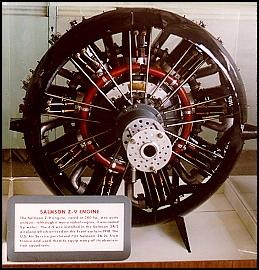 Aircraft production moved at Billancourt (near Renault Factories), starting work on the Salmson 9 series air and water cooled radial engines. The Salmson 2A2 becam the first complete aircraft of the Company during the war, a reconnaissance and heavy fighter plane used by both the French and the American Expeditionary force. A single seat scout/fighter prototype called the Salmson 3 was also built, followed by a reduced production. After a while, the production was moved to Villeurbanne, Lyon. It’s on a Salmson that Maryse Bastié flew Le Bourget to Moscow, establishing a new record in 1931.
Aircraft production moved at Billancourt (near Renault Factories), starting work on the Salmson 9 series air and water cooled radial engines. The Salmson 2A2 becam the first complete aircraft of the Company during the war, a reconnaissance and heavy fighter plane used by both the French and the American Expeditionary force. A single seat scout/fighter prototype called the Salmson 3 was also built, followed by a reduced production. After a while, the production was moved to Villeurbanne, Lyon. It’s on a Salmson that Maryse Bastié flew Le Bourget to Moscow, establishing a new record in 1931.

Model kit of the 1 A.2 from myzone59.com
Models
- Salmson-Moineau A92H (1915) prototype
- Salmson-Moineau S.M.1 1916 (ca.155)
- Salmson-Moineau S.M.2 1916 prototype
- Salmson 1 A.3 (3-seat Artillery Spotter) 1916 (200?)
- Salmson 2 A.2 (2-seat Artillery Spotter) 1917 (3,200)
- Salmson 3 C.1 (Single-seat fighter) (1917) Prototype
- Salmson 4 Ab.2 (ground attack aircraft) 1918 (50?)
- Salmson 5 A.2 (modified Salmson 2 for A2 role prototype)
- Salmson 6 A.2 (2 seat artillery spotter) prototype
- Salmson 7 A.2 (2-seat Artillery Spotter) prototype
Salmson-Moineau SM.1
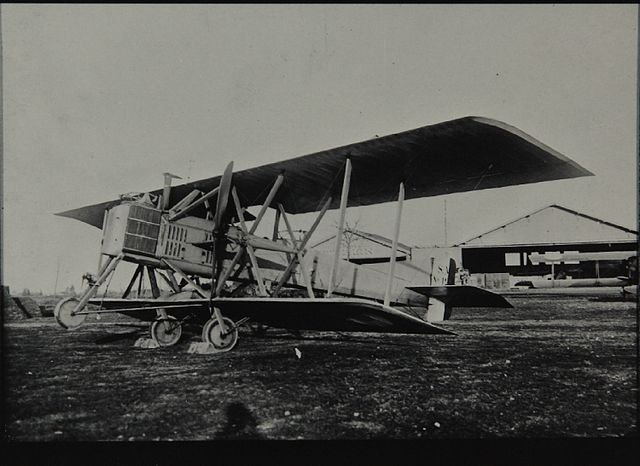
The S.M.1 A3 was created from 1915 for the French military A3 specification, asking for a three seats, long range reconnaissance aircraft well armed. This model was named after Salmson and Moineau and became the first mass-production of the company. It was unconventional and powered by a single Salmson 9A liquid-cooled radial engine. This powerplant was located in the fuselage, but powered two propellers mounted between the wings thanks to a system of gears and drive shafts. The absence of external engine allowed to reduced drag and at the same time the engine was easy to access a manage in case of a problem. This twin-screw also gave a wide field of fire for the two gunner-observers. One was located in the nose and the other behind the pilot. They operated ring-mounted flexible 37 mm APX (Puteaux) cannons, quite a heavy proposition for defence indeed. A boxy fuselage was mounted through a struts structure between equal span wings. The undercarriage comprised a nose wheel in case of a nose over when landing and a classic rear tail skid.
The S.M.1 passed its trials in early 1916, receiving an order for 100 despite performances below to the Sopwith 1½ Strutter also already in service in the French aviation. This plane was quite problematic in service, with collapsing undercarriage if misused while the complicated external transmission system (also used by German bombers) proved difficult to maintain and subjected to reliability issues in the field, with degraded performance. Despite of this, production passed the initial order and run for another 55 S.M.1s, withdrawn from service in 1917, while a few survived in second line until late 1918. The Imperial Russian Air Service was the only other known user of the type, but they were not happy with it either.
A single prototype was fitted with a Canton-Unne P.9 engine while the S.M.2 S2 prototype showcased an additional Salmson 9A engine in the nose, tested but not kept because of poor engine cooling in 1918. It was conceived in the ground attack role, with extended upper wings with additional bracing and a reinforced undercarriage.
 SPAD
SPAD
Société pour l’aviation et ses dérivés (SPAD): The Fighter fabrique
The Société pour l’aviation et ses dérivés ancestor company was in 1911 the Aéroplanes Deperdussin, renamed Société de Production des Aéroplanes Deperdussin a year after. Armand Deperdussin once a travelling salesman, cabaret singer from Belgium became millionaire in the silk business. Now with the funds and fascinated by aviation since the large mediatic exhibitions of 1908, he established a small aircraft works at Laon in 1909. Not a designer he hired Louis Béchereau (born 1880), which became his technical director and designed Deperdussin but also the following SPAD fighter designs, probably the most successful and most produced French Fighter during WW1.
If the first Deperdussin had an average canard configuration, the next Type A monoplane was an instant success, leading to a series of derivatives which were quite successful at export. The most common model emulated both the Blériot XI and Nieuport IV and became popular with the military before the war. The Deperdussin TT in articular sold well, to Russia (63 licence-built by Lebedev) and UK (Highgate factory) in particular. In 1911 Deperdussin inaugurated a new plant at Grenelle (Paris) and met success again with the Deperdussin Monocoque, while other establishements were created at Le Havre and Juvisy for motor boats and floatplanes, plus three flying schools to train future pilots on Deperdussin monoplanes.
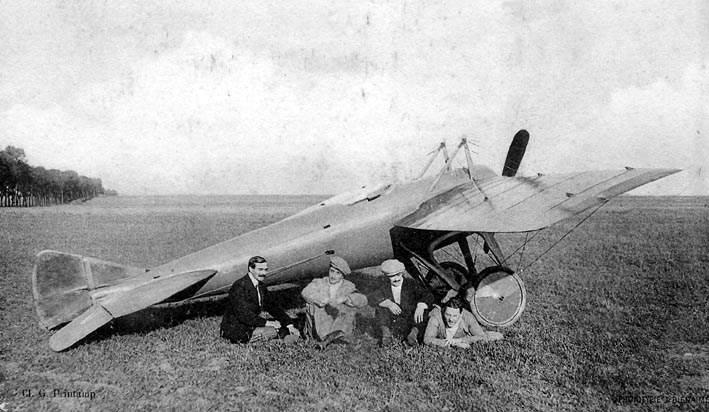
The Deperdussin Monocoque was one of the most successful racer in the world by 1912
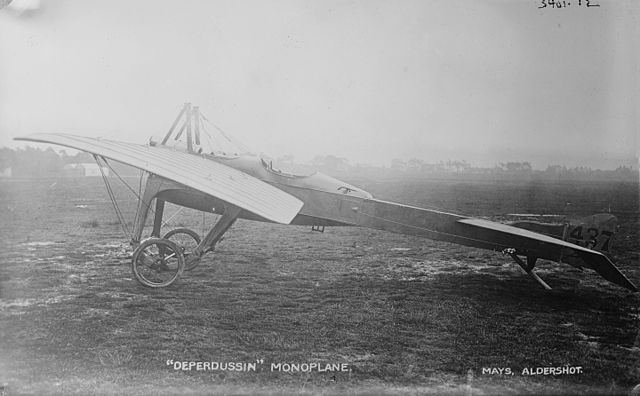
The Deperdussin TT was in 1912 a successful fighter, also adopted by UK, Russia, Belgium, Spain, Portugal, Thailand, Paraguay, Serbia and Turkey
Being well profile and powerful, thes monoplanes were quite fast and became prized sports and record planes, like the groundbreaking Deperdussin Monocoque, winner of the 1912 and 1913 Gordon Bennett Trophy races. It was the first plane worldwide to exceed 200 km/h (120 mph), setting many other records. The derived Deperdussin floatplane took by storm also the first Schneider Trophy competition in 1913 held at Monaco at 45.75 mph (about 73 km/h) lap time. However Armand Deperdussin only known a high living style which led him to be arrested on charges of fraud which went back to its activities with silk trade through the trading arm of the Comptoir Industrial et Colonial bank.
He was maintained in jail and brought to trial in 1917 and sentenced to five years in prison, but was released because of his contribution to French Aviation, and later committed suicide in 1924. Meanwhile, his company had been in bankruptcy in 1913, and was run by state administration from then on as “Société Provisoire des Aéroplanes Deperdussin”, and later purchased as part of a consortium led by Louis Blériot. It was renamed Société Pour L’Aviation et ses Dérivés to erase all mention of Deperdussin, later known under the acronym “SPAD”.
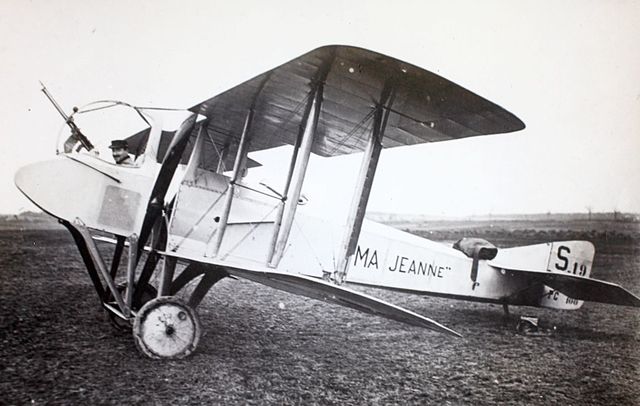
The SPAD S.A-2 was a transitional fighter before the synchronizer arrived. The gunner was dangerously seated in front of the propeller.
Genius designer Louis gave his name to these first models called Béchereau-SPAD designs. He attempted to built two-seat biplanes with a forward-firing machine gun, right in front of the tractor propeller. The pilot sat behind the propeller and was fine, but not the unfortunate seated in the nacelle/pulpit dangerously close to the propeller. The SPAD A-series was produced nevertheless and declined into the A.1, A.2 A.3, and A.4 (60 each for France and Russia) but soon condemned by the introduction of the synchronization device, and forgotten.
Next he designed a large twin-engine biplane bomber, called SPAD E, which did well on trials but was already overshadowed by Béchereau’s next design, the S.VII. This legendary model which was a scaled down monoplace A.2 with a standard configuration was a development of the earlier SPAD V already produced to 268 planes. the SPAD S.VII was fast, simple and robust, well helped by its inline, liquid cooled, state of the art Hispano-Suiza V-8 engine. Although in 1916 pilots did not like its heavy handling and lack of agility (especially compared to the Nieuports), they soon adored its speed and great sturdiness and took advantage of these in combat. In fact 3,500 S.VIIs were manufactured in France only, but also 120 in UK and 100 in Russia. In fact a new factory has been established in Yaroslavl to delivered hundreds more, which remained unfinished when the revolution broke out.
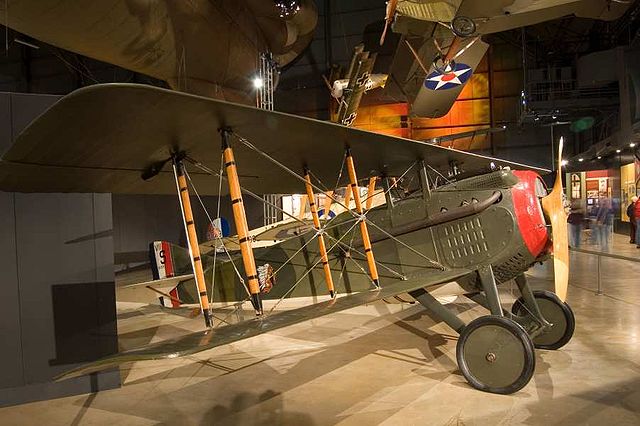
The S.VII was the first mass-produced successful fighter made by SPAD. Lacking agility, it was very fast and sturdy.
Next, SPAD tried again the two-seater formula with the SPAD XI and SPAD XVI. About 1,000 of each were delivered but they never imposed themselves when compared to the Breguet 14 or and Salmson 2. The next Bécherau’s fighter was the SPAD XII. It was to be fitted at first by the new geared Hispano-Suiza V-8 engine allowing to fire a 37 mm Hotchkiss cannon through the propeller hub. Georges Guynemer tested it but agreed on its formidable potential but also that it could only be given to the most skillful pilots at hand. Of the 300 ordered, many ended converted as regular SPAD fighters indeed.
At least one American pilot flew this gun armed SPAD, Charles J. Biddle while from the USAAS’ 13th Aero Squadron. The next SPAD S.XIII was a SPAD S.VII fitted with a geared drive Hispano-Suiza engine and about 7,300 to 8,472 according to sources were delivered and flown by many aces. In Italy, it was flown by Count Francesco Baracca (36 confirmed victories) which left his personal prancing horse emblem on the fuselage (“cavallino rampante”) later to be adopted by an admirative young race pilot after the war, funded by Baracca, Enzo Ferrari. But that’s another story…
United States Army Air Service’s Captain Eddie Rickenbacker also adored the SPAD (26 victories) and Georges Guynemer, France’s preferred ace, which also flown all the other models. In 1918, the SPAD XIII was American main frontline fighter, with 900 on hands. despite this success, profits due to large industrial syndicates competing for contracts had fallen to 43% but Louis Blériot purchased became quite profitable in the end. After the war, the company still produced good fighters under the name “Bleriot-Spad”. One model, the elegant Blériot-Spad 510 biplane of 1933, was still in service in regional air forces and metropolitan reserve squadrons during the battle of France.
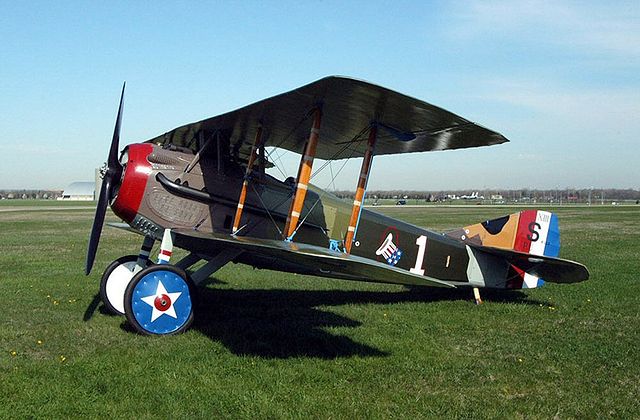 The legendary S.XIII was largely used by the allies, American forces comprised (like here)
The legendary S.XIII was largely used by the allies, American forces comprised (like here)
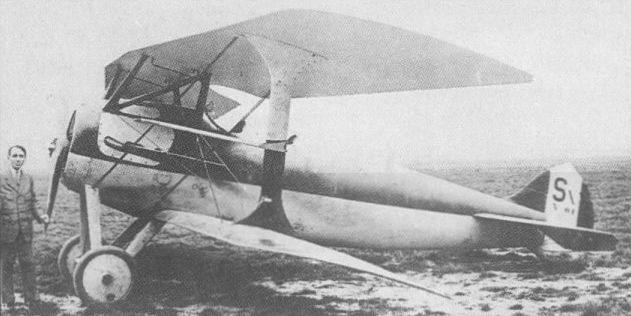 The S.XX was the fastest fighter in production when the war close to an end. Only a handful were delivered before the armistice.
The S.XX was the fastest fighter in production when the war close to an end. Only a handful were delivered before the armistice.
Types
- Deperdussin A/B/C 1910 sport monoplane series
- Deperdussin 1912 Racing Monoplane series
- Deperdussin Monocoque, racing monoplane series
- Deperdussin T racer prototype
- Deperdussin TT fighter 1912 (400?)
- British Deperdussin Seagull prototype 1913
- SPAD S.A 1915 (240)
- SPAD S.G1/G2, S.A2 based 1915 reconnaissance prototypes
- SPAD S.V fighter prototype 1916
- SPAD S.VII fighter 1916 (6000)
- SPAD S.XI 2 seats reconnaissance 1916 (1000)
- SPAD S.XII canon fighter 1916 (?300)
- SPAD S.XIII/XVII fighter 1917 (8500)
- SPAD S.XIV seaplane fighter 1918 (40)
- SPAD S.XVI seats reconnaissance 1917 (?1000)
- SPAD S.XX fighter 1918 (100, other cancelled)
 Voisin
Voisin
The Voisin brothers, European pioneers
The company founded by brother Charles and Gabriel Voisin was one of the most prolific manufacturer worldwide in 1914. Their expertise was not usurpated: It started in the early days of aviation, with the 1908 craze following the Wright Brother homologated flight. The compay was indeed created in 1906 by Gabriel Voisin, after acquiring the assets of Bleriot, and created Europe’s first manned, heavier-than-air powered aircraft, capable of one kilometer of circular controlled flight. Planes became success and took a durable foothold in UK as well. The company turned to observation, training planes, then bombers for the duration of the war. The most famous was the Voisin III, but the lineage went up to the Voisin XII, a four-engine night bomber of 1918. After the war, Gabriel converted to sport and luxury cars which original style made quite an impression in the 1920s.
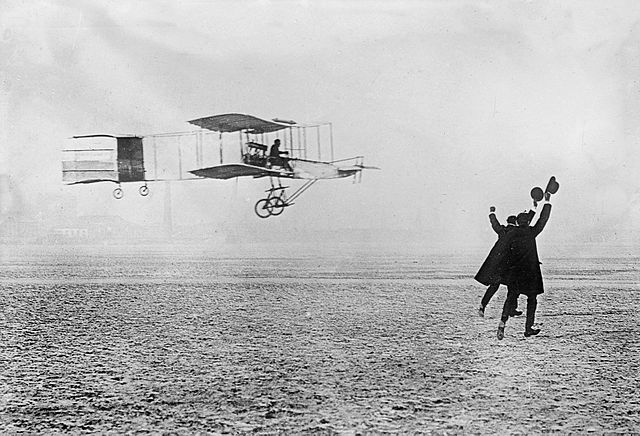
Henri Farman winning the Archdeacon Prize for the first closed-circuit kilometer flight in Europe
Development of Voisin models
The 1907 Voisin biplane, a cabane-type model pusher with front model with rear tails, largely influenced by Wright designs (about 70 produced), succeeded the 1909 Voisin Tractor, a prototype. Meanwhile production of the 1907 model went on, under names such as Delagrange I, or Farman I in the early days. Many modifications were made thanks to regular feedback by the buyers and numerous competitions and exhibitions. Farman had ended his collaboration with the Voisins in 1909.
These planes were exported far and wide, in Europe and beyond. Captain Ferber, which had considerable influence on the development of aviation died in a Voisin and Louis Paulhan was the first to fly propelled by a Gnome Omega rotary engine. Harry Houdini also purchased one to fly over Australia. The 1910 Voisin Type de Course was designed by Gabriel Voisin as a racing aircraft, a two-seater, two-bay pusher biplane identified by its elevator mounted on the upcurved front of the nacelle, plus rear-mounted empennage.
It was smaller and had shorter wing area, and was very stiff, thanks to making extensive use of metal. Two were built and extensively tested. The 1910 Voisin Type Militaire was the first army model, was an adaptation of the 1909 model with a machine-gun or light cannon in the front gondola. It was biplane with a pusher configuration but few photos exists of it. Another interesting model was the one-off competition biplane called Voisin Type Bordeaux. It was indeed purchased by Juan Bielovucic to attempt a flight from Paris to Bordeaux. It was the first model without a forward-mounted elevator. But it was still a two-bay pusher with a Gnome Omega 7 cylinder rotary engine, and made the flight, in four stages, about 540 km (340 mi) breaking numbers of records and making him a celebrity.
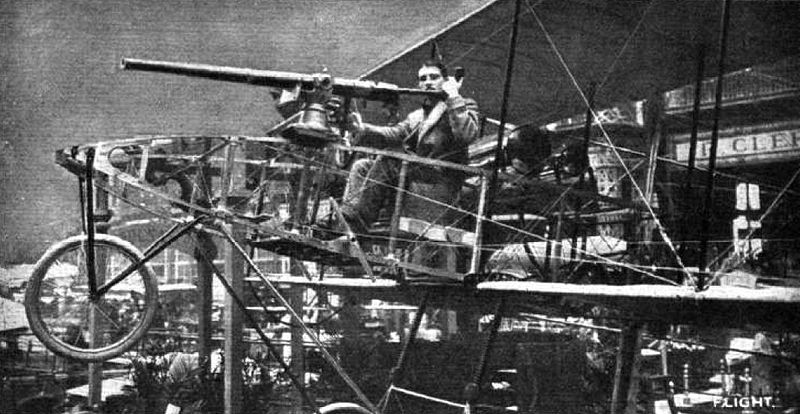
Voisin 1910 Type Militaire, with an alleged machine-gun but this more resembles a 37mm quick-firing gun.
The 1911 Voisin Canard was an evolution of the design, with a single enclosed fuselage and tail, reminiscent of Alberto Santos-Dumont’s 14-bis. It was initially flown as a landplane but later fitted with floats. It has characteristic side-curtains placed on the outermost pair of interplane struts, and trailing-edge ailerons on both wings. Two examples were sold to the French Navy and to Russia. The French seaplanes were used for reconnaissance tests from the converted cruiser La Foudre and was redesigned and adapted by Henri Fabre, a seaplane pioneer. The second prototype was propelled by a 97 kW (130 hp) Gnome engine. It was delivered in December 1912 to the French Navy.
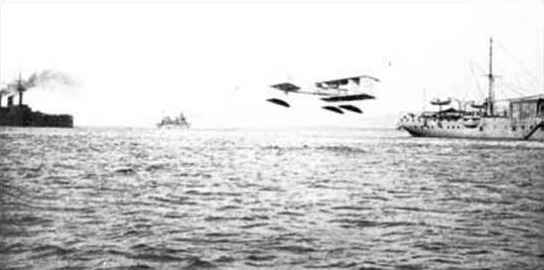
The 1911 Voisin canard served with the French Navy, from the first seaplane carrier, taking part in exercizes in 1912.
The 1911 Type Tourism is quite a foggy model with few informations available. However the next 1912 Type Monaco is better known. It was a smaller version of the Canard floatplane, of which two built to take part in the 1912 Monaco Aero Meeting. The 1912 Voisin Icare Aero-Yacht was a strange flying boat made for Henry Deutsch de la Meurthe. The wings and booms were mounted on a frame that rested on a Ricochet motorboat hull, itself was resting on three axles for large landing wheels in land configuration and propelled by a 200 hp (150 kW) Clerget engine in pusher configuration. It looked like a brick, but actually flew, on 23 November 1912 at Issy-les-Moulineaux, what’s more, with six passengers.
It could be fitted with machine-guns in military configuration. At last the 1912 Voisin Type L, also Voisin Type I was a production model made for the army. About 70 were made, and some were also sold to Russia. This pusher biplane launched a configuration that was to last until 1916 at least. Voisin philosophy was relatively conservative indeed, only pushing for small incremental design changes in the airframes in particular. The Type L was still used for training in 1914 but was quickly obsolete. It passed many tests with success and established the standard Voisin format, with larger wings spans and more powerful engines as the models were gradually converted as bombers.
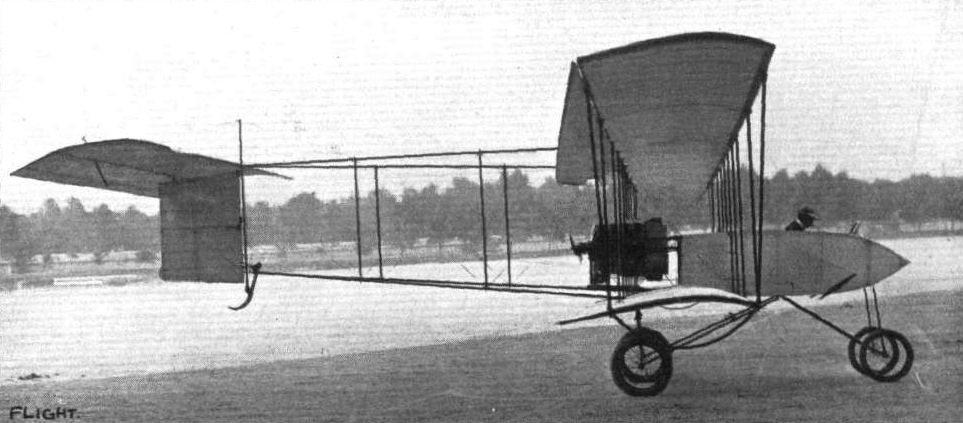
The 1911 Voisin Type L Militaire or Voisin Type I served with the French Army until 1914 as a trainer/observation plane.
Wartime Voisin types
Here are following the mass-produced models seen more in detail below. The next 1914 Type LA or Voisin Type III (There are no mentions of a Type II, which probably remained on paper only), became the main Voisin type in production for the Army, and served in large quantities until 1916. Production of this Type increased slowly after the outbreak of the First World War. Indeed Voisin was slow to organize its production for more deliveries, preferring quality over quantity. The Voisin III was followed by the Type LB/Type LBS respectively designated Voisin IV and Voisin V aircraft for the Army. The Voisin VII appeared in 1916, and a hundred were built, as it was seen as largely obsolete in its configuration. Success returned with the Type LBP, or Voisin VIII, a very successful night bomber. It became the main type in use for this task for the French until 1917, with more than a thousand built.
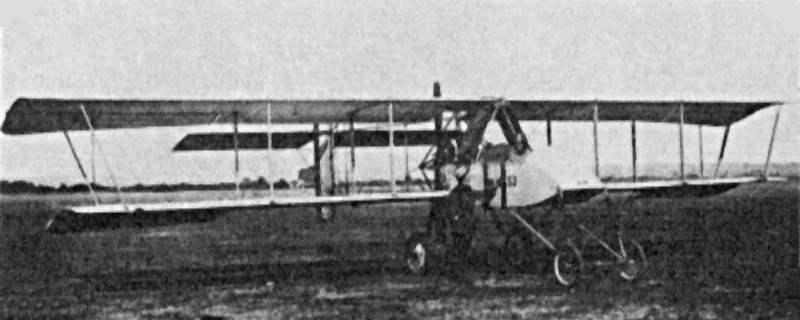
Voisin Type LA bomber or Type III
Voisin tried the multipurpose light bomber/reconnaissance type with the Type LC or Voisin IX, but it lost the competition when facing the more modern Salmson 2 and Breguet 14. The next Voisin X was a reboot of the VIII with more reliable and cheaper production engines from Renault instead of the Peugeot models used until then. However production was delayed to the point production reached 900 planes at the end of the war.
At last, the massive Voisin XII, which made successful in trials in 1918, was a pusher/tractor four-engine night bomber which looked both modern and elegant, but arrived too late to be ordered in numbers. Voisin also created an interesting derivative of its model X: It was the first flying ambulance made for any army. The single Voisin ‘Aerochir’ was capable of carrying a surgeon, an operating table and support equipment like an x-ray machine and autoclave right to battlefield areas and 360 kg of medical equipments under its wings. Although conservative, Voisin also tried once a triplane configuration for a bomber (see below).
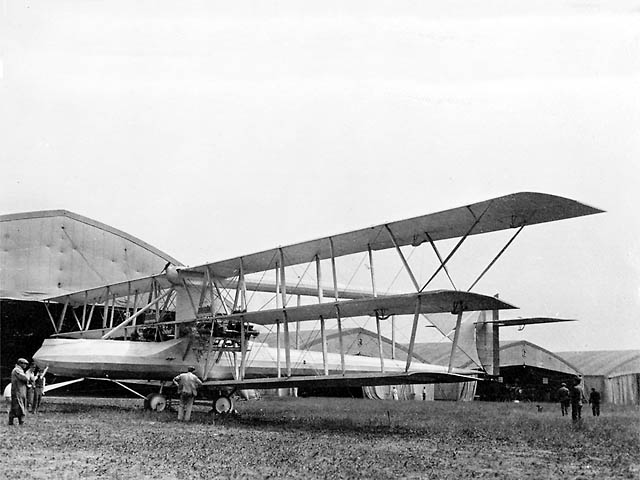
The unique triplane bomber was an experiment of 1915. The first trials failed, and was modified with more powerful Hispano-Suiza engines, fying again in 1916. But results were still unconvincing and it was not ordered in production.
Below are following the production models with the estimated production figures in brackets.
- Voisin Canard 1911 (c10)
- Voisin Type I 1912 (c70)
- Voisin Type III 1914 (c1350+)
- Voisin Type IV 1914 (?)
- Voisin Type VII 1915 (c100)
- Voisin Type VIII 1916 (1000+)
- Voisin Type IX 1916 (Prototypes)
- Voisin Type X 1917 (c900)
- Voisin Type XII 1918 (Prototypes)
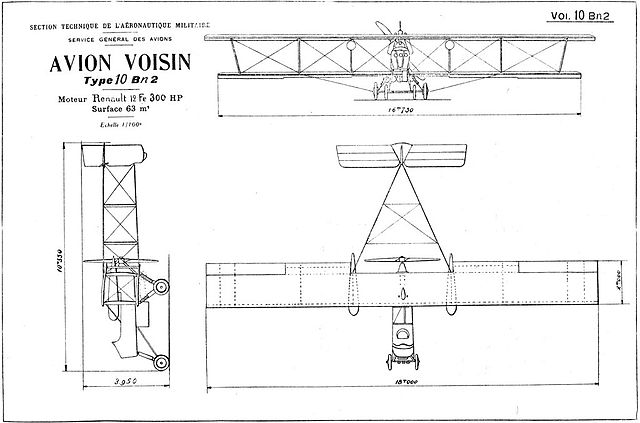
Voisin X blueprint, showing a rather conservative design by 1916 standards
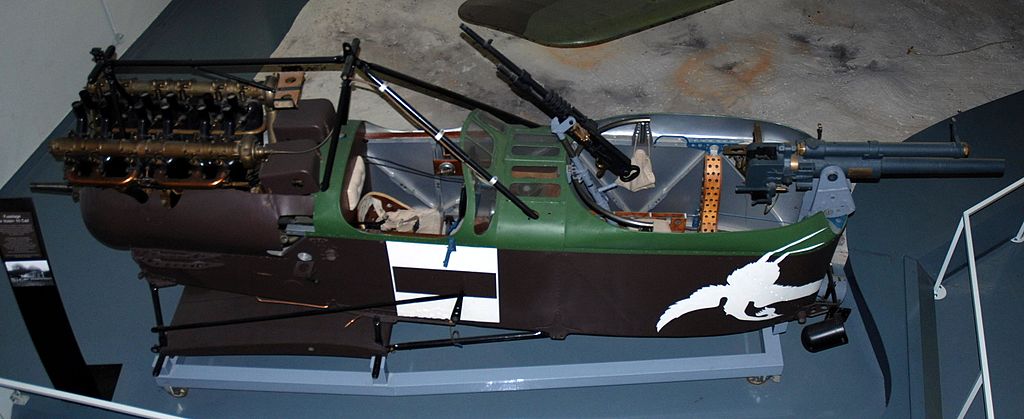
Nacelle of a Voisin X showing its powerful armament, a 37 mm Puteaux QF gun and a Hotchkiss 6.5mm machine-gun on a rear scarf.
 ZODIAC Airships
ZODIAC Airships
From airships to inflatable boats
Best known today for its ancient and large nautic inflatable and rigid boats, the company started in 1896 on the foundation of Mallet, Mélandri and de Pitray at first, by Maurice Mallet and his associates. But the company was the result of the collaboration of Maurice Mallet and Henry de La Vaulx for balloons; The company was made famous even before 1900 for its small airships that could be easily deflated, compacted and transported via horse carts. Most were used by the French Army for observation. Count Henri de la Vaulx could have been the French Count Zeppelin.
An adventurer after reading Jules Verne novels, he lived for some time in Patagonia. Back in France he co-founded the Aero Club of France in 1896, together with other associates, including Verne and his family, together with industrialists André Michelin and Albert de Dion, aviation pioneer Alberto Santos-Dumont and oil businessman Henry Deutsch de la Meurthe, patron of many aviation enterprises. De la Vaulx also set up in 1900 a record of the longest balloon trip, from France to Ukraine, and the next year he 1905 he cofounded and became a director of the Fédération Aéronautique Internationale (FAI) still in charge nowadays of air flight records.
Mauric Mallet on his side created the company to make hot-air balloons for sport and tourism. He renamed the company in 1899 as “Ateliers de Constructions Aéronautiques Maurice Mallet” and prospered due to the numerous orders from the Aero Club of France. He was the driving force behind Zodiac, holding patents for inventions related to dirigibles, and creating large ones (inflatables) for Deutsch de la Meurthe, the “Ville de Paris” and many others. The company was renamed again in 1908 “Société française des ballons dirigeables” and Zodiac (after the astronomical sign) in 1911. During a short period he built until 1913 sixteen dirigibles, for various users, like the Aérostation Maritime (Navy air arm), and the French, Dutch, Belgian and Russian Armies.
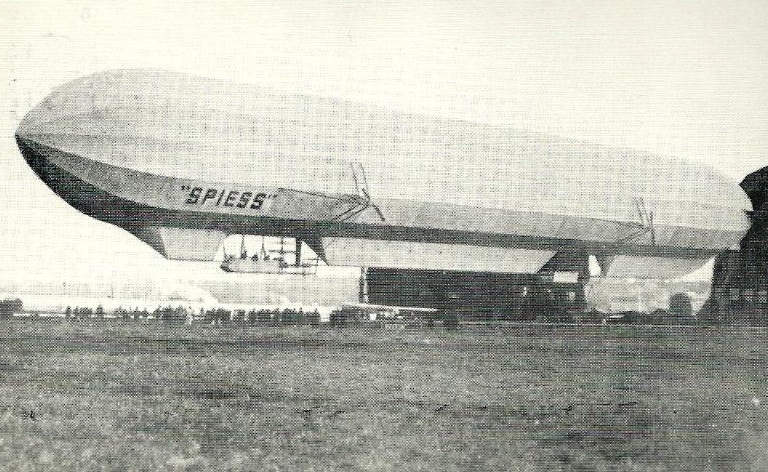
Airship “Spiess”, the only rigid airship ever built by Zodiac. It failed its trials for the Army and there were no succession;
Zodiac Airships
Below are following the list of airships manufactured by the Company. Notice the bold ones are for the Army; The very first one was an Experimental craft, 32.5m long, 6.4m wide, of 730m3 capacity and fitted with a 14hp, able to reach 25kph, named after company co-founder Count Henri de la Vaulx. It was rebuilt as Zodiac II in 1908. The Petit Journal was an Advertising blimp for the Le Petit-Journal. It was rebuilt as Zodiac I in 1908. The second one was also an dvertising blimp with a 900m3 capacity. The Alvis was built for Stuart Davis of The Zodiac Dirigible Airship Company, New York City. It made its trials in July 31, 1910 was 40.8m long by 8.5m in diameter, 1400m3 in capacity, 30 hp and 35kph.
The Zodiac II was a virtual duplicate of it, this time built for Belgian Army. The Zodiac III was larger at 1700 m3 instead of 1400, also for the Belgian army. The only Dutch army dirigible made by Zodiac was the Duindigt, which made its first trials in May 1911, 34.9m long, 6.8m in diameter, 915m3 in capacity, 30hp for 43kph. The two Russian Army dirigibles were identical at 48x10m in size, 2140m3 in capacity, with a 60hp engine and 40 kph. They were called Korchoune and Tchaika and made their trials in the fall of 1910. The only rigid airship built was the Spiess, named after Zodiac’s engineer Joseph Spiess. The Design was originally patented in 1873 but not built due to lack of funding. It was tested in Offered to French Army in May 1913, but failed its trials. Not the largest dirigible by Zodiac, it was 113.0m long by 13.5m, 12800m3 size, 200 hp strong, 50 kph.
The Zodiac II was back to a flexible structure, rebuilt to meet French Army standards and tested in December 1913, but was again rejected as too small. It was 140m by 13.5m in size, 16400m3 capacity, 400 hp and capable of 70hp. The line of French Army dirigibles comprised the first Zodiac (1909), Le Temps (previously a newspaper advertising blimp), Capitaine Ferber and Commandant Coutelle and three 1913 unmanned dirigibles, the fastest ever done, 130 x 15m in size, 23000m3 in capacity, 1000hp strong, 80kph.
- Comte de la Vaulx June (1906), rebuilt Zodiac II 1908
- Petit-Journal (1909) rebuilt as Zodiac I in 1908
- Petit-Journal II (1909) advertising blimp
- Zodiac (1909) French Army
- Davis (1910) Built for Stuart Davis, Zodiac Dirigible Airship Cie NYC.
- Zodiac II (1910) Belgian Army
- Zodiac III (1913) Belgian Army
- Duindigt (1911) Dutch Army
- Tchaika (1910) Russian Army Russian Army
- Korchoune (1910) Russian Army
- Le Temps (1911) French Army
- Capitaine Ferber (1911) French Army
- Commandant Coutelle (1913) French Army
- Spiess (1913) French Army
- Spiess II (1913) French Army
- N°14 1913 Built for French Army
- N°15 1913 Built for French Army
- N°16 1913 Built for French Army
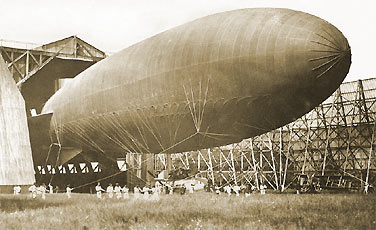
ZD-4 in 1924, out of the Hangar Garnier (scr: aerobase.fr)
Read More
On aviationsmilitaires.net
On militaryfactory.com
http://jn.passieux.free.fr/html/DorandAR1.php
Service Technique de l’Aeronautique
On aviafrance.com
https://fr.wikipedia.org/wiki/Dorand_AR.1
https://en.wikipedia.org/wiki/Dorand_AR
https://en.wikipedia.org/wiki/Farman_Aviation_Works
https://en.wikipedia.org/wiki/Franco-British_Aviation
http://www.msacomputer.com/flyingboats-old/france-FBA/france-FBA.html
https://www.skytamer.com/Hanriot-1910.html
https://en.wikipedia.org/wiki/Salmson
https://en.wikipedia.org/wiki/Salmson_2
https://www.aviationsmilitaires.net/v2/base/view/Model/1690.html
http://www.avionslegendaires.net/avion-militaire/salmson-2a2/
http://fandavion.free.fr/salmson_entreprise.htm
http://www.ctie.monash.edu.au/hargrave/voisin.html
https://en.wikipedia.org/wiki/Voisin
https://airandspace.si.edu/collection-objects/voisin-type-8
http://acepilots.com/wwi/voisin.html
http://aircraft-in-focus.com/voisin/
List of Zodiac Airships
Zodiac Airships (aerobase.fr)

 Latest Facebook Entry -
Latest Facebook Entry -  X(Tweeter) Naval Encyclopedia's deck archive
X(Tweeter) Naval Encyclopedia's deck archive Instagram (@navalencyc)
Instagram (@navalencyc)





 French Navy
French Navy Royal Navy
Royal Navy Russian Navy
Russian Navy Armada Espanola
Armada Espanola Austrian Navy
Austrian Navy K.u.K. Kriegsmarine
K.u.K. Kriegsmarine Dansk Marine
Dansk Marine Nautiko Hellenon
Nautiko Hellenon Koninklije Marine 1870
Koninklije Marine 1870 Marinha do Brasil
Marinha do Brasil Osmanlı Donanması
Osmanlı Donanması Marina Do Peru
Marina Do Peru Marinha do Portugal
Marinha do Portugal Regia Marina 1870
Regia Marina 1870 Nihhon Kaigun 1870
Nihhon Kaigun 1870 Preußische Marine 1870
Preußische Marine 1870 Russkiy Flot 1870
Russkiy Flot 1870 Svenska marinen
Svenska marinen Søværnet
Søværnet Union Navy
Union Navy Confederate Navy
Confederate Navy Armada de Argentina
Armada de Argentina Imperial Chinese Navy
Imperial Chinese Navy Marinha do Portugal
Marinha do Portugal Mexico
Mexico Kaiserliche Marine
Kaiserliche Marine 1898 US Navy
1898 US Navy Sovietskiy Flot
Sovietskiy Flot Royal Canadian Navy
Royal Canadian Navy Royal Australian Navy
Royal Australian Navy RNZN Fleet
RNZN Fleet Chinese Navy 1937
Chinese Navy 1937 Kriegsmarine
Kriegsmarine Chilean Navy
Chilean Navy Danish Navy
Danish Navy Finnish Navy
Finnish Navy Hellenic Navy
Hellenic Navy Polish Navy
Polish Navy Romanian Navy
Romanian Navy Turkish Navy
Turkish Navy Royal Yugoslav Navy
Royal Yugoslav Navy Royal Thai Navy
Royal Thai Navy Minor Navies
Minor Navies Albania
Albania Austria
Austria Belgium
Belgium Columbia
Columbia Costa Rica
Costa Rica Cuba
Cuba Czechoslovakia
Czechoslovakia Dominican Republic
Dominican Republic Haiti
Haiti Hungary
Hungary Honduras
Honduras Estonia
Estonia Iceland
Iceland Eire
Eire Equador
Equador Iran
Iran Iraq
Iraq Latvia
Latvia Liberia
Liberia Lithuania
Lithuania Mandchukuo
Mandchukuo Morocco
Morocco Nicaragua
Nicaragua Persia
Persia San Salvador
San Salvador Sarawak
Sarawak Uruguay
Uruguay Venezuela
Venezuela Zanzibar
Zanzibar Warsaw Pact Navies
Warsaw Pact Navies Bulgaria
Bulgaria Hungary
Hungary

 Bundesmarine
Bundesmarine Dutch Navy
Dutch Navy Hellenic Navy
Hellenic Navy Marina Militare
Marina Militare Yugoslav Navy
Yugoslav Navy Chinese Navy
Chinese Navy Indian Navy
Indian Navy Indonesian Navy
Indonesian Navy JMSDF
JMSDF North Korean Navy
North Korean Navy Pakistani Navy
Pakistani Navy Philippines Navy
Philippines Navy ROKN
ROKN Rep. of Singapore Navy
Rep. of Singapore Navy Taiwanese Navy
Taiwanese Navy IDF Navy
IDF Navy Saudi Navy
Saudi Navy Royal New Zealand Navy
Royal New Zealand Navy Egyptian Navy
Egyptian Navy South African Navy
South African Navy






























 Ukrainian Navy
Ukrainian Navy dbodesign
dbodesign